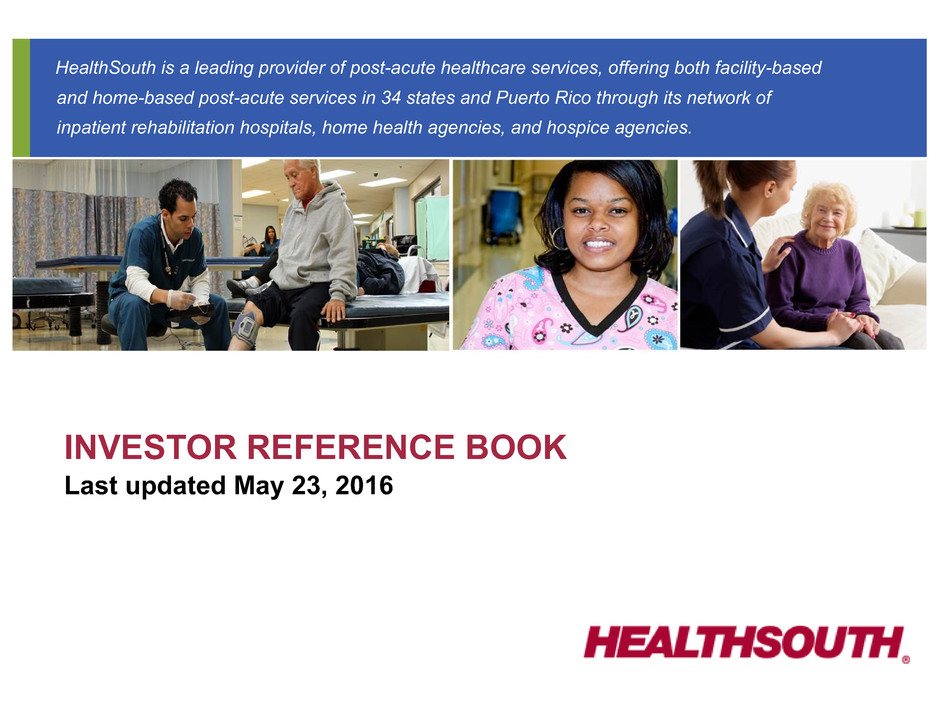
INVESTOR REFERENCE BOOK Last updated May 23, 2016 HealthSouth is a leading provider of post-acute healthcare services, offering both facility-based and home-based post-acute services in 34 states and Puerto Rico through its network of inpatient rehabilitation hospitals, home health agencies, and hospice agencies.
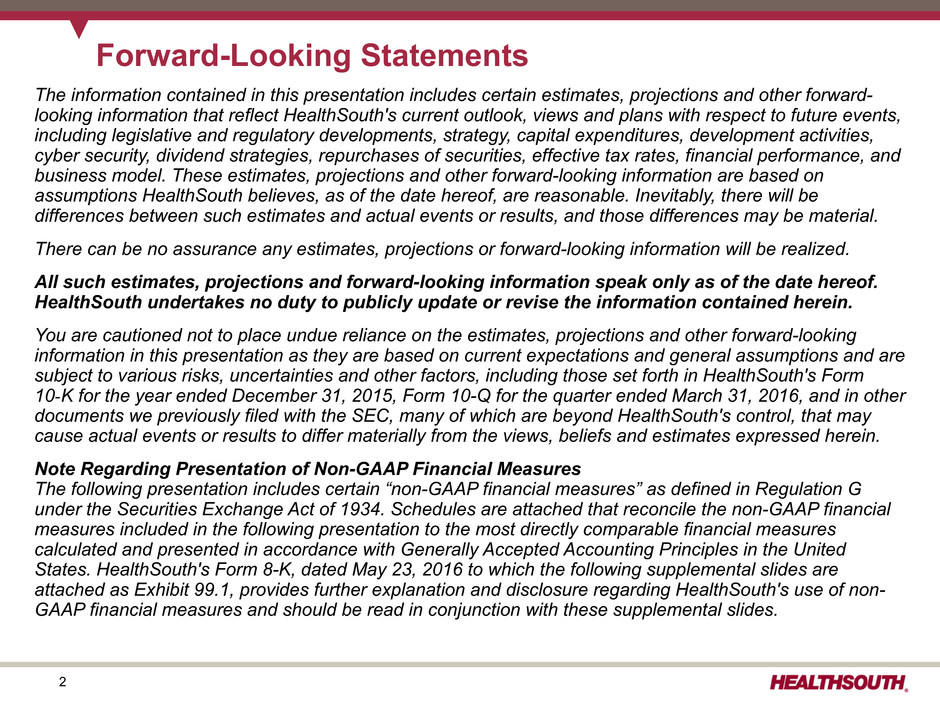
2 The information contained in this presentation includes certain estimates, projections and other forward- looking information that reflect HealthSouth's current outlook, views and plans with respect to future events, including legislative and regulatory developments, strategy, capital expenditures, development activities, cyber security, dividend strategies, repurchases of securities, effective tax rates, financial performance, and business model. These estimates, projections and other forward-looking information are based on assumptions HealthSouth believes, as of the date hereof, are reasonable. Inevitably, there will be differences between such estimates and actual events or results, and those differences may be material. There can be no assurance any estimates, projections or forward-looking information will be realized. All such estimates, projections and forward-looking information speak only as of the date hereof. HealthSouth undertakes no duty to publicly update or revise the information contained herein. You are cautioned not to place undue reliance on the estimates, projections and other forward-looking information in this presentation as they are based on current expectations and general assumptions and are subject to various risks, uncertainties and other factors, including those set forth in HealthSouth's Form 10‑K for the year ended December 31, 2015, Form 10-Q for the quarter ended March 31, 2016, and in other documents we previously filed with the SEC, many of which are beyond HealthSouth's control, that may cause actual events or results to differ materially from the views, beliefs and estimates expressed herein. Note Regarding Presentation of Non-GAAP Financial Measures The following presentation includes certain “non-GAAP financial measures” as defined in Regulation G under the Securities Exchange Act of 1934. Schedules are attached that reconcile the non-GAAP financial measures included in the following presentation to the most directly comparable financial measures calculated and presented in accordance with Generally Accepted Accounting Principles in the United States. HealthSouth's Form 8-K, dated May 23, 2016 to which the following supplemental slides are attached as Exhibit 99.1, provides further explanation and disclosure regarding HealthSouth's use of non- GAAP financial measures and should be read in conjunction with these supplemental slides. Forward-Looking Statements
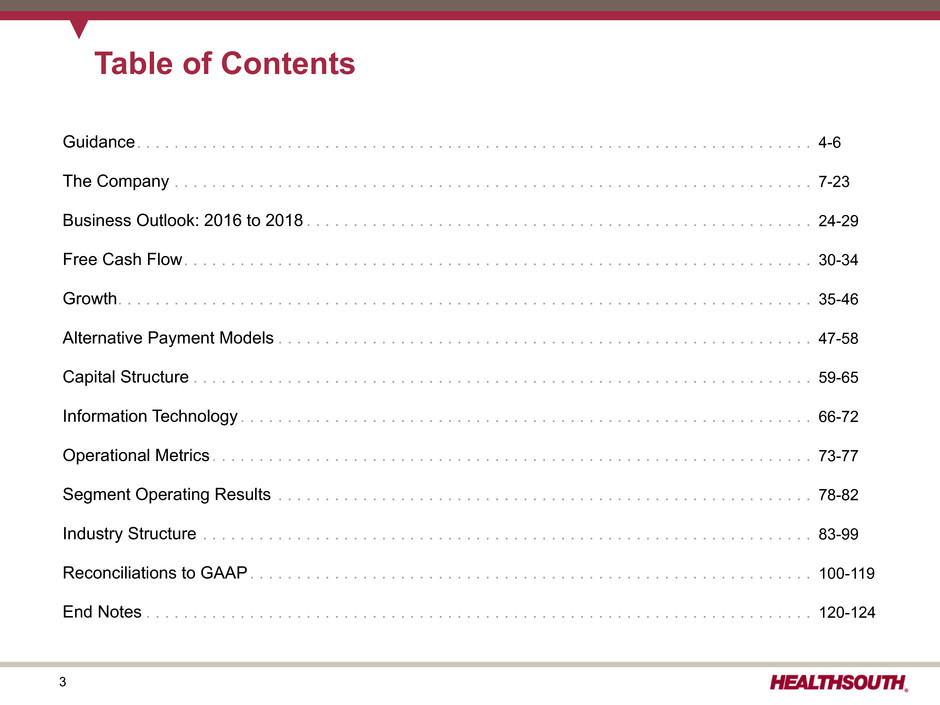
3 Table of Contents Guidance. . . . . . . . . . . . . . . . . . . . . . . . . . . . . . . . . . . . . . . . . . . . . . . . . . . . . . . . . . . . . . . . . . . . . . . . 4-6 The Company . . . . . . . . . . . . . . . . . . . . . . . . . . . . . . . . . . . . . . . . . . . . . . . . . . . . . . . . . . . . . . . . . . . . 7-23 Business Outlook: 2016 to 2018 . . . . . . . . . . . . . . . . . . . . . . . . . . . . . . . . . . . . . . . . . . . . . . . . . . . . . . 24-29 Free Cash Flow. . . . . . . . . . . . . . . . . . . . . . . . . . . . . . . . . . . . . . . . . . . . . . . . . . . . . . . . . . . . . . . . . . . 30-34 Growth. . . . . . . . . . . . . . . . . . . . . . . . . . . . . . . . . . . . . . . . . . . . . . . . . . . . . . . . . . . . . . . . . . . . . . . . . . 35-46 Alternative Payment Models . . . . . . . . . . . . . . . . . . . . . . . . . . . . . . . . . . . . . . . . . . . . . . . . . . . . . . . . . 47-58 Capital Structure . . . . . . . . . . . . . . . . . . . . . . . . . . . . . . . . . . . . . . . . . . . . . . . . . . . . . . . . . . . . . . . . . . 59-65 Information Technology . . . . . . . . . . . . . . . . . . . . . . . . . . . . . . . . . . . . . . . . . . . . . . . . . . . . . . . . . . . . . 66-72 Operational Metrics . . . . . . . . . . . . . . . . . . . . . . . . . . . . . . . . . . . . . . . . . . . . . . . . . . . . . . . . . . . . . . . . 73-77 Segment Operating Results . . . . . . . . . . . . . . . . . . . . . . . . . . . . . . . . . . . . . . . . . . . . . . . . . . . . . . . . . 78-82 Industry Structure . . . . . . . . . . . . . . . . . . . . . . . . . . . . . . . . . . . . . . . . . . . . . . . . . . . . . . . . . . . . . . . . . 83-99 Reconciliations to GAAP. . . . . . . . . . . . . . . . . . . . . . . . . . . . . . . . . . . . . . . . . . . . . . . . . . . . . . . . . . . . 100-119 End Notes . . . . . . . . . . . . . . . . . . . . . . . . . . . . . . . . . . . . . . . . . . . . . . . . . . . . . . . . . . . . . . . . . . . . . . . 120-124
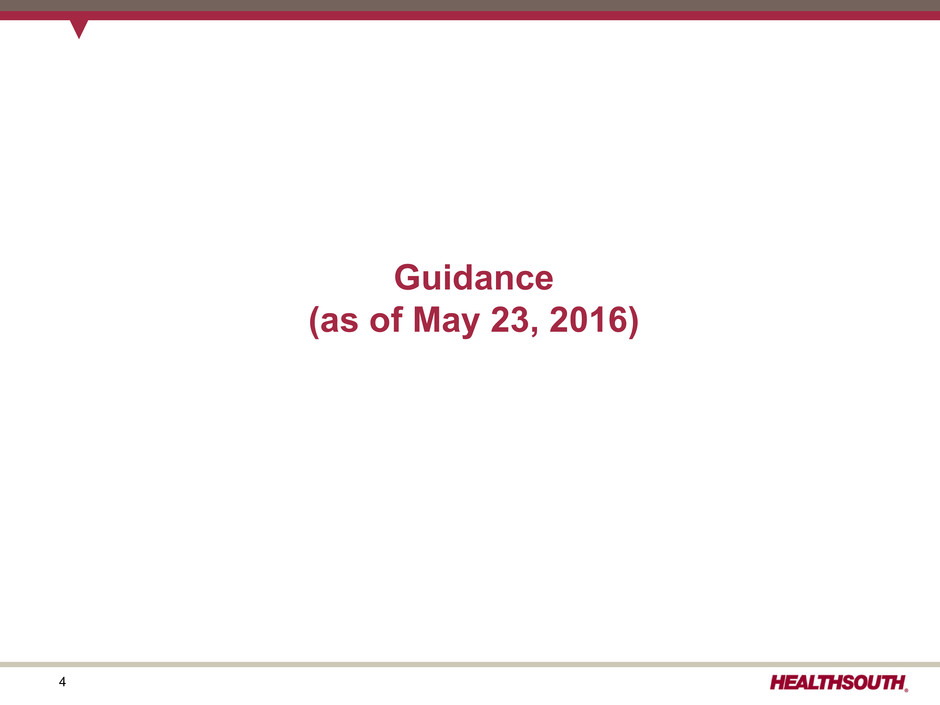
4 Guidance (as of May 23, 2016)
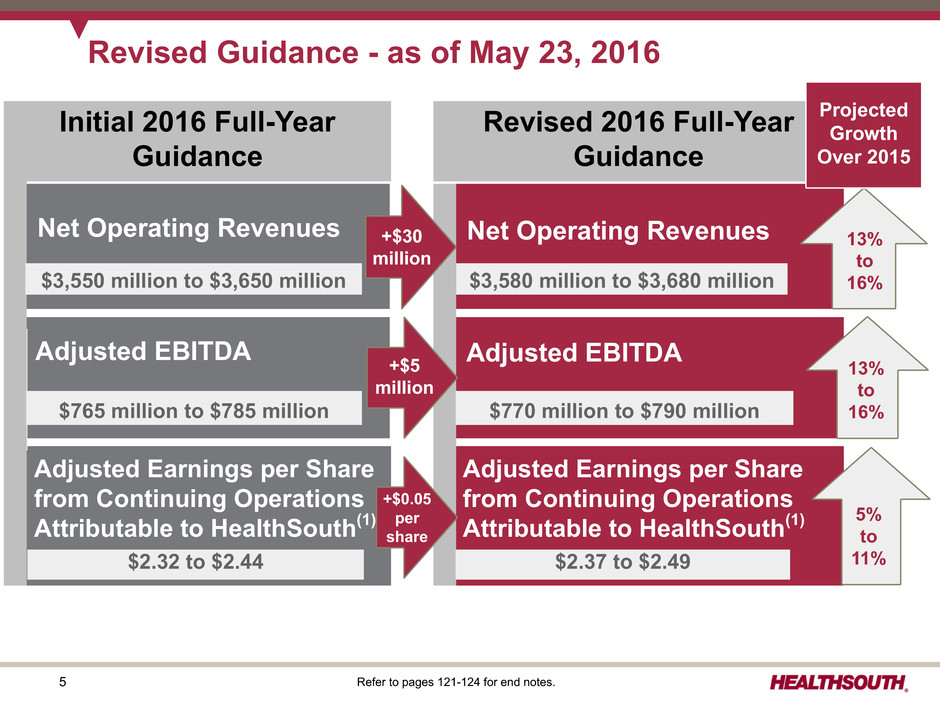
5 Refer to pages 121-124 for end notes. Adjusted EBITDA Adjusted Earnings per Share from Continuing Operations Attributable to HealthSouth(1) Revised Guidance - as of May 23, 2016 Net Operating Revenues Initial 2016 Full-Year Guidance Revised 2016 Full-Year Guidance Net Operating Revenues $3,580 million to $3,680 million Adjusted EBITDA $770 million to $790 million Adjusted Earnings per Share from Continuing Operations Attributable to HealthSouth(1) $2.37 to $2.49 Projected Growth Over 2015 $3,550 million to $3,650 million $765 million to $785 million $2.32 to $2.44 13% to 16% 13% to 16% 5% to 11% +$30 million +$5 million +$0.05 per share
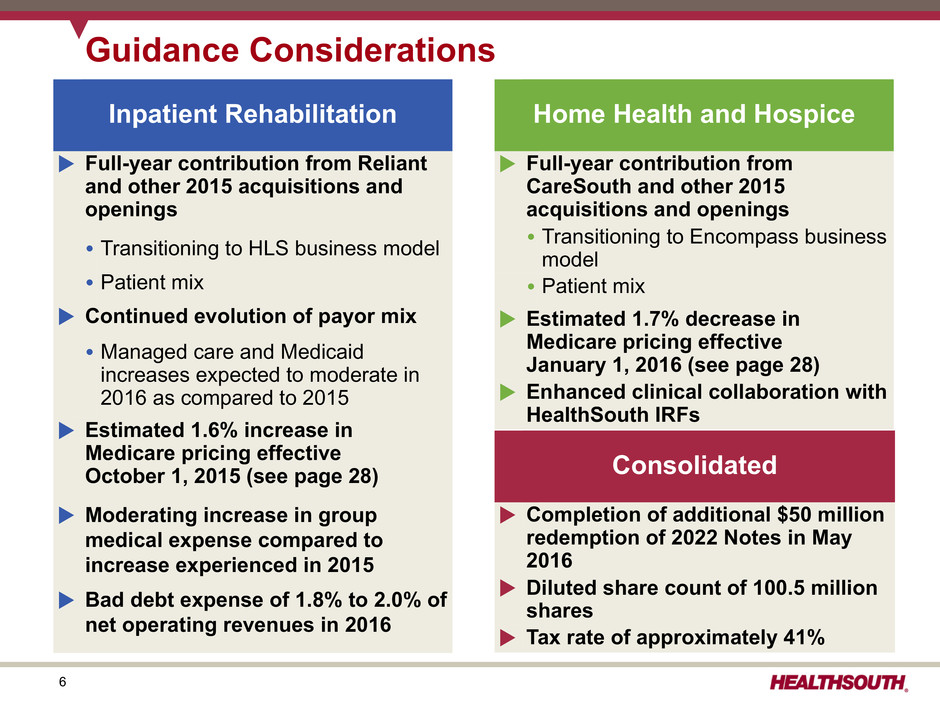
6 Inpatient Rehabilitation u Full-year contribution from Reliant and other 2015 acquisitions and openings Ÿ Transitioning to HLS business model Ÿ Patient mix u Continued evolution of payor mix Ÿ Managed care and Medicaid increases expected to moderate in 2016 as compared to 2015 u Estimated 1.6% increase in Medicare pricing effective October 1, 2015 (see page 28) u Moderating increase in group medical expense compared to increase experienced in 2015 u Bad debt expense of 1.8% to 2.0% of net operating revenues in 2016 Guidance Considerations Home Health and Hospice u Full-year contribution from CareSouth and other 2015 acquisitions and openings Ÿ Transitioning to Encompass business model Ÿ Patient mix u Estimated 1.7% decrease in Medicare pricing effective January 1, 2016 (see page 28) u Enhanced clinical collaboration with HealthSouth IRFs Consolidated u Completion of additional $50 million redemption of 2022 Notes in May 2016 u Diluted share count of 100.5 million shares u Tax rate of approximately 41%
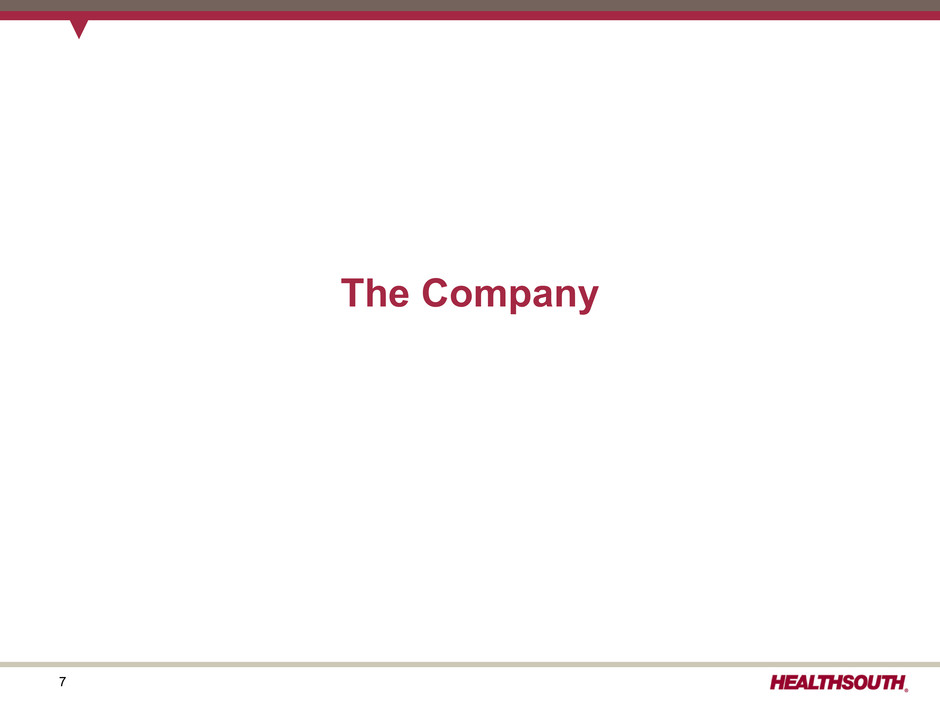
7 The Company
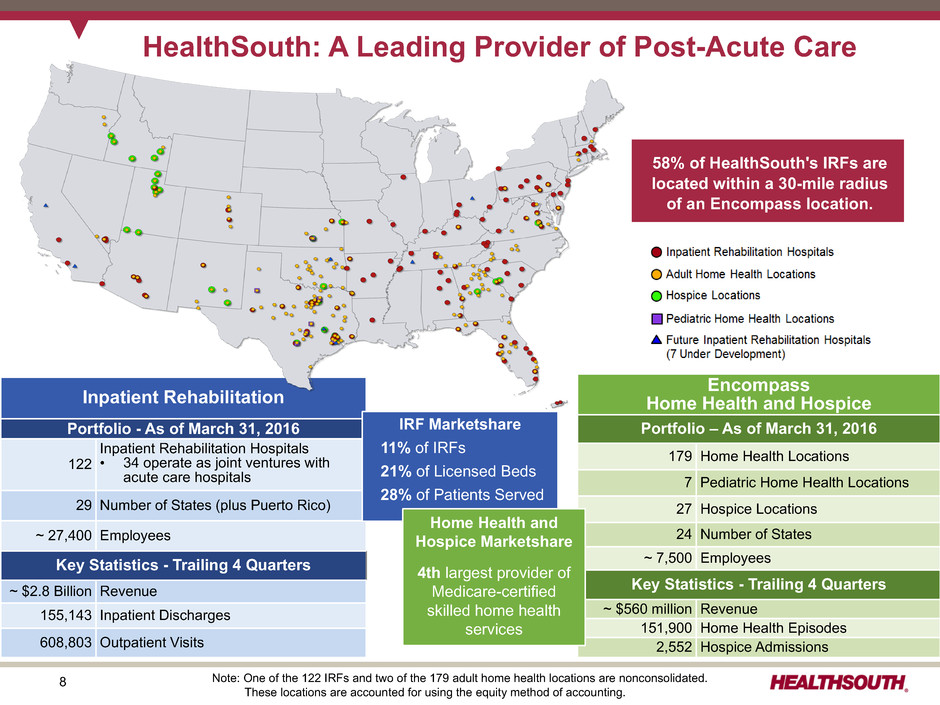
8 Note: One of the 122 IRFs and two of the 179 adult home health locations are nonconsolidated. These locations are accounted for using the equity method of accounting. HealthSouth: A Leading Provider of Post-Acute Care 58% of HealthSouth's IRFs are located within a 30-mile radius of an Encompass location. Inpatient Rehabilitation Portfolio - As of March 31, 2016 122 Inpatient Rehabilitation Hospitals • 34 operate as joint ventures with acute care hospitals 29 Number of States (plus Puerto Rico) ~ 27,400 Employees Key Statistics - Trailing 4 Quarters ~ $2.8 Billion Revenue 155,143 Inpatient Discharges 608,803 Outpatient Visits Encompass Home Health and Hospice Portfolio – As of March 31, 2016 179 Home Health Locations 7 Pediatric Home Health Locations 27 Hospice Locations 24 Number of States ~ 7,500 Employees Key Statistics - Trailing 4 Quarters ~ $560 million Revenue 151,900 Home Health Episodes 2,552 Hospice Admissions IRF Marketshare 11% of IRFs 21% of Licensed Beds 28% of Patients Served Home Health and Hospice Marketshare 4th largest provider of Medicare-certified skilled home health services
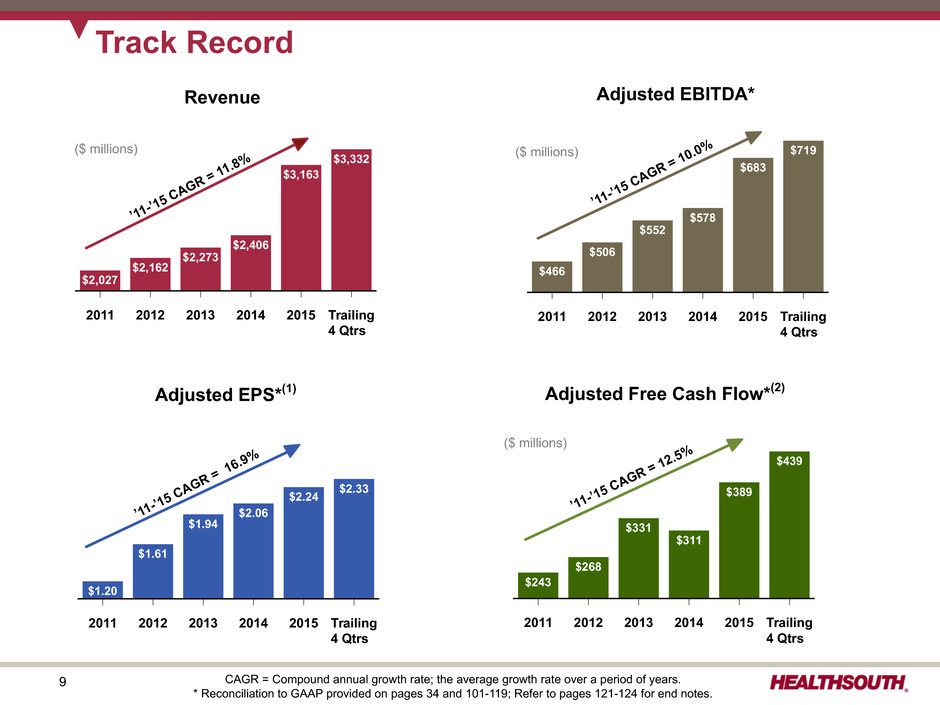
9 Adjusted EPS*(1) Track Record 2011 2012 2013 2014 2015 Trailing 4 Qtrs $2,027 $2,162 $2,273 $2,406 $3,163 $3,332 ($ millions) 2011 2012 2013 2014 2015 Trailing 4 Qtrs $466 $506 $552 $578 $683 $719 ’11-’15 CAGR = 10.0 %($ millions) ’11-’15 CAGR = 11.8 % Adjusted EBITDA* 2011 2012 2013 2014 2015 Trailing 4 Qtrs $1.20 $1.61 $1.94 $2.06 $2.24 $2.33 ’11-’15 CAGR = 16.9 % 2011 2012 2013 2014 2015 Trailing 4 Qtrs $243 $268 $331 $311 $389 $439 Adjusted Free Cash Flow*(2) ($ millions) ’11-’15 CAGR = 12.5 % Revenue CAGR = Compound annual growth rate; the average growth rate over a period of years. * Reconciliation to GAAP provided on pages 34 and 101-119; Refer to pages 121-124 for end notes.
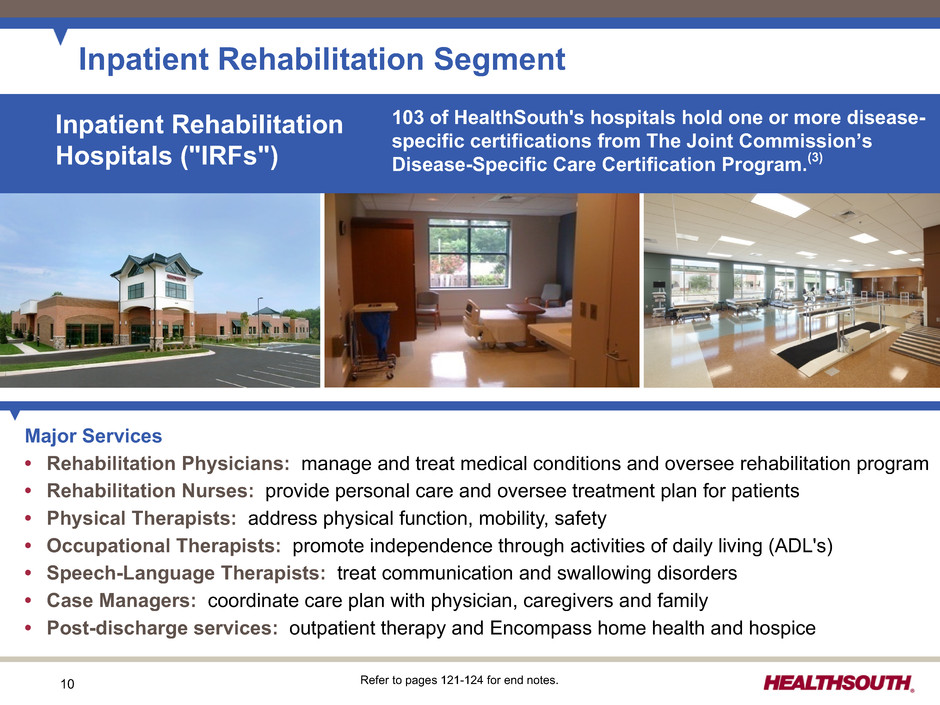
10 Inpatient Rehabilitation Segment Major Services • Rehabilitation Physicians: manage and treat medical conditions and oversee rehabilitation program • Rehabilitation Nurses: provide personal care and oversee treatment plan for patients • Physical Therapists: address physical function, mobility, safety • Occupational Therapists: promote independence through activities of daily living (ADL's) • Speech-Language Therapists: treat communication and swallowing disorders • Case Managers: coordinate care plan with physician, caregivers and family • Post-discharge services: outpatient therapy and Encompass home health and hospice Inpatient Rehabilitation Hospitals ("IRFs") Refer to pages 121-124 for end notes. 103 of HealthSouth's hospitals hold one or more disease- specific certifications from The Joint Commission’s Disease-Specific Care Certification Program.(3)
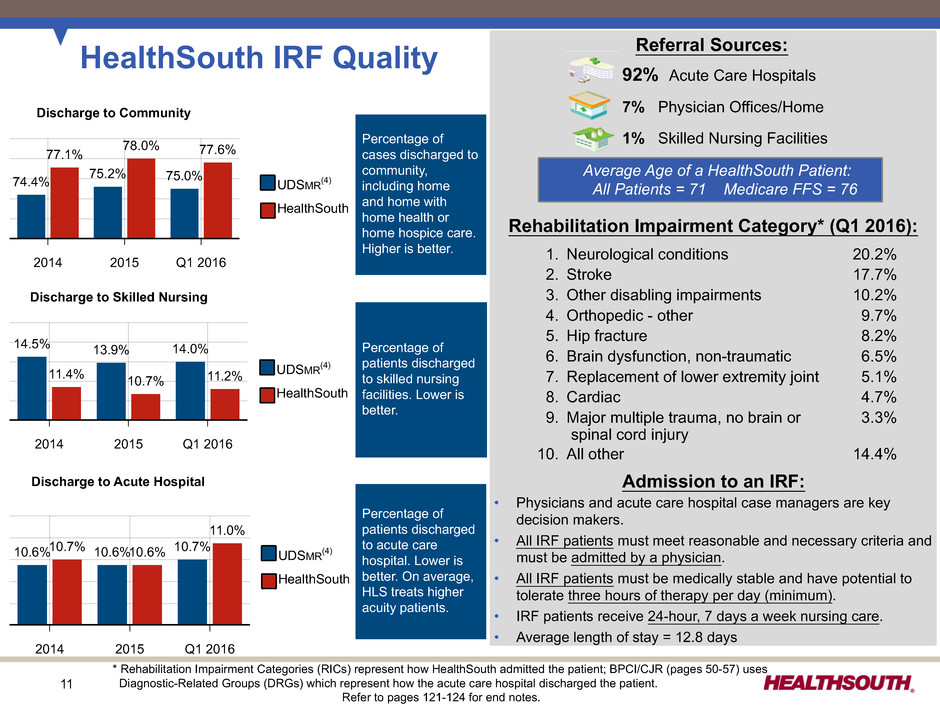
11 2014 2015 Q1 2016 14.5% 13.9% 14.0% 11.4% 10.7% 11.2% HealthSouth IRF Quality Referral Sources:92% Acute Care Hospitals 7% Physician Offices/Home 1% Skilled Nursing Facilities Rehabilitation Impairment Category* (Q1 2016): • Physicians and acute care hospital case managers are key decision makers. • All IRF patients must meet reasonable and necessary criteria and must be admitted by a physician. • All IRF patients must be medically stable and have potential to tolerate three hours of therapy per day (minimum). • IRF patients receive 24-hour, 7 days a week nursing care. • Average length of stay = 12.8 days Admission to an IRF: Average Age of a HealthSouth Patient: All Patients = 71 Medicare FFS = 76 Discharge to Community Discharge to Skilled Nursing Discharge to Acute Hospital Percentage of cases discharged to community, including home and home with home health or home hospice care. Higher is better. Percentage of patients discharged to skilled nursing facilities. Lower is better. Percentage of patients discharged to acute care hospital. Lower is better. On average, HLS treats higher acuity patients. 2014 2015 Q1 2016 74.4% 75.2% 75.0% 77.1% 78.0% 77.6% 2014 2015 Q1 2016 10.6% 10.6% 10.7%10.7% 10.6% 11.0% UDSMR(4) HealthSouth UDSMR(4) HealthSouth UDSMR(4) HealthSouth * Rehabilitation Impairment Categories (RICs) represent how HealthSouth admitted the patient; BPCI/CJR (pages 50-57) uses Diagnostic-Related Groups (DRGs) which represent how the acute care hospital discharged the patient. Refer to pages 121-124 for end notes. 1. Neurological conditions 20.2% 2. Stroke 17.7% 3. Other disabling impairments 10.2% 4. Orthopedic - other 9.7% 5. Hip fracture 8.2% 6. Brain dysfunction, non-traumatic 6.5% 7. Replacement of lower extremity joint 5.1% 8. Cardiac 4.7% 9. Major multiple trauma, no brain or spinal cord injury 3.3% 10. All other 14.4%

12 Total Inpatient Rehabilitation Facilities: 1,132 IRF Cost Effectiveness(5) The Avg. Est. TotalPayment per Discharge has not been reduced by 2% for sequestration.(9) Medicare pays HealthSouth less per discharge, on average, and HealthSouth treats a higher acuity patient. Avg. Beds per IRF Avg. Medicare Discharges per IRF(7) Case Mix Index(8) Avg. Est. Total Cost per Discharge for FY 2017 Avg. Est. Total Payment per Discharge for FY 2017 HLS(6) = 119 67 953 1.25 $12,613 $19,329 Free- Standing (Non-HLS) = 143 57 584 1.23 $16,695 $20,208 870 25 232 1.18 $20,018 $20,478 Hospital Units = Total 1,132 33 352 1.21 $17,214 $20,094 Refer to pages 121-124 for end notes. HealthSouth differentiates itself by: ü “Best Practices” clinical protocols ü Supply chain efficiencies ü Sophisticated management information systems ü Economies of scale
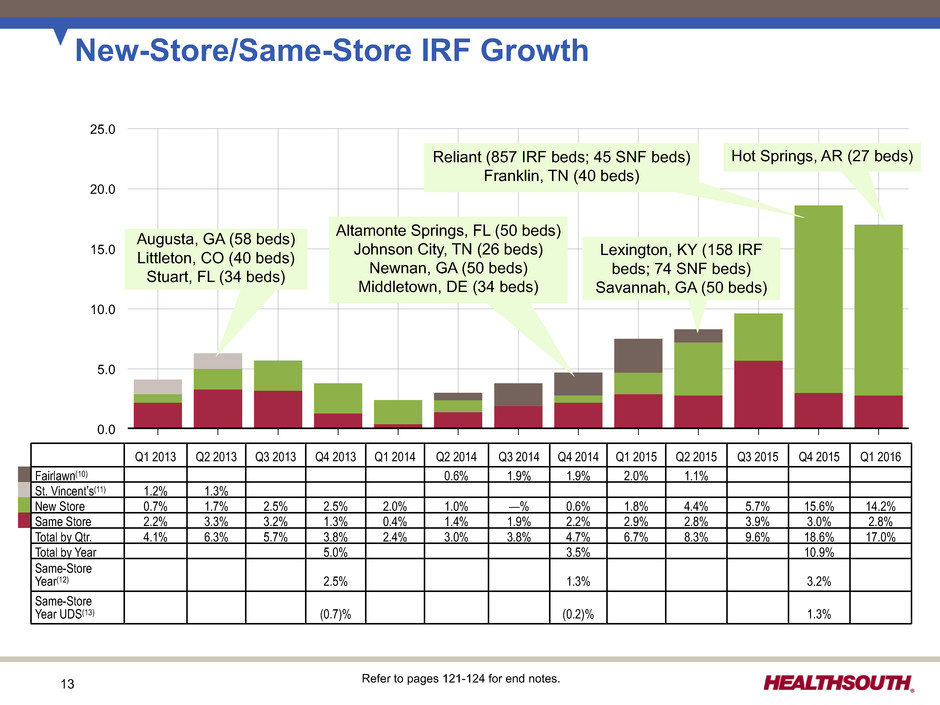
13 Refer to pages 121-124 for end notes. 25.0 20.0 15.0 10.0 5.0 0.0 Q1 2013 Q2 2013 Q3 2013 Q4 2013 Q1 2014 Q2 2014 Q3 2014 Q4 2014 Q1 2015 Q2 2015 Q3 2015 Q4 2015 Q1 2016 New-Store/Same-Store IRF Growth Q1 2013 Q2 2013 Q3 2013 Q4 2013 Q1 2014 Q2 2014 Q3 2014 Q4 2014 Q1 2015 Q2 2015 Q3 2015 Q4 2015 Q1 2016 Fairlawn(10) 0.6% 1.9% 1.9% 2.0% 1.1% St. Vincent’s(11) 1.2% 1.3% New Store 0.7% 1.7% 2.5% 2.5% 2.0% 1.0% —% 0.6% 1.8% 4.4% 5.7% 15.6% 14.2% Same Store 2.2% 3.3% 3.2% 1.3% 0.4% 1.4% 1.9% 2.2% 2.9% 2.8% 3.9% 3.0% 2.8% Total by Qtr. 4.1% 6.3% 5.7% 3.8% 2.4% 3.0% 3.8% 4.7% 6.7% 8.3% 9.6% 18.6% 17.0% Total by Year 5.0% 3.5% 10.9% Same-Store Year(12) 2.5% 1.3% 3.2% Same-Store Year UDS(13) (0.7)% (0.2)% 1.3% Altamonte Springs, FL (50 beds) Johnson City, TN (26 beds) Newnan, GA (50 beds) Middletown, DE (34 beds) Augusta, GA (58 beds) Littleton, CO (40 beds) Stuart, FL (34 beds) Reliant (857 IRF beds; 45 SNF beds) Franklin, TN (40 beds) Lexington, KY (158 IRF beds; 74 SNF beds) Savannah, GA (50 beds) Hot Springs, AR (27 beds)
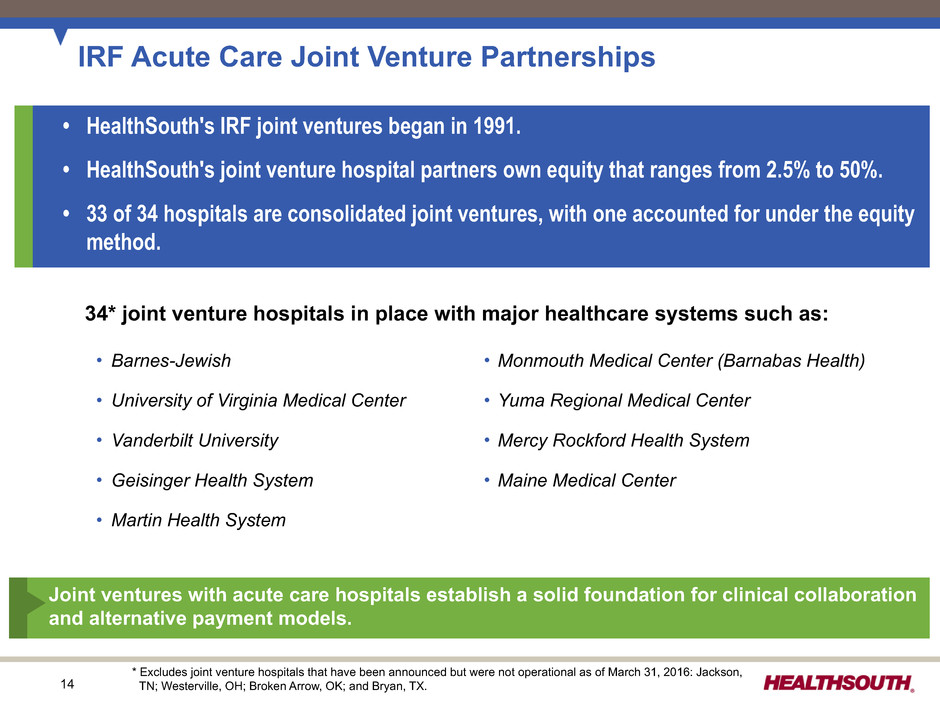
14 • • HealthSouth's IRF joint ventures began in 1991. • HealthSouth's joint venture hospital partners own equity that ranges from 2.5% to 50%. • 33 of 34 hospitals are consolidated joint ventures, with one accounted for under the equity method. IRF Acute Care Joint Venture Partnerships 34* joint venture hospitals in place with major healthcare systems such as: Joint ventures with acute care hospitals establish a solid foundation for clinical collaboration and alternative payment models. • Barnes-Jewish • Monmouth Medical Center (Barnabas Health) • University of Virginia Medical Center • Yuma Regional Medical Center • Vanderbilt University • Mercy Rockford Health System • Geisinger Health System • Maine Medical Center • Martin Health System * Excludes joint venture hospitals that have been announced but were not operational as of March 31, 2016: Jackson, TN; Westerville, OH; Broken Arrow, OK; and Bryan, TX.

15 38 Lease Building and Land A CON (Certificate of Need) is a regulatory requirement in approx. 50% of states and some federal jurisdictions that require state authorization prior to proposed acquisitions, expansions, or construction of new hospitals. 56 Own Building and Land* 28 Own Building Only* * The joint ventures with Memorial Health in Savannah, GA and CHI St. Vincent in Hot Springs, AR are operating under short- term leases until replacement hospitals are completed in 2016. The replacement hospitals will be owned by the respective joint venture and are included in the categories for "Own Building Only" (Savannah) and "Own Building and Land" (Hot Springs). IRF Real Estate Portfolio 122 Inpatient Rehabilitation Hospitals: 8,481 Licensed Beds 4,370 Licensed Beds in CON States 4,111 Licensed Beds in Non-CON States 1 of the 122 HealthSouth hospitals is nonconsolidated. For that hospital, the Company owns the building only. The Company's licensed bed count does not include the 51 beds associated with the nonconsolidated hospital.
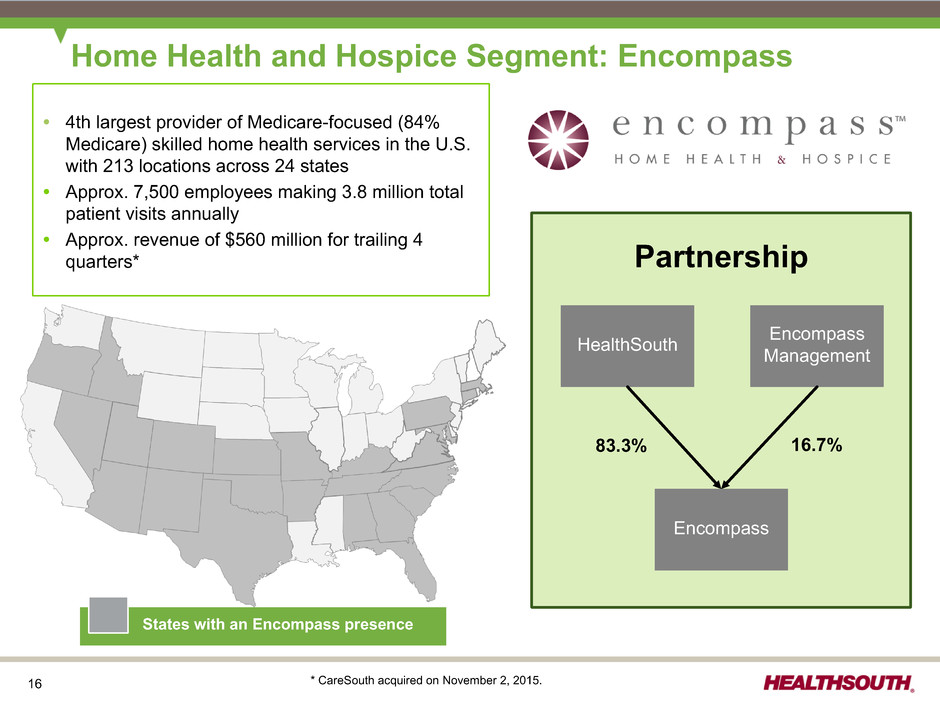
16 States with an Encompass presence Home Health and Hospice Segment: Encompass • 4th largest provider of Medicare-focused (84% Medicare) skilled home health services in the U.S. with 213 locations across 24 states • Approx. 7,500 employees making 3.8 million total patient visits annually • Approx. revenue of $560 million for trailing 4 quarters* * CareSouth acquired on November 2, 2015. Partnership HealthSouth EncompassManagement Encompass 16.7%83.3%
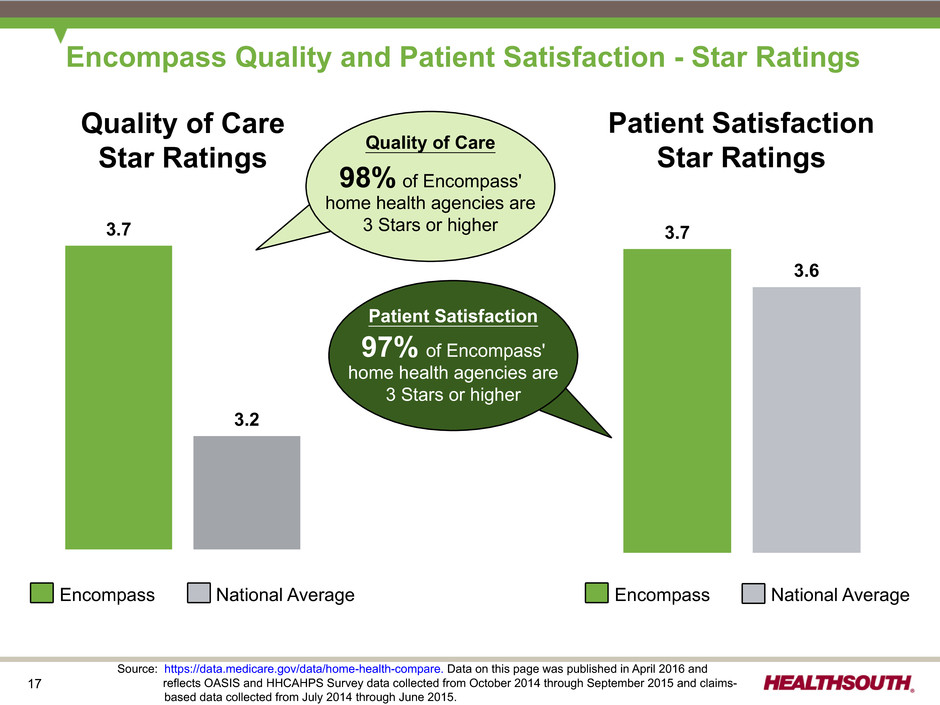
17 3.7 3.2 Patient Satisfaction Star Ratings Encompass National Average Encompass National Average Source: https://data.medicare.gov/data/home-health-compare. Data on this page was published in April 2016 and reflects OASIS and HHCAHPS Survey data collected from October 2014 through September 2015 and claims- based data collected from July 2014 through June 2015. Encompass Quality and Patient Satisfaction - Star Ratings 3.7 3.6 Quality of Care Star Ratings Patient Satisfaction 97% of Encompass' home health agencies are 3 Stars or higher Quality of Care 98% of Encompass' home health agencies are 3 Stars or higher
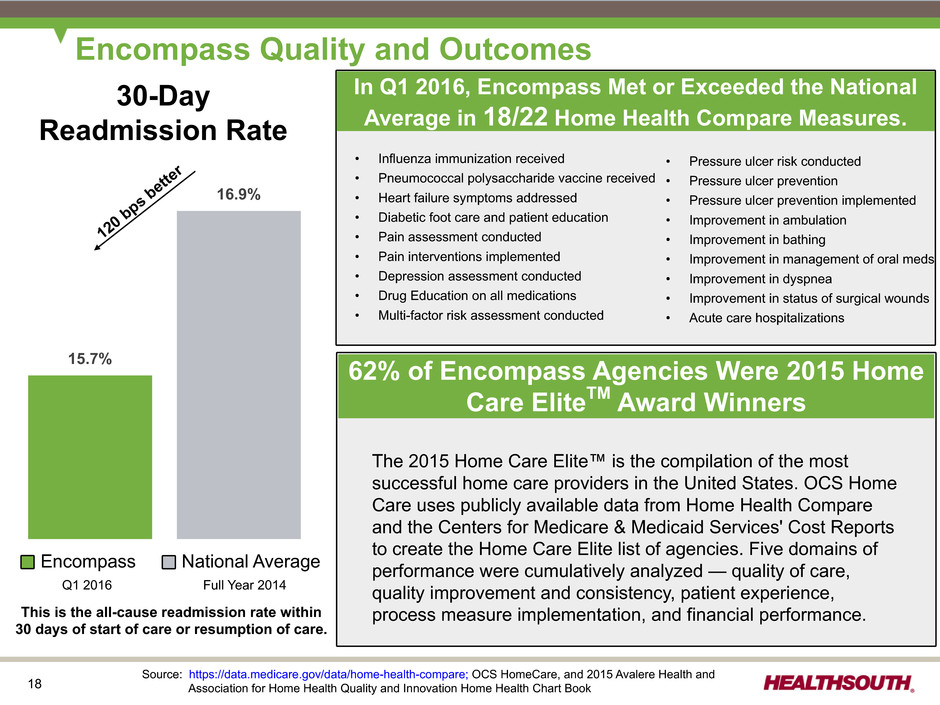
18 15.7% 16.9% 120 bps bette r In Q1 2016, Encompass Met or Exceeded the National Average in 18/22 Home Health Compare Measures. • Influenza immunization received • Pneumococcal polysaccharide vaccine received • Heart failure symptoms addressed • Diabetic foot care and patient education • Pain assessment conducted • Pain interventions implemented • Depression assessment conducted • Drug Education on all medications • Multi-factor risk assessment conducted • Pressure ulcer risk conducted • Pressure ulcer prevention • Pressure ulcer prevention implemented • Improvement in ambulation • Improvement in bathing • Improvement in management of oral meds • Improvement in dyspnea • Improvement in status of surgical wounds • Acute care hospitalizations 62% of Encompass Agencies Were 2015 Home Care EliteTM Award Winners The 2015 Home Care Elite™ is the compilation of the most successful home care providers in the United States. OCS Home Care uses publicly available data from Home Health Compare and the Centers for Medicare & Medicaid Services' Cost Reports to create the Home Care Elite list of agencies. Five domains of performance were cumulatively analyzed — quality of care, quality improvement and consistency, patient experience, process measure implementation, and financial performance. Source: https://data.medicare.gov/data/home-health-compare; OCS HomeCare, and 2015 Avalere Health and Association for Home Health Quality and Innovation Home Health Chart Book Encompass National Average Q1 2016 Full Year 2014 Encompass Quality and Outcomes This is the all-cause readmission rate within 30 days of start of care or resumption of care. 30-Day Readmission Rate
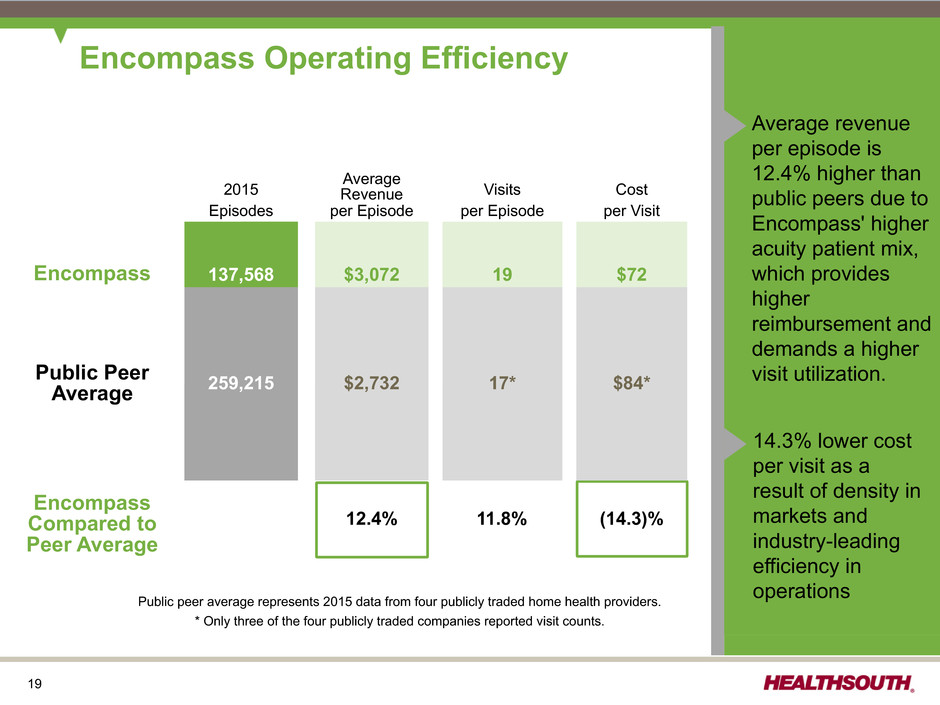
19 Encompass Operating Efficiency Average revenue per episode is 12.4% higher than public peers due to Encompass' higher acuity patient mix, which provides higher reimbursement and demands a higher visit utilization. 14.3% lower cost per visit as a result of density in markets and industry-leading efficiency in operations 2015 AverageRevenue Visits Cost Episodes per Episode per Episode per Visit Encompass 137,568 $3,072 19 $72 Public Peer Average 259,215 $2,732 17* $84* Encompass Compared to Peer Average 12.4% 11.8% (14.3)% Public peer average represents 2015 data from four publicly traded home health providers. * Only three of the four publicly traded companies reported visit counts.
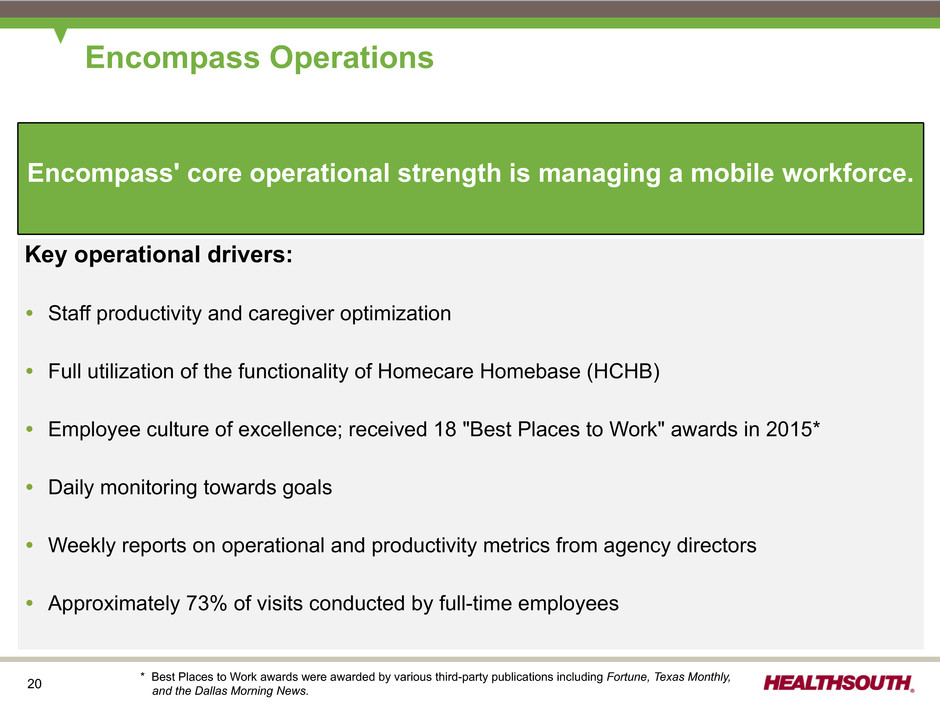
20 Key operational drivers: • Staff productivity and caregiver optimization • Full utilization of the functionality of Homecare Homebase (HCHB) • Employee culture of excellence; received 18 "Best Places to Work" awards in 2015* • Daily monitoring towards goals • Weekly reports on operational and productivity metrics from agency directors • Approximately 73% of visits conducted by full-time employees Encompass Operations Encompass' core operational strength is managing a mobile workforce. * Best Places to Work awards were awarded by various third-party publications including Fortune, Texas Monthly, and the Dallas Morning News.
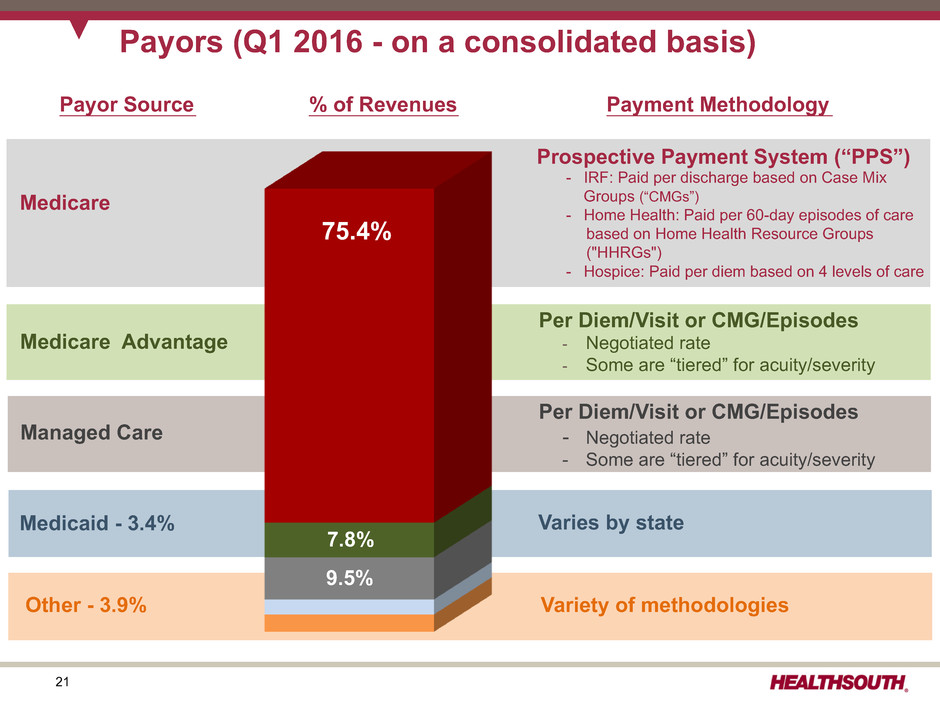
21 Managed Care Other - 3.9% Variety of methodologies Prospective Payment System (“PPS”) - IRF: Paid per discharge based on Case Mix Groups (“CMGs”) - Home Health: Paid per 60-day episodes of care based on Home Health Resource Groups ("HHRGs") - Hospice: Paid per diem based on 4 levels of care Medicare Per Diem/Visit or CMG/Episodes - Negotiated rate - Some are “tiered” for acuity/severity Varies by state Medicare Advantage Medicaid - 3.4% Payors (Q1 2016 - on a consolidated basis) Payor Source Payment Methodology Per Diem/Visit or CMG/Episodes - Negotiated rate - Some are “tiered” for acuity/severity % of Revenues 75.4% 7.8% 9.5%
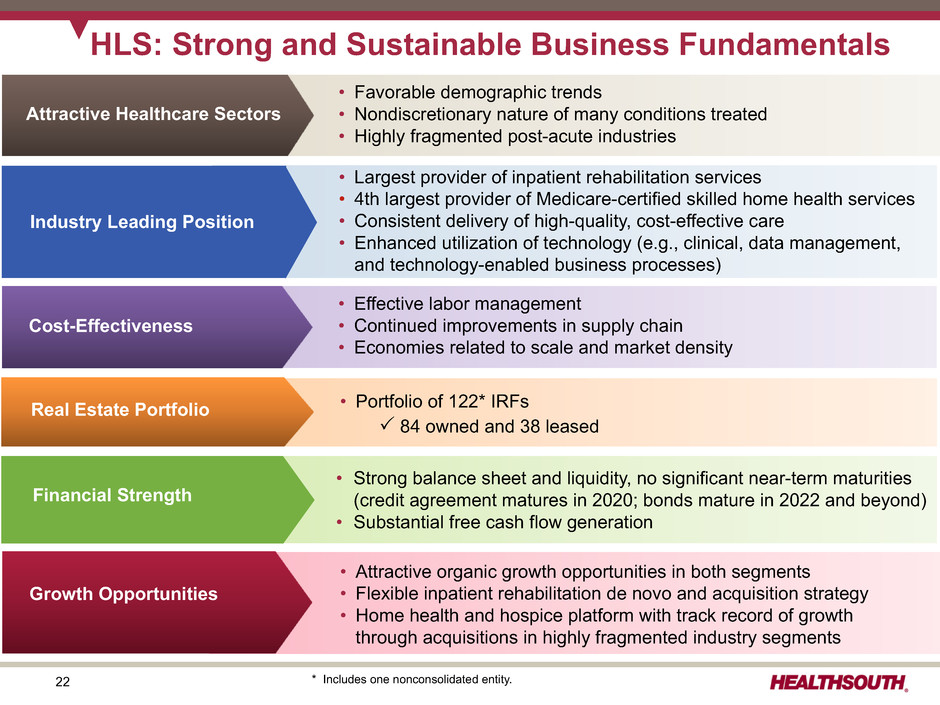
22 • Largest provider of inpatient rehabilitation services • 4th largest provider of Medicare-certified skilled home health services • Consistent delivery of high-quality, cost-effective care • Enhanced utilization of technology (e.g., clinical, data management, and technology-enabled business processes) HLS: Strong and Sustainable Business Fundamentals • Effective labor management • Continued improvements in supply chain • Economies related to scale and market density Cost-Effectiveness • Strong balance sheet and liquidity, no significant near-term maturities (credit agreement matures in 2020; bonds mature in 2022 and beyond) • Substantial free cash flow generation • Attractive organic growth opportunities in both segments • Flexible inpatient rehabilitation de novo and acquisition strategy • Home health and hospice platform with track record of growth through acquisitions in highly fragmented industry segments • Portfolio of 122* IRFs P 84 owned and 38 leased Real Estate Portfolio Attractive Healthcare Sectors Growth Opportunities Cost-Effectiveness • Favorable demographic trends • Nondiscretionary nature of many conditions treated • Highly fragmented post-acute industries Industry Leading Position Financial Strength * Includes one nonconsolidated entity.
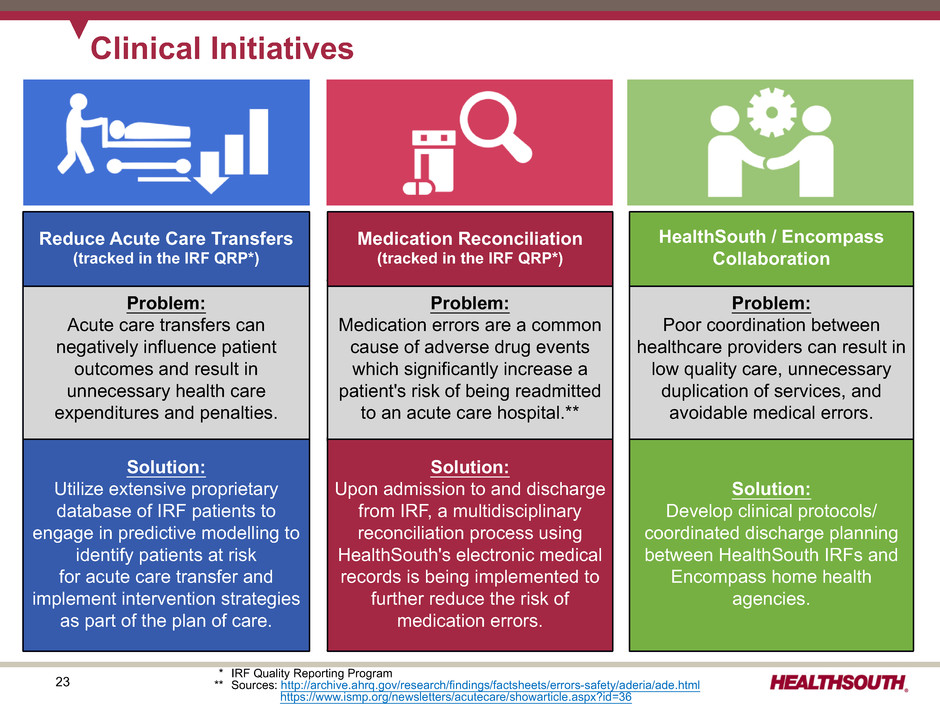
23 Solution: Utilize extensive proprietary database of IRF patients to engage in predictive modelling to identify patients at risk for acute care transfer and implement intervention strategies as part of the plan of care. Solution: Upon admission to and discharge from IRF, a multidisciplinary reconciliation process using HealthSouth's electronic medical records is being implemented to further reduce the risk of medication errors. Solution: Develop clinical protocols/ coordinated discharge planning between HealthSouth IRFs and Encompass home health agencies. Problem: Acute care transfers can negatively influence patient outcomes and result in unnecessary health care expenditures and penalties. Problem: Medication errors are a common cause of adverse drug events which significantly increase a patient's risk of being readmitted to an acute care hospital.** Problem: Poor coordination between healthcare providers can result in low quality care, unnecessary duplication of services, and avoidable medical errors. Clinical Initiatives Reduce Acute Care Transfers (tracked in the IRF QRP*) Medication Reconciliation (tracked in the IRF QRP*) HealthSouth / Encompass Collaboration * ** IRF Quality Reporting Program Sources: http://archive.ahrq.gov/research/findings/factsheets/errors-safety/aderia/ade.html https://www.ismp.org/newsletters/acutecare/showarticle.aspx?id=36
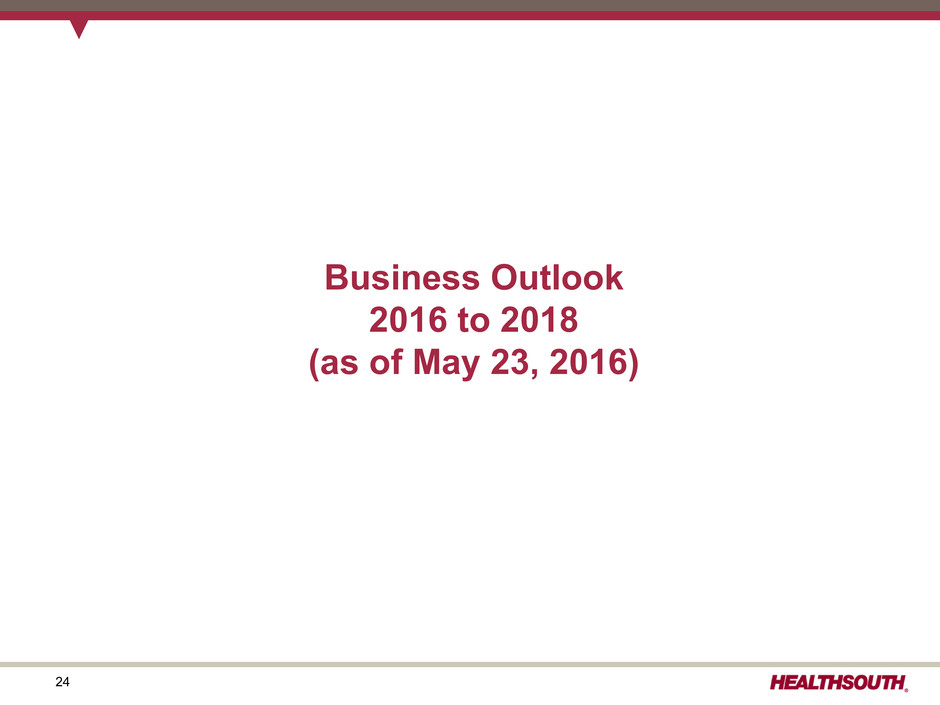
24 Business Outlook 2016 to 2018 (as of May 23, 2016)
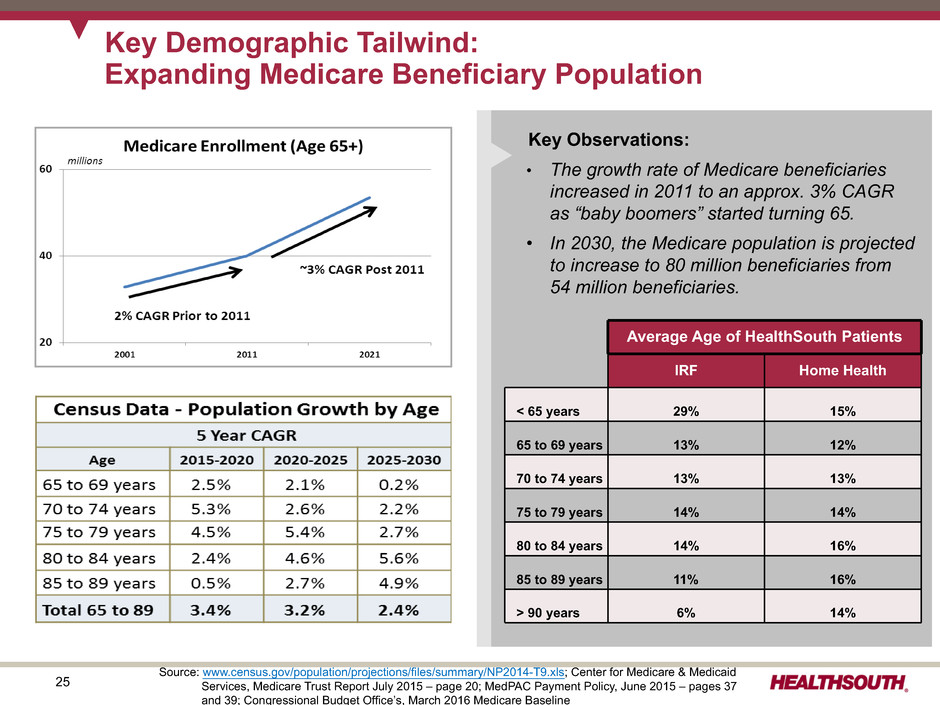
25 Key Demographic Tailwind: Expanding Medicare Beneficiary Population Key Observations: • The growth rate of Medicare beneficiaries increased in 2011 to an approx. 3% CAGR as “baby boomers” started turning 65. • In 2030, the Medicare population is projected to increase to 80 million beneficiaries from 54 million beneficiaries. Source: www.census.gov/population/projections/files/summary/NP2014-T9.xls; Center for Medicare & Medicaid Services, Medicare Trust Report July 2015 – page 20; MedPAC Payment Policy, June 2015 – pages 37 and 39; Congressional Budget Office’s, March 2016 Medicare Baseline Average Age of HealthSouth Patients IRF Home Health < 65 years 29% 15% 65 to 69 years 13% 12% 70 to 74 years 13% 13% 75 to 79 years 14% 14% 80 to 84 years 14% 16% 85 to 89 years 11% 16% > 90 years 6% 14%
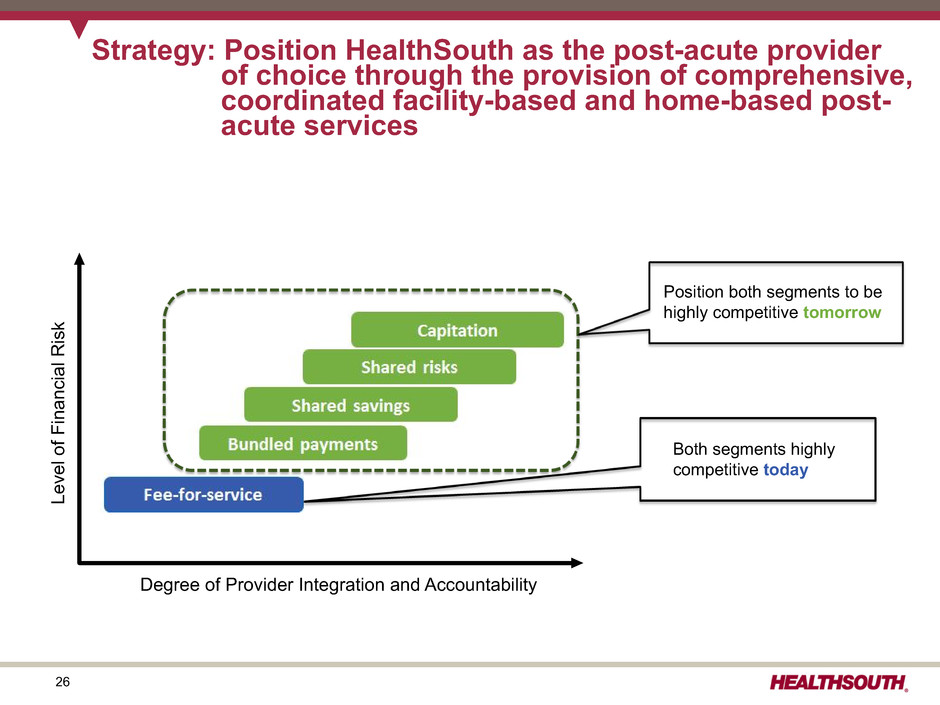
26 Strategy: Position HealthSouth as the post-acute provider of choice through the provision of comprehensive, coordinated facility-based and home-based post- acute services Degree of Provider Integration and Accountability Level of Financial Ris k Both segments highly competitive today Position both segments to be highly competitive tomorrow
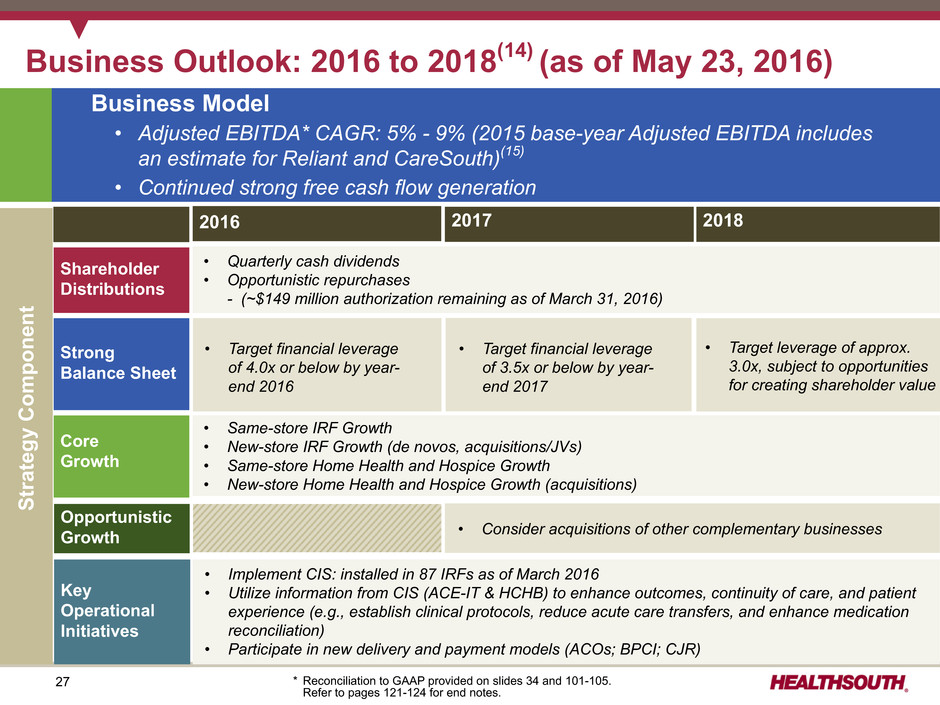
27 • Same-store IRF Growth • New-store IRF Growth (de novos, acquisitions/JVs) • Same-store Home Health and Hospice Growth • New-store Home Health and Hospice Growth (acquisitions) Core Growth Strong Balance Sheet Key Operational Initiatives Shareholder Distributions Opportunistic Growth Business Outlook: 2016 to 2018(14) (as of May 23, 2016) 2016 2017 2018 Business Model • Adjusted EBITDA* CAGR: 5% - 9% (2015 base-year Adjusted EBITDA includes an estimate for Reliant and CareSouth)(15) • Continued strong free cash flow generation • Quarterly cash dividends • Opportunistic repurchases - (~$149 million authorization remaining as of March 31, 2016) • Implement CIS: installed in 87 IRFs as of March 2016 • Utilize information from CIS (ACE-IT & HCHB) to enhance outcomes, continuity of care, and patient experience (e.g., establish clinical protocols, reduce acute care transfers, and enhance medication reconciliation) • Participate in new delivery and payment models (ACOs; BPCI; CJR) • Target financial leverage of 4.0x or below by year- end 2016 Strategy Componen t * Reconciliation to GAAP provided on slides 34 and 101-105. Refer to pages 121-124 for end notes. • Consider acquisitions of other complementary businesses • Target leverage of approx. 3.0x, subject to opportunities for creating shareholder value • Target financial leverage of 3.5x or below by year- end 2017
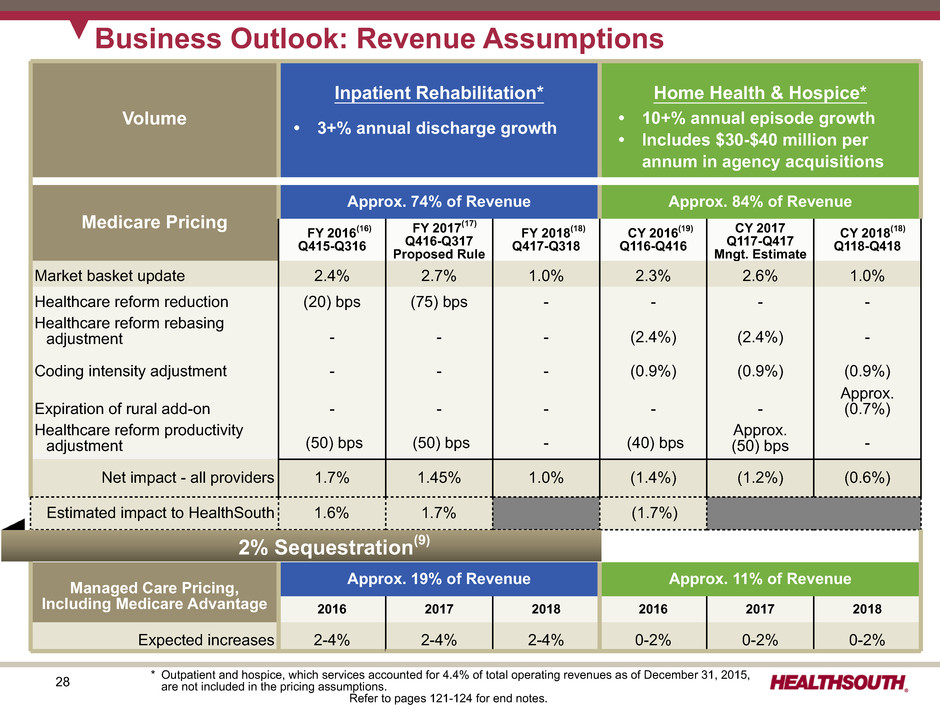
28 * Outpatient and hospice, which services accounted for 4.4% of total operating revenues as of December 31, 2015,are not included in the pricing assumptions. Refer to pages 121-124 for end notes. • 10% to15% annual episode growth • Includes $35-$40 million per annum in agency acquisitions Volume Inpatient Rehabilitation* Home Health & Hospice* Medicare Pricing Approx. 74% of Revenue Approx. 84% of Revenue FY 2016(16) Q415-Q316 FY 2017(17) Q416-Q317 Proposed Rule FY 2018(18) Q417-Q318 CY 2016(19) Q116-Q416 CY 2017 Q117-Q417 Mngt. Estimate CY 2018(18) Q118-Q418 Market basket update 2.4% 2.7% 1.0% 2.3% 2.6% 1.0% Healthcare reform reduction (20) bps (75) bps - - - - Healthcare reform rebasing adjustment - - - (2.4%) (2.4%) - Coding intensity adjustment - - - (0.9%) (0.9%) (0.9%) Expiration of rural add-on - - - - - Approx. (0.7%) Healthcare reform productivity adjustment (50) bps (50) bps - (40) bps Approx. (50) bps - Net impact - all providers 1.7% 1.45% 1.0% (1.4%) (1.2%) (0.6%) Estimated impact to HealthSouth 1.6% 1.7% (1.7%) Managed Care Pricing, Including Medicare Advantage Approx. 19% of Revenue Approx. 11% of Revenue 2016 2017 2018 2016 2017 2018 Expected increases 2-4% 2-4% 2-4% 0-2% 0-2% 0-2% Business Outlook: Revenue Assumptions 2% Sequestration(9) • 3+% annual discharge growth • 10+% annual episode growth• Includes $30-$40 million per annum in agency acquisitions
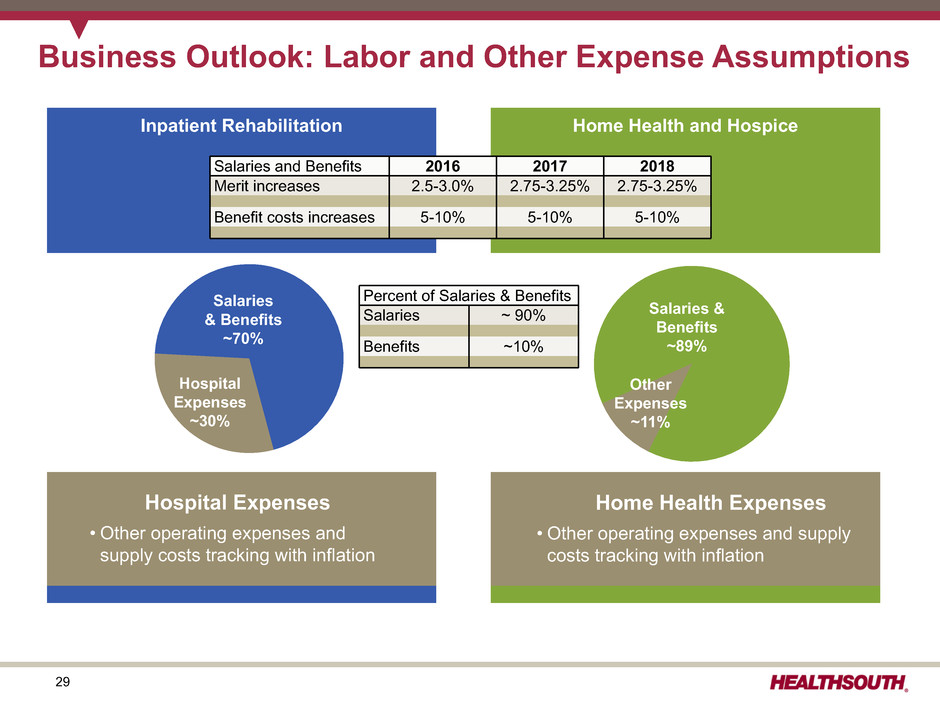
29 Inpatient Rehabilitation Home Health and Hospice Business Outlook: Labor and Other Expense Assumptions Salaries & Benefits ~70% Hospital Expenses ~30% Salaries and Benefits 2016 2017 2018 Merit increases 2.5-3.0% 2.75-3.25% 2.75-3.25% Benefit costs increases 5-10% 5-10% 5-10% Hospital Expenses • Other operating expenses and supply costs tracking with inflation Salaries & Benefits ~89% Other Expenses ~11% Home Health Expenses • Other operating expenses and supply costs tracking with inflation Percent of Salaries & Benefits Salaries ~ 90% Benefits ~10%
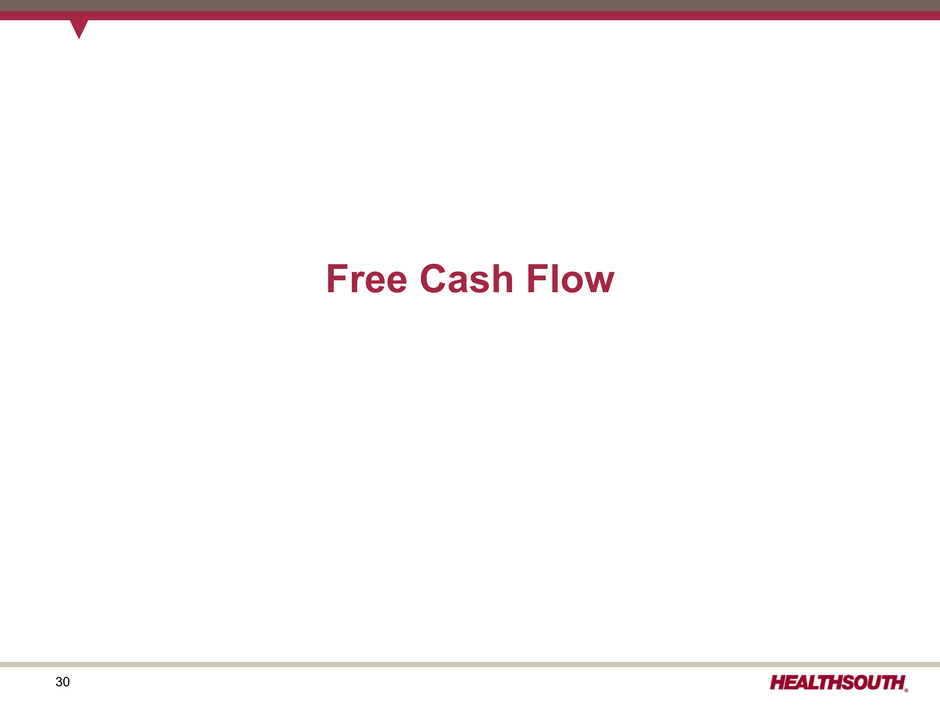
30 Free Cash Flow
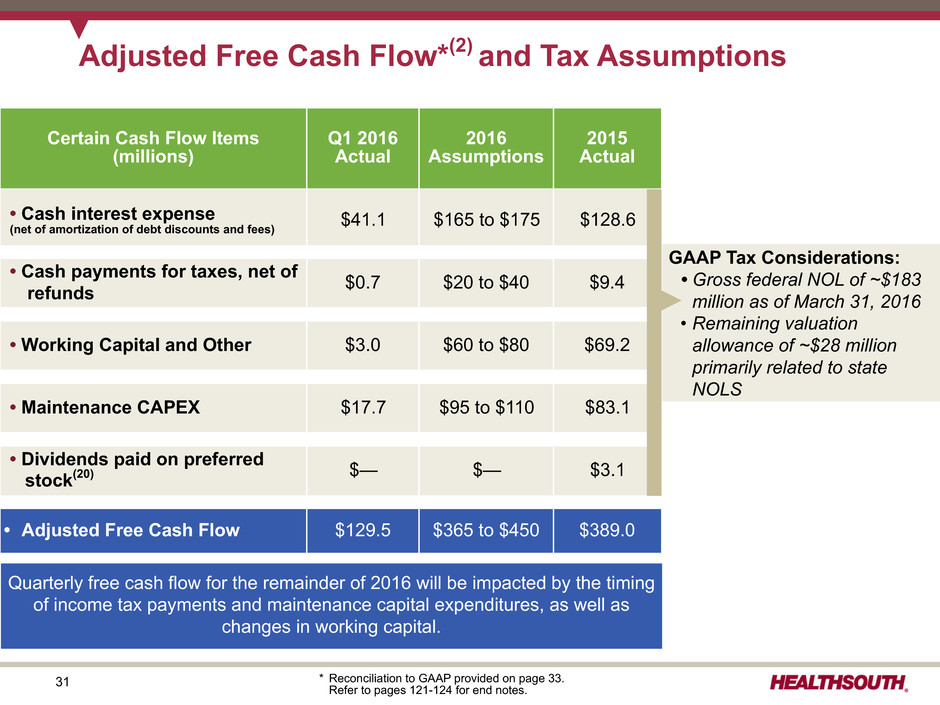
31 Adjusted Free Cash Flow*(2) and Tax Assumptions * Reconciliation to GAAP provided on page 33. Refer to pages 121-124 for end notes. Certain Cash Flow Items (millions) Q1 2016 Actual 2016 Assumptions 2015 Actual • Cash interest expense (net of amortization of debt discounts and fees) $41.1 $165 to $175 $128.6 • Cash payments for taxes, net of refunds $0.7 $20 to $40 $9.4 • Working Capital and Other $3.0 $60 to $80 $69.2 • Maintenance CAPEX $17.7 $95 to $110 $83.1 • Dividends paid on preferred stock(20) $— $— $3.1 • Adjusted Free Cash Flow $129.5 $365 to $450 $389.0 GAAP Tax Considerations: • Gross federal NOL of ~$183 million as of March 31, 2016 • Remaining valuation allowance of ~$28 million primarily related to state NOLS Quarterly free cash flow for the remainder of 2016 will be impacted by the timing of income tax payments and maintenance capital expenditures, as well as changes in working capital.
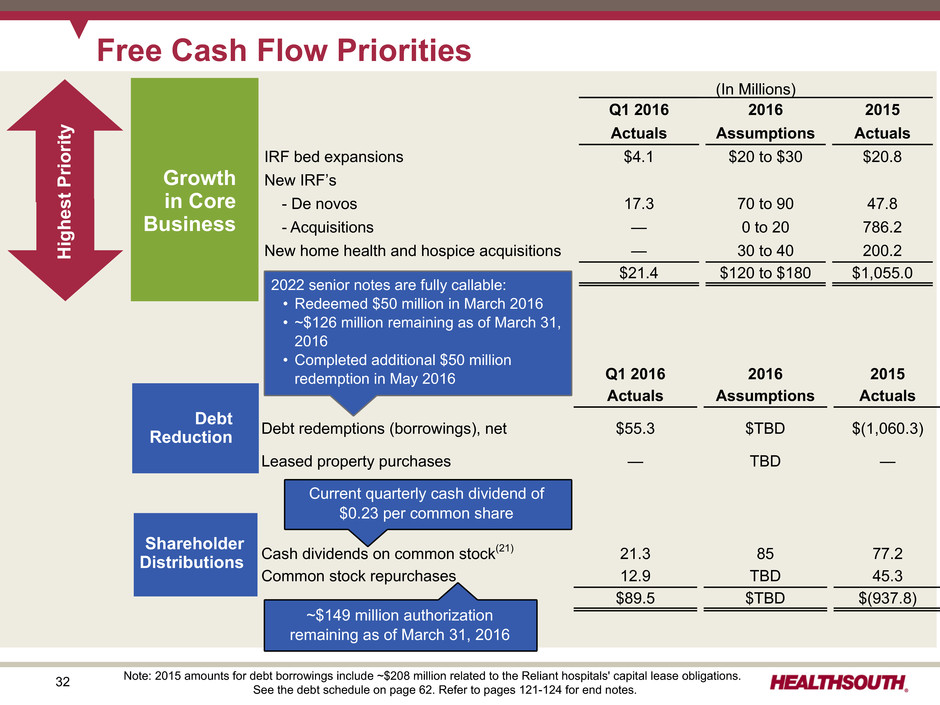
32 Note: 2015 amounts for debt borrowings include ~$208 million related to the Reliant hospitals' capital lease obligations.See the debt schedule on page 62. Refer to pages 121-124 for end notes. Free Cash Flow Priorities (In Millions) Q1 2016 2016 2015 Actuals Assumptions Actuals IRF bed expansions $4.1 $20 to $30 $20.8 New IRF’s - De novos 17.3 70 to 90 47.8 - Acquisitions — 0 to 20 786.2 New home health and hospice acquisitions — 30 to 40 200.2 $21.4 $120 to $180 $1,055.0 Q1 2016 2016 2015 Actuals Assumptions Actuals Debt redemptions (borrowings), net $55.3 $TBD $(1,060.3) Leased property purchases — TBD — Cash dividends on common stock(21) 21.3 85 77.2 Common stock repurchases 12.9 TBD 45.3 $89.5 $TBD $(937.8) Shareholder Distributions Growth in Core Business Debt Reduction Highest Priorit y 2022 senior notes are fully callable: • Redeemed $50 million in March 2016 • ~$126 million remaining as of March 31, 2016 • Completed additional $50 million redemption in May 2016 Current quarterly cash dividend of $0.23 per common share ~$149 million authorization remaining as of March 31, 2016
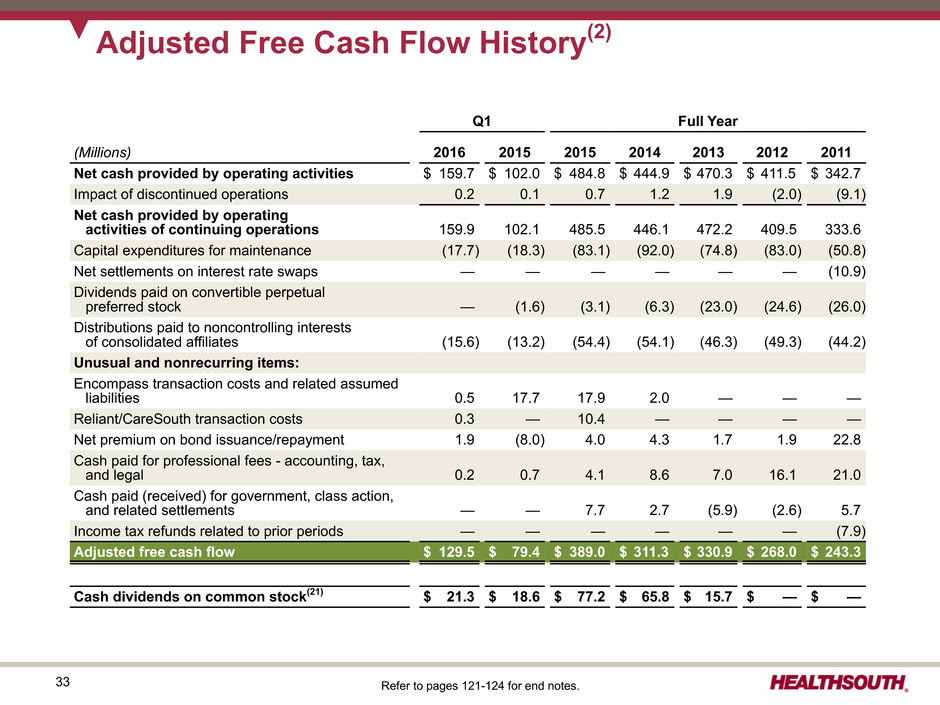
33 Adjusted Free Cash Flow History(2) Q1 Full Year (Millions) 2016 2015 2015 2014 2013 2012 2011 Net cash provided by operating activities $ 159.7 $ 102.0 $ 484.8 $ 444.9 $ 470.3 $ 411.5 $ 342.7 Impact of discontinued operations 0.2 0.1 0.7 1.2 1.9 (2.0) (9.1) Net cash provided by operating activities of continuing operations 159.9 102.1 485.5 446.1 472.2 409.5 333.6 Capital expenditures for maintenance (17.7) (18.3) (83.1) (92.0) (74.8) (83.0) (50.8) Net settlements on interest rate swaps — — — — — — (10.9) Dividends paid on convertible perpetual preferred stock — (1.6) (3.1) (6.3) (23.0) (24.6) (26.0) Distributions paid to noncontrolling interests of consolidated affiliates (15.6) (13.2) (54.4) (54.1) (46.3) (49.3) (44.2) Unusual and nonrecurring items: Encompass transaction costs and related assumed liabilities 0.5 17.7 17.9 2.0 — — — Reliant/CareSouth transaction costs 0.3 — 10.4 — — — — Net premium on bond issuance/repayment 1.9 (8.0) 4.0 4.3 1.7 1.9 22.8 Cash paid for professional fees - accounting, tax, and legal 0.2 0.7 4.1 8.6 7.0 16.1 21.0 Cash paid (received) for government, class action, and related settlements — — 7.7 2.7 (5.9) (2.6) 5.7 Income tax refunds related to prior periods — — — — — — (7.9) Adjusted free cash flow $ 129.5 $ 79.4 $ 389.0 $ 311.3 $ 330.9 $ 268.0 $ 243.3 Cash dividends on common stock(21) $ 21.3 $ 18.6 $ 77.2 $ 65.8 $ 15.7 $ — $ — Refer to pages 121-124 for end notes.
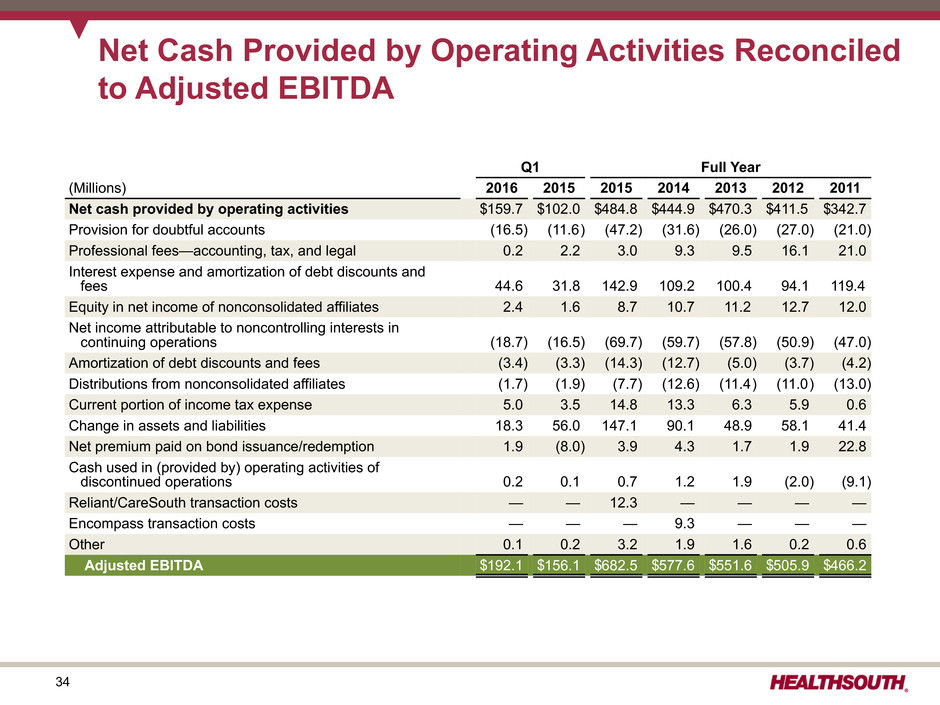
34 Net Cash Provided by Operating Activities Reconciled to Adjusted EBITDA Q1 Full Year (Millions) 2016 2015 2015 2014 2013 2012 2011 Net cash provided by operating activities $159.7 $102.0 $484.8 $444.9 $470.3 $411.5 $342.7 Provision for doubtful accounts (16.5) (11.6) (47.2) (31.6) (26.0) (27.0) (21.0) Professional fees—accounting, tax, and legal 0.2 2.2 3.0 9.3 9.5 16.1 21.0 Interest expense and amortization of debt discounts and fees 44.6 31.8 142.9 109.2 100.4 94.1 119.4 Equity in net income of nonconsolidated affiliates 2.4 1.6 8.7 10.7 11.2 12.7 12.0 Net income attributable to noncontrolling interests in continuing operations (18.7) (16.5) (69.7) (59.7) (57.8) (50.9) (47.0) Amortization of debt discounts and fees (3.4) (3.3) (14.3) (12.7) (5.0) (3.7) (4.2) Distributions from nonconsolidated affiliates (1.7) (1.9) (7.7) (12.6) (11.4) (11.0) (13.0) Current portion of income tax expense 5.0 3.5 14.8 13.3 6.3 5.9 0.6 Change in assets and liabilities 18.3 56.0 147.1 90.1 48.9 58.1 41.4 Net premium paid on bond issuance/redemption 1.9 (8.0) 3.9 4.3 1.7 1.9 22.8 Cash used in (provided by) operating activities of discontinued operations 0.2 0.1 0.7 1.2 1.9 (2.0) (9.1) Reliant/CareSouth transaction costs — — 12.3 — — — — Encompass transaction costs — — — 9.3 — — — Other 0.1 0.2 3.2 1.9 1.6 0.2 0.6 Adjusted EBITDA $192.1 $156.1 $682.5 $577.6 $551.6 $505.9 $466.2
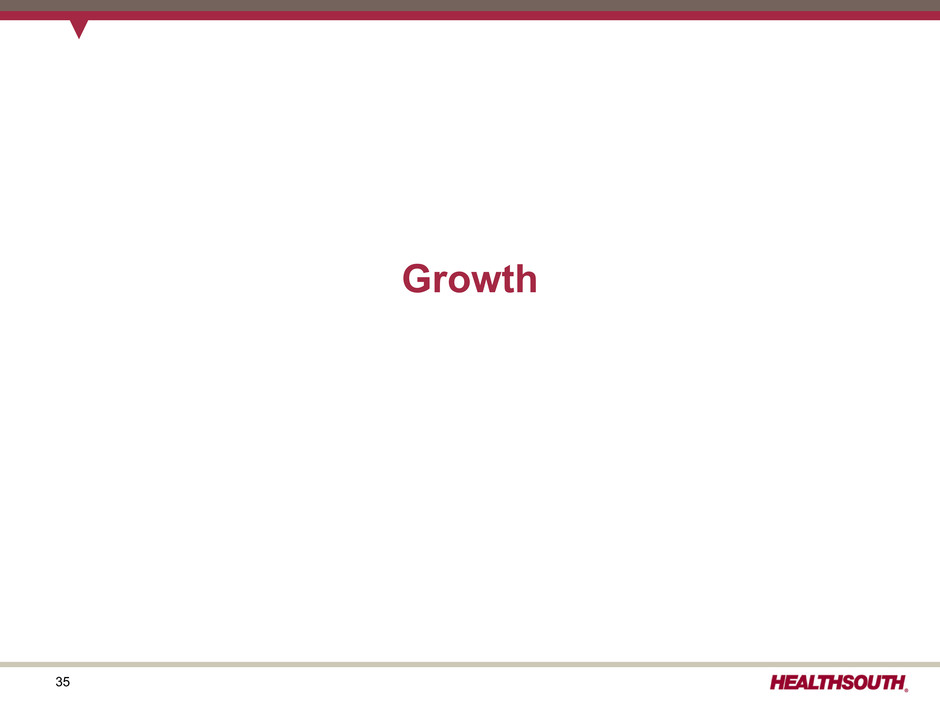
35 Growth
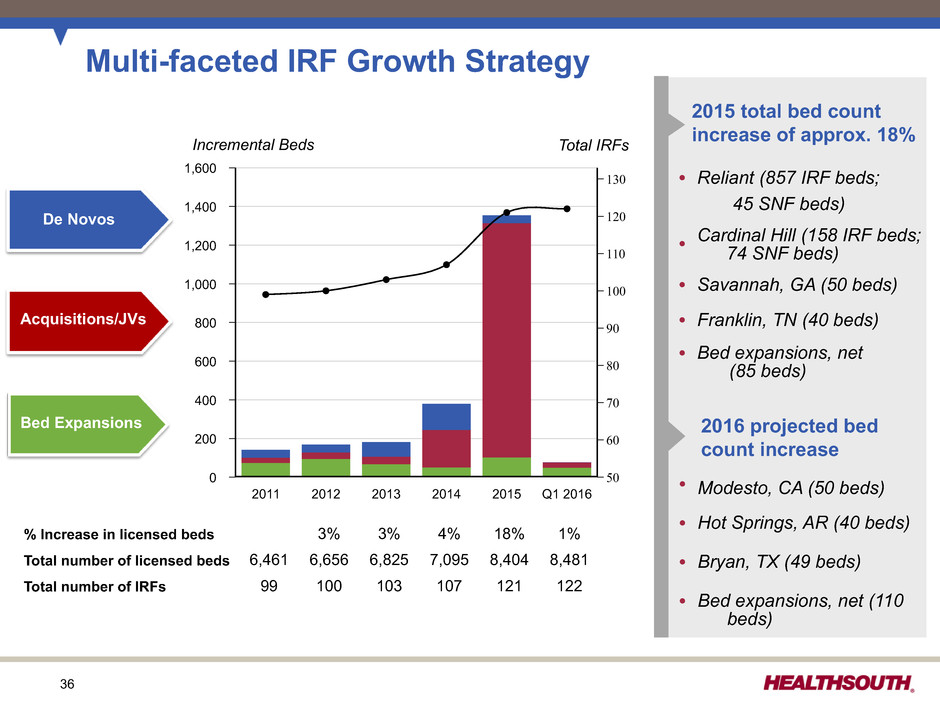
36 1,600 1,400 1,200 1,000 800 600 400 200 0 130 120 110 100 90 80 70 60 50 2011 2012 2013 2014 2015 Q1 2016 % Increase in licensed beds 3% 3% 4% 18% 1% Total number of licensed beds 6,461 6,656 6,825 7,095 8,404 8,481 Total number of IRFs 99 100 103 107 121 122 Multi-faceted IRF Growth Strategy 2015 total bed count increase of approx. 18% Ÿ Reliant (857 IRF beds; 45 SNF beds) Ÿ Cardinal Hill (158 IRF beds;74 SNF beds) Ÿ Savannah, GA (50 beds) Ÿ Franklin, TN (40 beds) Ÿ Bed expansions, net (85 beds) De Novos Acquisitions/JVs Bed Expansions Total IRFsIncremental Beds 2016 projected bed count increase Ÿ Modesto, CA (50 beds) Ÿ Hot Springs, AR (40 beds) Ÿ Bryan, TX (49 beds) Ÿ Bed expansions, net (110 beds)
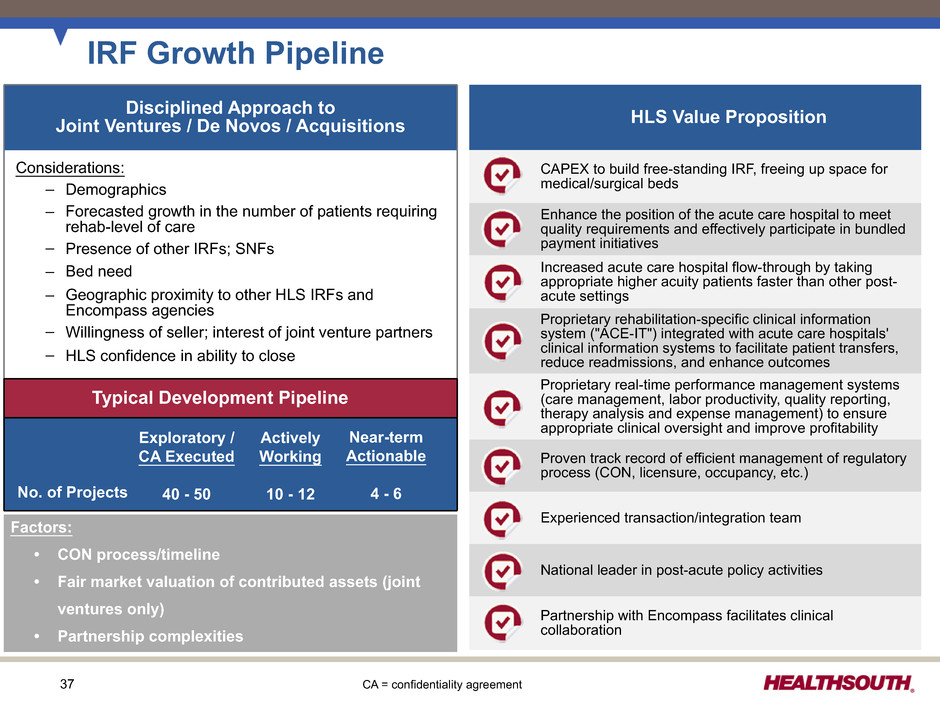
37 Disciplined Approach to Joint Ventures / De Novos / Acquisitions Considerations: – Demographics – Forecasted growth in the number of patients requiring rehab-level of care – Presence of other IRFs; SNFs – Bed need – Geographic proximity to other HLS IRFs and Encompass agencies – Willingness of seller; interest of joint venture partners – HLS confidence in ability to close CA = confidentiality agreement IRF Growth Pipeline Typical Development Pipeline Factors: • CON process/timeline • Fair market valuation of contributed assets (joint ventures only) • Partnership complexities HLS Value Proposition CAPEX to build free-standing IRF, freeing up space for medical/surgical beds Enhance the position of the acute care hospital to meet quality requirements and effectively participate in bundled payment initiatives Increased acute care hospital flow-through by taking appropriate higher acuity patients faster than other post- acute settings Proprietary rehabilitation-specific clinical information system ("ACE-IT") integrated with acute care hospitals' clinical information systems to facilitate patient transfers, reduce readmissions, and enhance outcomes Proprietary real-time performance management systems (care management, labor productivity, quality reporting, therapy analysis and expense management) to ensure appropriate clinical oversight and improve profitability Proven track record of efficient management of regulatory process (CON, licensure, occupancy, etc.) Experienced transaction/integration team National leader in post-acute policy activities Partnership with Encompass facilitates clinical collaboration No. of Projects Exploratory / CA Executed 40 - 50 Actively Working 10 - 12 Near-term Actionable 4 - 6
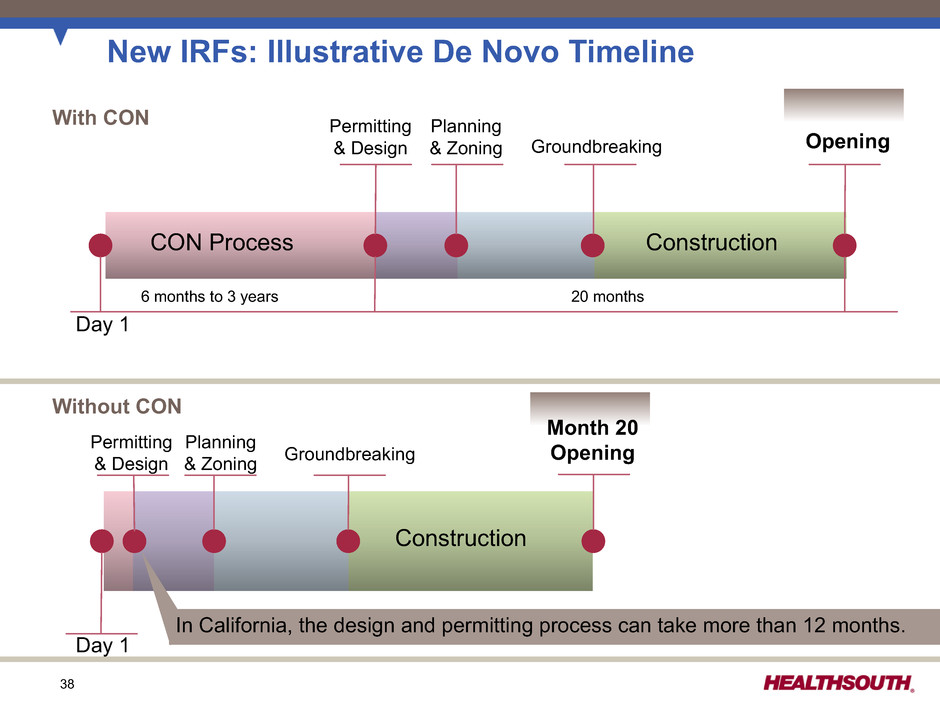
38 New IRFs: Illustrative De Novo Timeline Day 1 With CON Permitting & Design Planning & Zoning Groundbreaking Permitting & Design Planning & Zoning Groundbreaking Day 1 Without CON 6 months to 3 years 20 months CON Process Construction Construction Opening Month 20 Opening In California, the design and permitting process can take more than 12 months.
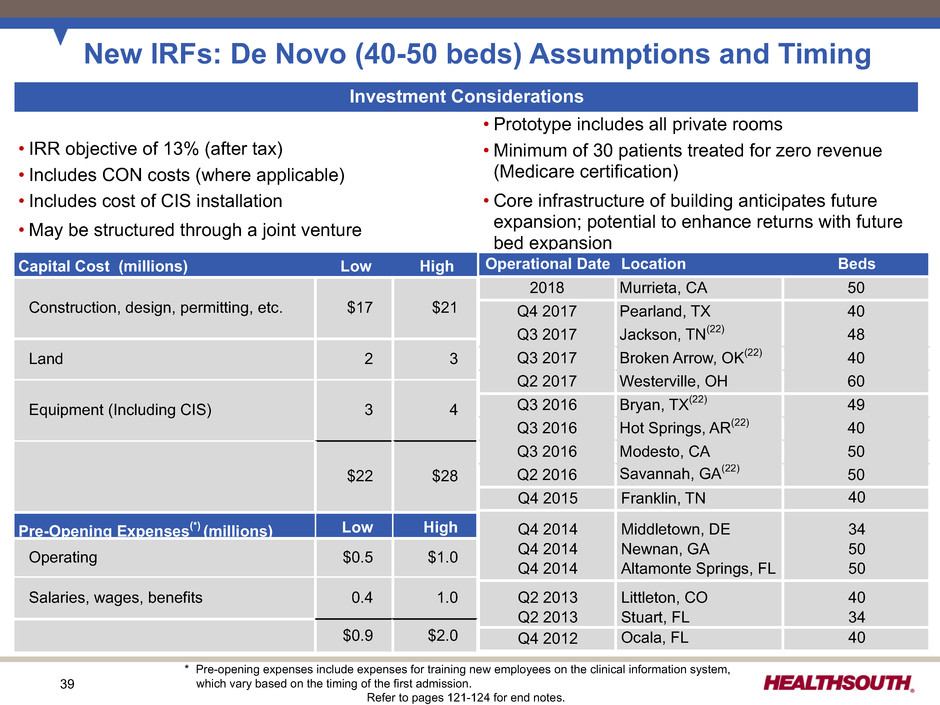
39 Investment Considerations • IRR objective of 13% (after tax) • Includes CON costs (where applicable) • Includes cost of CIS installation • May be structured through a joint venture • Prototype includes all private rooms • Minimum of 30 patients treated for zero revenue (Medicare certification) • Core infrastructure of building anticipates future expansion; potential to enhance returns with future bed expansion Capital Cost (millions) Low High Operational Date Location Beds Construction, design, permitting, etc. $17 $21 2018 Murrieta, CA 50 2017 Bryan, TX 30 2017 Jackson, TN(34) 48 Land 2 3 Q1 2017 Westerville, OH 60Q4 2016 Broken Arrow, OK(34) 40 Equipment (Including CIS) 3 4 Q2 2016 Hot Springs, AR(34) 40 Q2 2016 Savannah, GA(34) 50 Q2 2016 Modesto, CA 50 $22 $28 Q4 2015 Franklin, TN 40 Q4 2014 Q4 2014 Q4 2014 Middletown, DE Newnan, GA Altamonte Springs, FL 34 50 50 Pre-Opening Expenses(*) (millions) Low High Q2 2013 Q2 2013 Littleton, CO Stuart, FL 40 34Operating $0.5 $1.0 Q4 2012 Ocala, FL 40 Salaries, wages, benefits 0.4 1.0 Q4 2011 Cypress, TX 40 $0.9 $2.0 New IRFs: De Novo (40-50 beds) Assumptions and Timing * Pre-opening expenses include expenses for training new employees on the clinical information system, which vary based on the timing of the first admission. Refer to pages 121-124 for end notes. Operational Date Location Beds 2018 Murrieta, CA 50 Q4 2017 Pearland, TX 40 Q3 2017 Jackson, TN(22) 48 Q3 2017 Broken Arrow, OK(22) 40 Q2 2017 Westerville, OH 60 Q3 2016 Bryan, TX(22) 49 Q3 2016 Hot Springs, AR(22) 40 Q3 2016 Modesto, CA 50 Q2 2016 Savannah, GA(22) 50 Q4 2015 Franklin, TN 40 Q4 2014 Q4 2014 Q4 2014 Middletown, DE Newnan, GA Altamonte Springs, FL 34 50 50 Q2 2013 Q2 2013 Littleton, CO Stuart, FL 40 34 Q4 2012 Ocala, FL 40
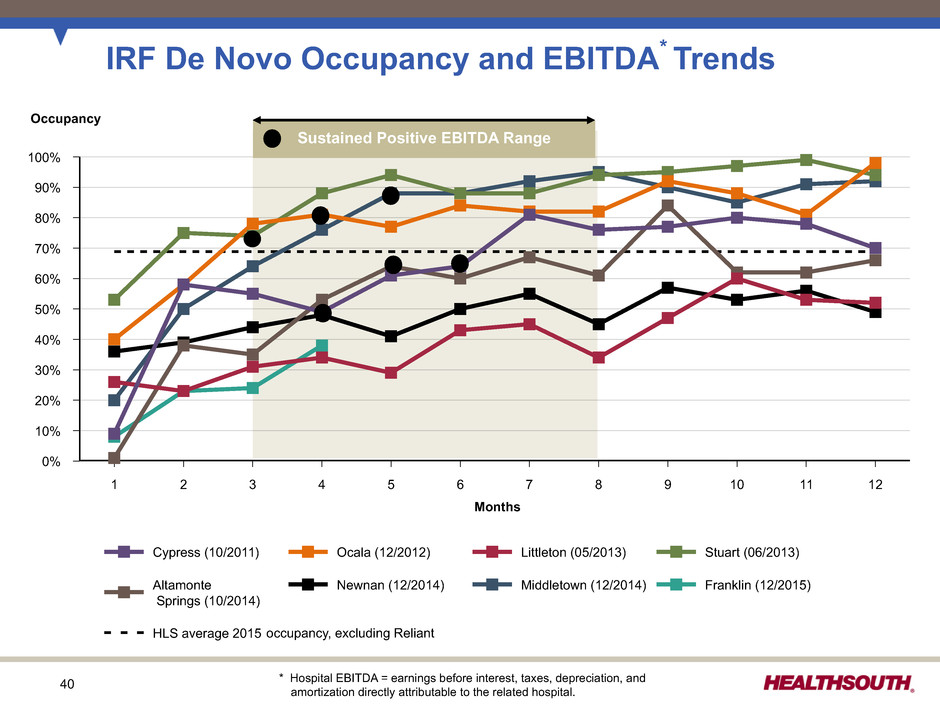
40 Cypress (10/2011) Ocala (12/2012) Littleton (05/2013) Stuart (06/2013) Altamonte Springs (10/2014) Newnan (12/2014) Middletown (12/2014) Franklin (12/2015) HLS average 2015 100% 90% 80% 70% 60% 50% 40% 30% 20% 10% 0% 1 2 3 4 5 6 7 8 9 10 11 12 Months IRF De Novo Occupancy and EBITDA* Trends Occupancy Sustained Positive EBITDA Range * Hospital EBITDA = earnings before interest, taxes, depreciation, and amortization directly attributable to the related hospital. occupancy, excluding Reliant
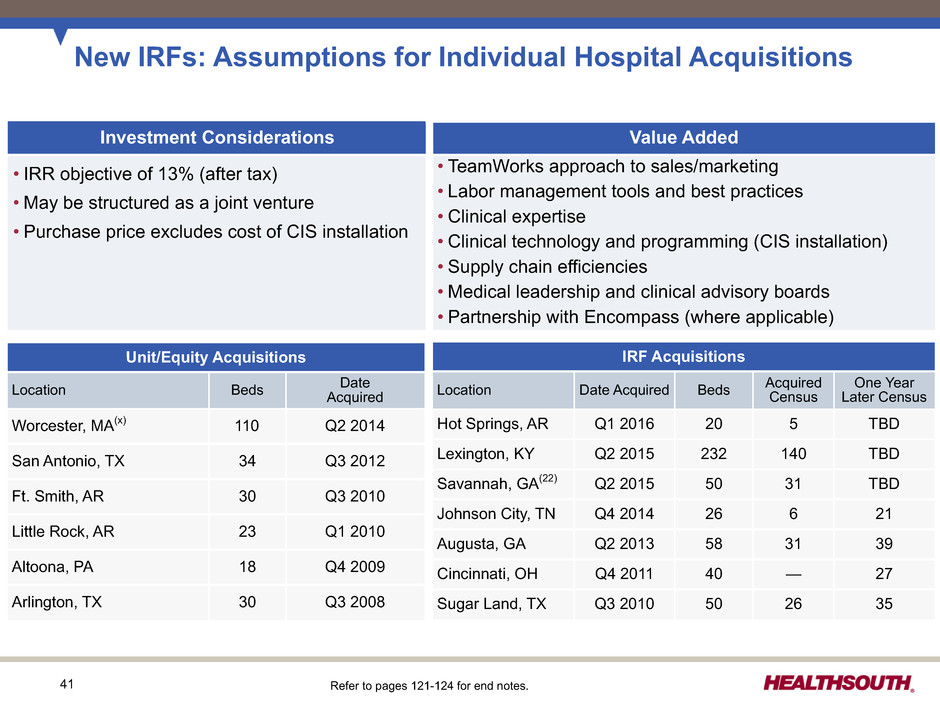
41 New IRFs: Assumptions for Individual Hospital Acquisitions Unit/Equity Acquisitions Location Beds DateAcquired Worcester, MA(x) 110 Q2 2014 San Antonio, TX 34 Q3 2012 Ft. Smith, AR 30 Q3 2010 Little Rock, AR 23 Q1 2010 Altoona, PA 18 Q4 2009 Arlington, TX 30 Q3 2008 IRF Acquisitions Location Date Acquired Beds AcquiredCensus One Year Later Census Hot Springs, AR Q1 2016 20 5 TBD Lexington, KY Q2 2015 232 140 TBD Savannah, GA(22) Q2 2015 50 31 TBD Johnson City, TN Q4 2014 26 6 21 Augusta, GA Q2 2013 58 31 39 Cincinnati, OH Q4 2011 40 — 27 Sugar Land, TX Q3 2010 50 26 35 Investment Considerations Value Added • IRR objective of 13% (after tax) • May be structured as a joint venture • Purchase price excludes cost of CIS installation • TeamWorks approach to sales/marketing • Labor management tools and best practices • Clinical expertise • Clinical technology and programming (CIS installation) • Supply chain efficiencies • Medical leadership and clinical advisory boards • Partnership with Encompass (where applicable) Refer to pages 121-124 for end notes.
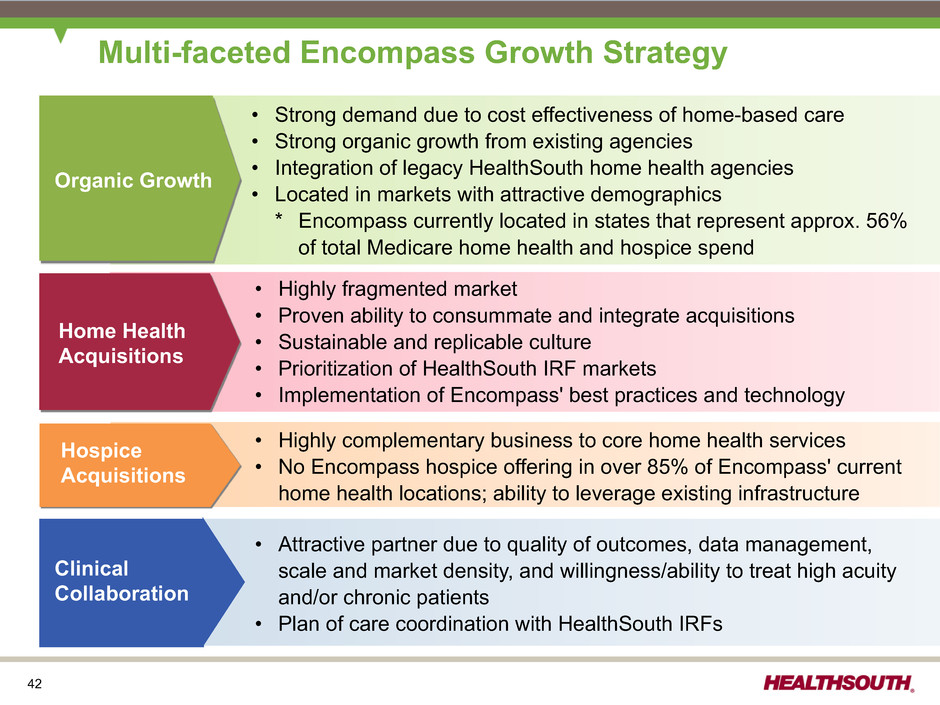
42 Organic Growth • Strong demand due to cost effectiveness of home-based care • Strong organic growth from existing agencies • Integration of legacy HealthSouth home health agencies • Located in markets with attractive demographics * Encompass currently located in states that represent approx. 56% of total Medicare home health and hospice spend • Attractive partner due to quality of outcomes, data management, scale and market density, and willingness/ability to treat high acuity and/or chronic patients • Plan of care coordination with HealthSouth IRFs Cost Assessment • Highly fragmented market • Proven ability to consummate and integrate acquisitions • Sustainable and replicable culture • Prioritization of HealthSouth IRF markets • Implementation of Encompass' best practices and technology Home Health Acquisitions Hospice Acquisitions Clinical Collaboration Multi-faceted Encompass Growth Strategy • Highly complementary business to core home health services • No Encompass hospice offering in over 85% of Encompass' current home health locations; ability to leverage existing infrastructure
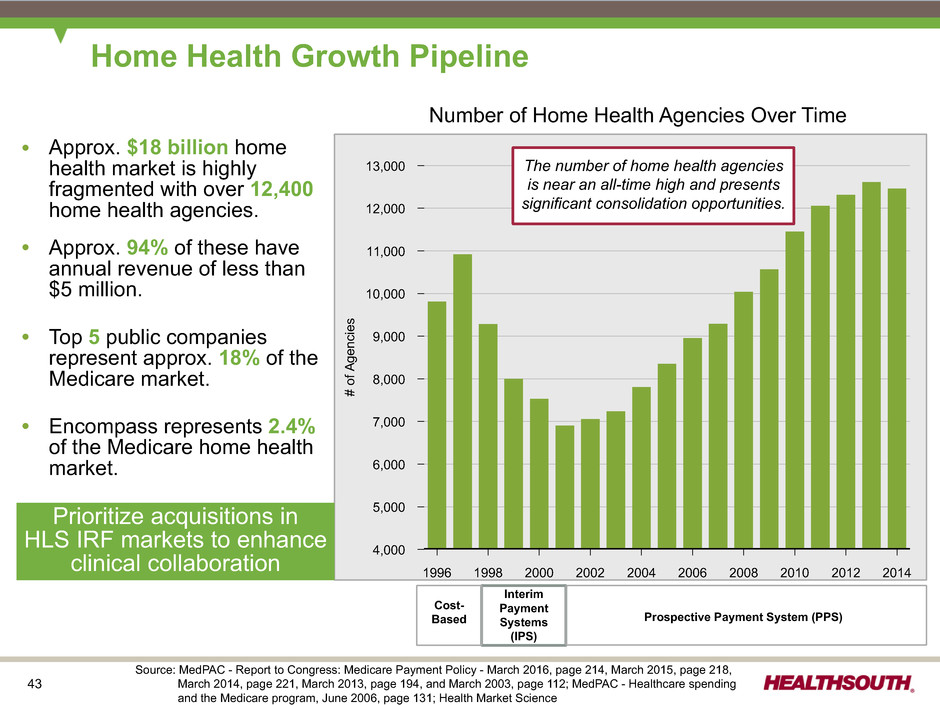
43 13,000 12,000 11,000 10,000 9,000 8,000 7,000 6,000 5,000 4,000 # of Ag en ci es 1996 1998 2000 2002 2004 2006 2008 2010 2012 2014 Home Health Growth Pipeline Ÿ Approx. $18 billion home health market is highly fragmented with over 12,400 home health agencies. Ÿ Approx. 94% of these have annual revenue of less than $5 million. Ÿ Top 5 public companies represent approx. 18% of the Medicare market. Ÿ Encompass represents 2.4% of the Medicare home health market. Prioritize acquisitions in HLS IRF markets to enhance clinical collaboration Number of Home Health Agencies Over Time Cost- Based Interim Payment Systems (IPS) Prospective Payment System (PPS) The number of home health agencies is near an all-time high and presents significant consolidation opportunities. Source: MedPAC - Report to Congress: Medicare Payment Policy - March 2016, page 214, March 2015, page 218, March 2014, page 221, March 2013, page 194, and March 2003, page 112; MedPAC - Healthcare spending and the Medicare program, June 2006, page 131; Health Market Science
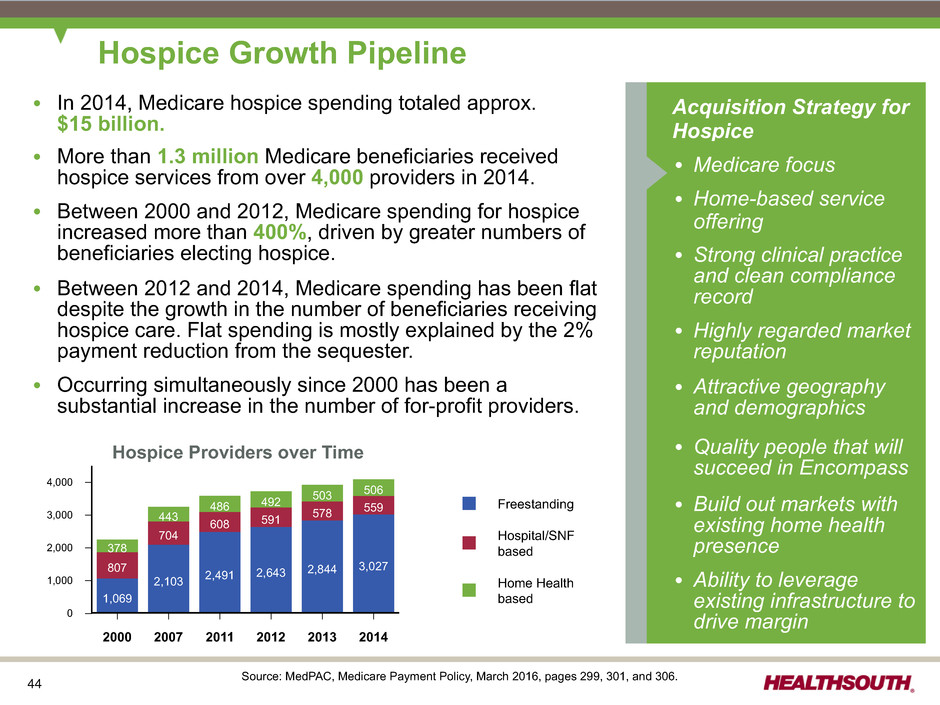
44 Freestanding Hospital/SNF based Home Health based 4,000 3,000 2,000 1,000 0 2000 2007 2011 2012 2013 2014 1,069 2,103 2,491 2,643 2,844 3,027807 704 608 591 578 559 378 443 486 492 503 506 Hospice Growth Pipeline Ÿ In 2014, Medicare hospice spending totaled approx. $15 billion. Ÿ More than 1.3 million Medicare beneficiaries received hospice services from over 4,000 providers in 2014. Ÿ Between 2000 and 2012, Medicare spending for hospice increased more than 400%, driven by greater numbers of beneficiaries electing hospice. Ÿ Between 2012 and 2014, Medicare spending has been flat despite the growth in the number of beneficiaries receiving hospice care. Flat spending is mostly explained by the 2% payment reduction from the sequester. Ÿ Occurring simultaneously since 2000 has been a substantial increase in the number of for-profit providers. Acquisition Strategy for Hospice Ÿ Medicare focus Ÿ Home-based service offering Ÿ Strong clinical practice and clean compliance record Ÿ Highly regarded market reputation Ÿ Attractive geography and demographics Ÿ Quality people that will succeed in Encompass Ÿ Build out markets with existing home health presence Ÿ Ability to leverage existing infrastructure to drive margin Hospice Providers over Time Source: MedPAC, Medicare Payment Policy, March 2016, pages 299, 301, and 306.
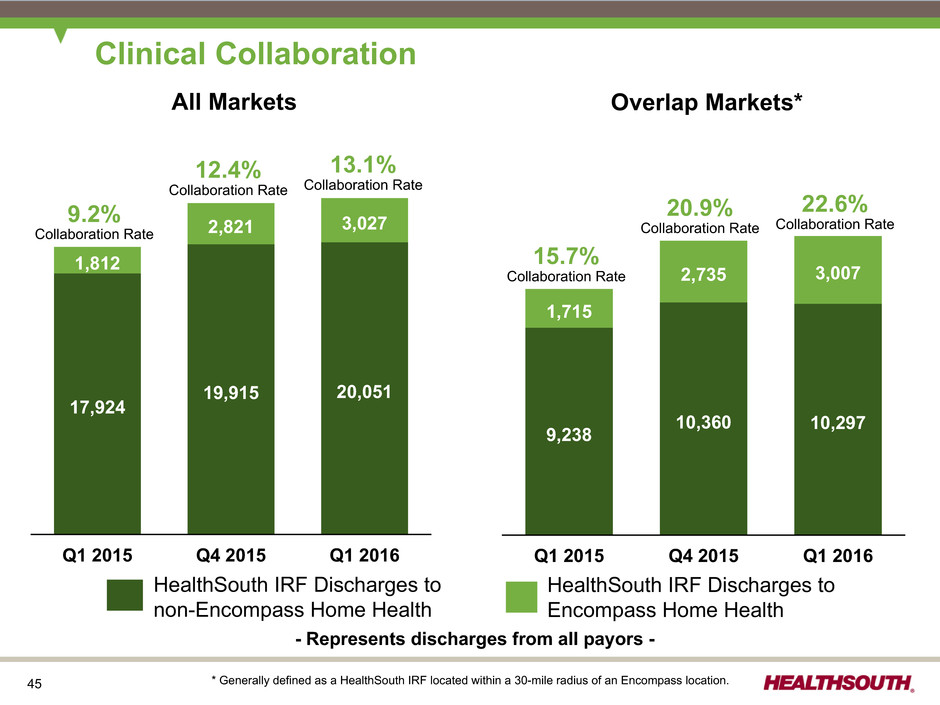
45 Clinical Collaboration All Markets Q1 2015 Q4 2015 Q1 2016 17,924 19,915 20,051 1,812 2,821 3,0279.2%Collaboration Rate 12.4% Collaboration Rate 13.1% Collaboration Rate Overlap Markets* Q1 2015 Q4 2015 Q1 2016 9,238 10,360 10,297 1,715 2,735 3,007 15.7% Collaboration Rate 20.9% Collaboration Rate 22.6% Collaboration Rate HealthSouth IRF Discharges to non-Encompass Home Health HealthSouth IRF Discharges to Encompass Home Health * Generally defined as a HealthSouth IRF located within a 30-mile radius of an Encompass location. - Represents discharges from all payors -
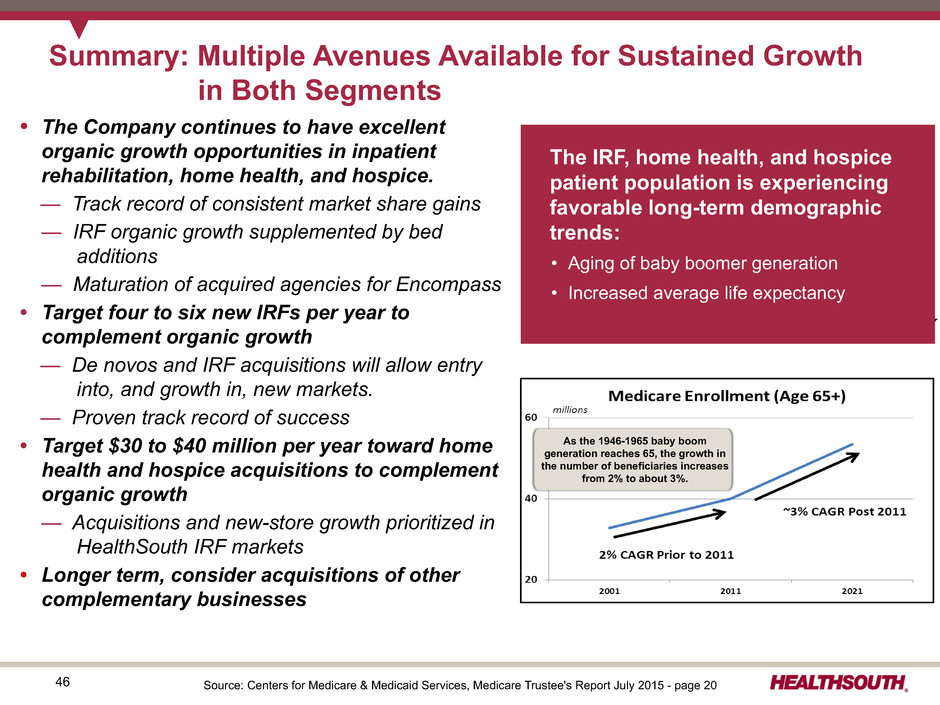
46 Summary: Multiple Avenues Available for Sustained Growth in Both Segments • The Company continues to have excellent organic growth opportunities in inpatient rehabilitation, home health, and hospice. — Track record of consistent market share gains — IRF organic growth supplemented by bed additions — Maturation of acquired agencies for Encompass • Target four to six new IRFs per year to complement organic growth — De novos and IRF acquisitions will allow entry into, and growth in, new markets. — Proven track record of success • Target $30 to $40 million per year toward home health and hospice acquisitions to complement organic growth — Acquisitions and new-store growth prioritized in HealthSouth IRF markets • Longer term, consider acquisitions of other complementary businesses As the 1946-1965 baby boom generation reaches 65, the growth in the number of beneficiaries increases from 2% to about 3%. Source: Centers for Medicare & Medicaid Services, Medicare Trustee's Report July 2015 - page 20 The IRF, home health, and hospice patient population is experiencing favorable long-term demographic trends: • Aging of baby boomer generation • Increased average life expectancy
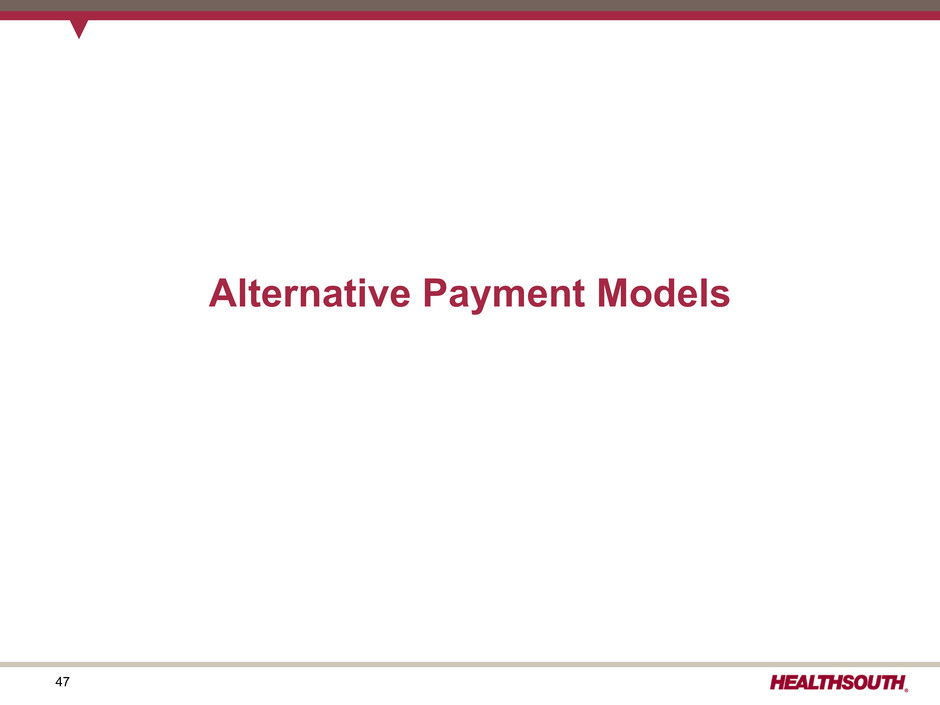
47 Alternative Payment Models
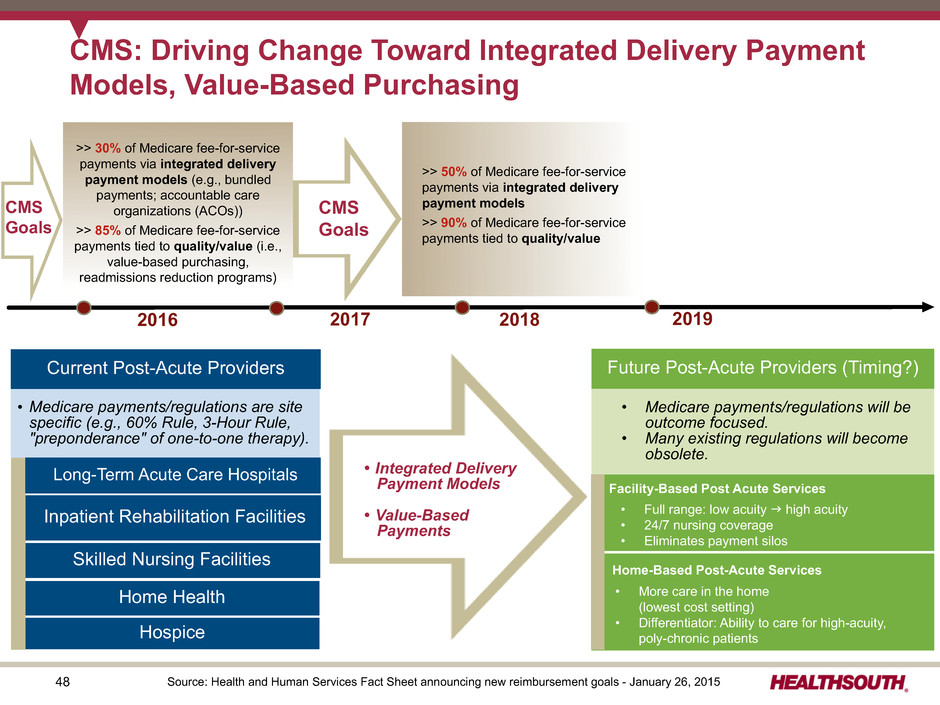
48 CMS: Driving Change Toward Integrated Delivery Payment Models, Value-Based Purchasing Future Post-Acute Providers (Timing?) Inpatient Rehabilitation Facilities Home Health Skilled Nursing Facilities Hospice • Full range: low acuity g high acuity • 24/7 nursing coverage • Eliminates payment silos Home-Based Post-Acute Services • More care in the home (lowest cost setting) • Differentiator: Ability to care for high-acuity, poly-chronic patients >> 50% of Medicare fee-for-service payments via integrated delivery payment models >> 90% of Medicare fee-for-service payments tied to quality/value Ÿ Integrated Delivery Payment Models Ÿ Value-Based Payments Current Post-Acute Providers • Medicare payments/regulations are site specific (e.g., 60% Rule, 3-Hour Rule, "preponderance" of one-to-one therapy). • Medicare payments/regulations will be outcome focused. • Many existing regulations will become obsolete. Facility-Based Post Acute Services >> 30% of Medicare fee-for-service payments via integrated delivery payment models (e.g., bundled payments; accountable care organizations (ACOs)) >> 85% of Medicare fee-for-service payments tied to quality/value (i.e., value-based purchasing, readmissions reduction programs) 2017 Long-Term Acute Care Hospitals 2016 Source: Health and Human Services Fact Sheet announcing new reimbursement goals - January 26, 2015 CMS Goals 2018 2019 CMS Goals
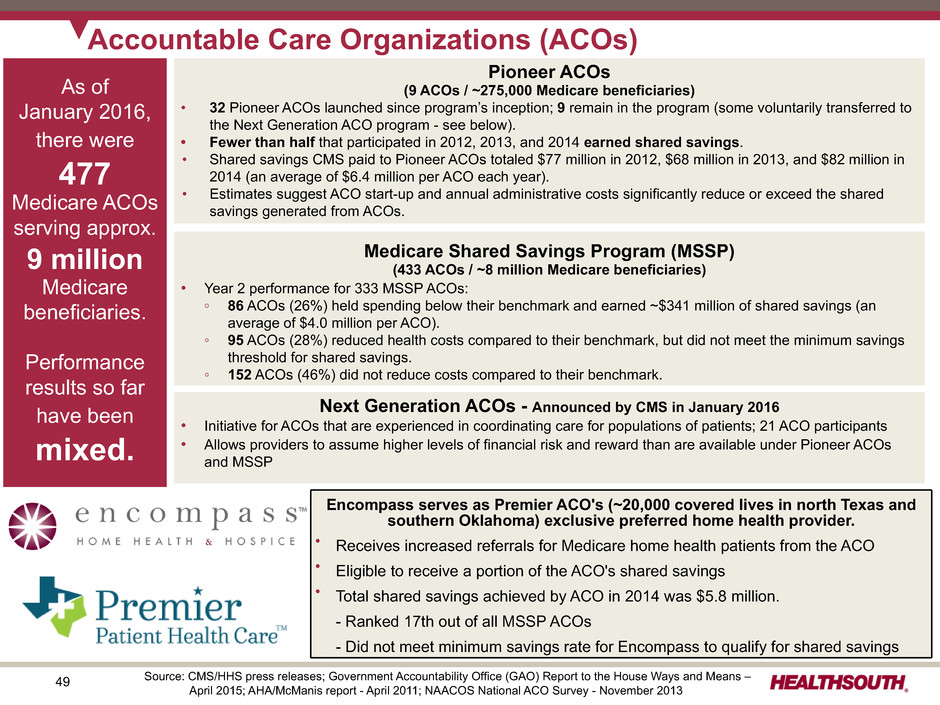
49 Accountable Care Organizations (ACOs) As of January 2016, there were 477 Medicare ACOs serving approx. 9 million Medicare beneficiaries. Performance results so far have been mixed. Pioneer ACOs (9 ACOs / ~275,000 Medicare beneficiaries) • 32 Pioneer ACOs launched since program’s inception; 9 remain in the program (some voluntarily transferred to the Next Generation ACO program - see below). • Fewer than half that participated in 2012, 2013, and 2014 earned shared savings. • Shared savings CMS paid to Pioneer ACOs totaled $77 million in 2012, $68 million in 2013, and $82 million in 2014 (an average of $6.4 million per ACO each year). • Estimates suggest ACO start-up and annual administrative costs significantly reduce or exceed the shared savings generated from ACOs. Medicare Shared Savings Program (MSSP) (433 ACOs / ~8 million Medicare beneficiaries) • Year 2 performance for 333 MSSP ACOs: ◦ 86 ACOs (26%) held spending below their benchmark and earned ~$341 million of shared savings (an average of $4.0 million per ACO). ◦ 95 ACOs (28%) reduced health costs compared to their benchmark, but did not meet the minimum savings threshold for shared savings. ◦ 152 ACOs (46%) did not reduce costs compared to their benchmark. Source: CMS/HHS press releases; Government Accountability Office (GAO) Report to the House Ways and Means – April 2015; AHA/McManis report - April 2011; NAACOS National ACO Survey - November 2013 Encompass serves as Premier ACO's (~20,000 covered lives in north Texas and southern Oklahoma) exclusive preferred home health provider. Ÿ Receives increased referrals for Medicare home health patients from the ACO Ÿ Eligible to receive a portion of the ACO's shared savings Ÿ Total shared savings achieved by ACO in 2014 was $5.8 million. - Ranked 17th out of all MSSP ACOs - Did not meet minimum savings rate for Encompass to qualify for shared savings Next Generation ACOs - Announced by CMS in January 2016 • Initiative for ACOs that are experienced in coordinating care for populations of patients; 21 ACO participants • Allows providers to assume higher levels of financial risk and reward than are available under Pioneer ACOs and MSSP
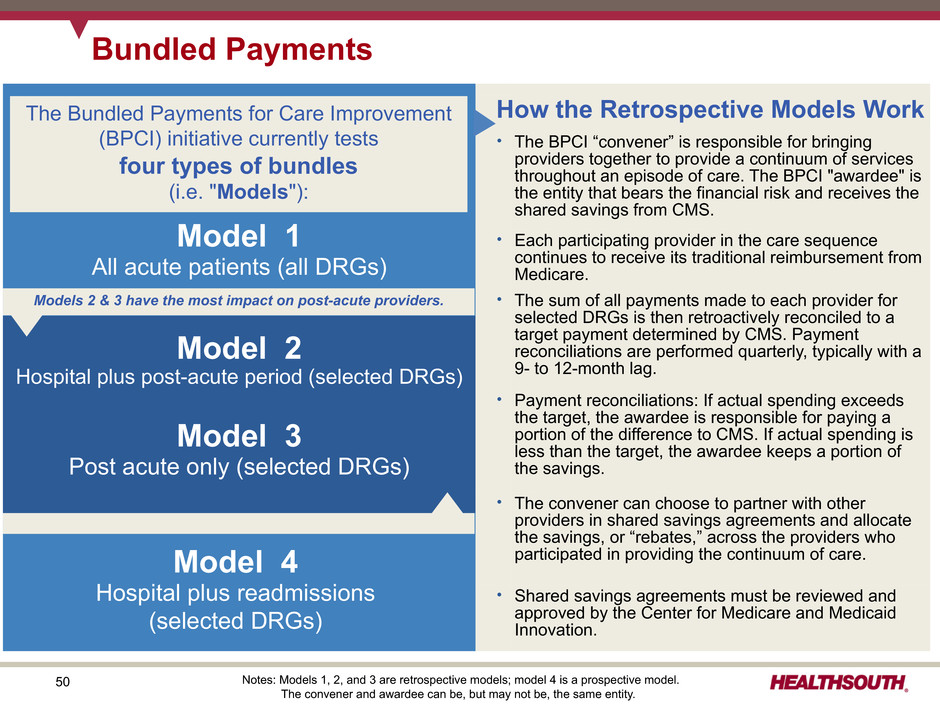
50 Bundled Payments How the Retrospective Models Work Ÿ The BPCI “convener” is responsible for bringing providers together to provide a continuum of services throughout an episode of care. The BPCI "awardee" is the entity that bears the financial risk and receives the shared savings from CMS. Ÿ Each participating provider in the care sequence continues to receive its traditional reimbursement from Medicare. Ÿ The sum of all payments made to each provider for selected DRGs is then retroactively reconciled to a target payment determined by CMS. Payment reconciliations are performed quarterly, typically with a 9- to 12-month lag. Ÿ Payment reconciliations: If actual spending exceeds the target, the awardee is responsible for paying a portion of the difference to CMS. If actual spending is less than the target, the awardee keeps a portion of the savings. Ÿ The convener can choose to partner with other providers in shared savings agreements and allocate the savings, or “rebates,” across the providers who participated in providing the continuum of care. Ÿ Shared savings agreements must be reviewed and approved by the Center for Medicare and Medicaid Innovation. Model 1 All acute patients (all DRGs) The Bundled Payments for Care Improvement (BPCI) initiative currently tests four types of bundles (i.e. "Models"): Models 2 & 3 have the most impact on post-acute providers. Model 2 Hospital plus post-acute period (selected DRGs) Model 3 Post acute only (selected DRGs) Model 4 Hospital plus readmissions (selected DRGs) Notes: Models 1, 2, and 3 are retrospective models; model 4 is a prospective model. The convener and awardee can be, but may not be, the same entity.
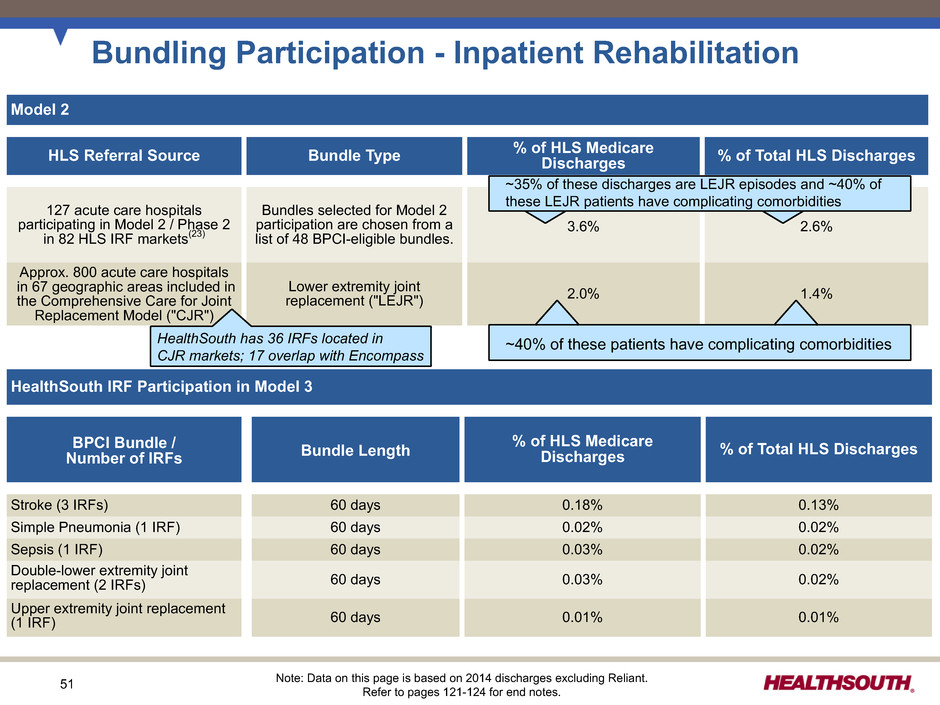
51 Model 2 HLS Referral Source Bundle Type % of HLS MedicareDischarges % of Total HLS Discharges 127 acute care hospitals participating in Model 2 / Phase 2 in 82 HLS IRF markets(23) Bundles selected for Model 2 participation are chosen from a list of 48 BPCI-eligible bundles. 3.6% 2.6% Approx. 800 acute care hospitals in 67 geographic areas included in the Comprehensive Care for Joint Replacement Model ("CJR") Lower extremity joint replacement ("LEJR") 2.0% 1.4% HealthSouth has 36 IRFs located in CJR markets; 17 overlap with Encompass Bundling Participation - Inpatient Rehabilitation HealthSouth IRF Participation in Model 3 BPCI Bundle / Number of IRFs Bundle Length % of HLS Medicare Discharges % of Total HLS Discharges Stroke (3 IRFs) 60 days 0.18% 0.13% Simple Pneumonia (1 IRF) 60 days 0.02% 0.02% Sepsis (1 IRF) 60 days 0.03% 0.02% Double-lower extremity joint replacement (2 IRFs) 60 days 0.03% 0.02% Upper extremity joint replacement (1 IRF) 60 days 0.01% 0.01% Note: Data on this page is based on 2014 discharges excluding Reliant. Refer to pages 121-124 for end notes. ~40% of these patients have complicating comorbidities ~35% of these discharges are LEJR episodes and ~40% of these LEJR patients have complicating comorbidities

52 Bundling Participation - Home Health and Hospice The CJR Model represents a significant opportunity for Encompass because home health agencies are expected to capture additional share as discharges bypass SNFs altogether or lower the length of stay in a SNF. 52 Encompass providers have selected the following bundle types for participation in Model 3. Number of BPCI Bundles Selected Anticipated Home Health Episodes per Year % of Total Encompass Episodes per Year Major joint replacement of the lower extremity 13 925 0.56% Simple pneumonia and respiratory infections 8 207 0.13% Spinal fusion (non-cervical) 4 117 0.07% Revision of the hip or knee 6 99 0.06% Sepsis 5 96 0.06% Urinary tract infection 3 82 0.05% Chronic obstructive pulmonary disease 4 74 0.05% Other respiratory 8 64 0.04% Major joint replacement of the upper extremity 4 60 0.04% Congestive heart failure 5 60 0.04% All Other Episode Types 40 244 0.14% Total 100 2,028 1.2% Note: Data represents Encompass projections using 2014 data.
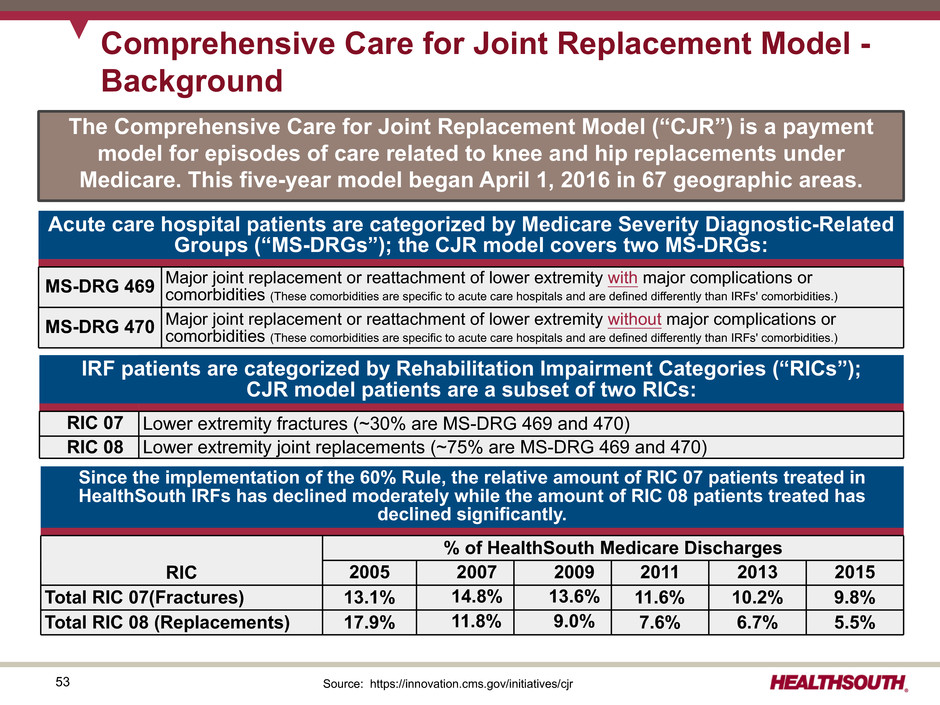
53 Comprehensive Care for Joint Replacement Model - Background Source: https://innovation.cms.gov/initiatives/cjr The Comprehensive Care for Joint Replacement Model (“CJR”) is a payment model for episodes of care related to knee and hip replacements under Medicare. This five-year model began April 1, 2016 in 67 geographic areas. Acute care hospital patients are categorized by Medicare Severity Diagnostic-Related Groups (“MS-DRGs”); the CJR model covers two MS-DRGs: MS-DRG 469 Major joint replacement or reattachment of lower extremity with major complications orcomorbidities (These comorbidities are specific to acute care hospitals and are defined differently than IRFs' comorbidities.) MS-DRG 470 Major joint replacement or reattachment of lower extremity without major complications orcomorbidities (These comorbidities are specific to acute care hospitals and are defined differently than IRFs' comorbidities.) IRF patients are categorized by Rehabilitation Impairment Categories (“RICs”); CJR model patients are a subset of two RICs: RIC 07 Lower extremity fractures (~30% are MS-DRG 469 and 470) RIC 08 Lower extremity joint replacements (~75% are MS-DRG 469 and 470) Since the implementation of the 60% Rule, the relative amount of RIC 07 patients treated in HealthSouth IRFs has declined moderately while the amount of RIC 08 patients treated has declined significantly. RIC % of HealthSouth Medicare Discharges 2005 2007 2009 2011 2013 2015 Total RIC 07(Fractures) 13.1% 14.8% 13.6% 11.6% 10.2% 9.8% Total RIC 08 (Replacements) 17.9% 11.8% 9.0% 7.6% 6.7% 5.5%
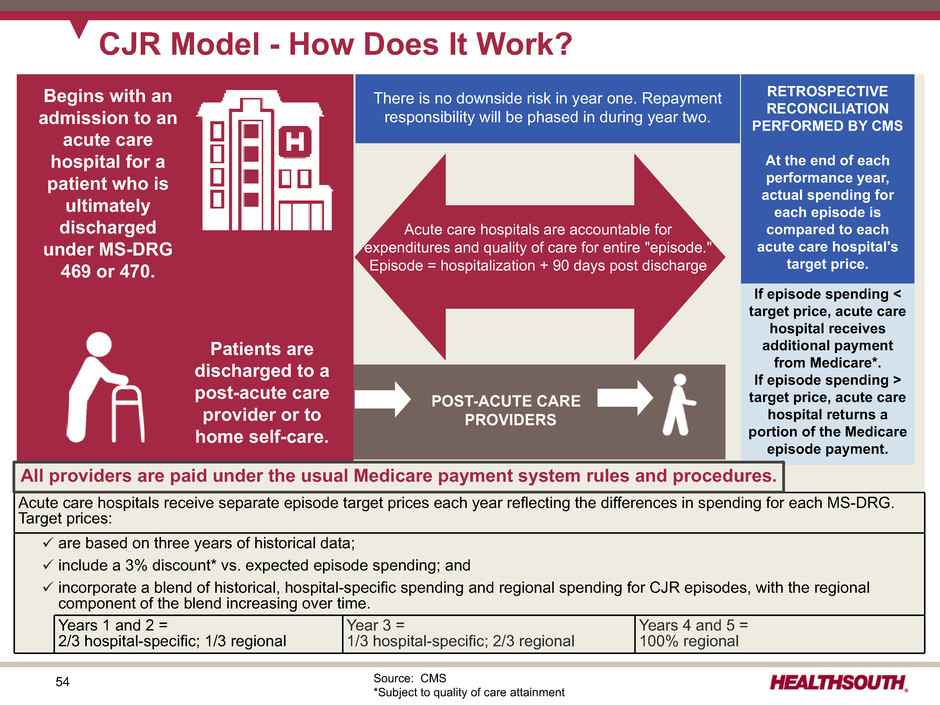
54 If episode spending < target price, acute care hospital receives additional payment from Medicare*. If episode spending > target price, acute care hospital returns a portion of the Medicare episode payment. CJR Model - How Does It Work? POST-ACUTE CARE PROVIDERS Acute care hospitals are accountable for expenditures and quality of care for entire "episode." Episode = hospitalization + 90 days post discharge Begins with an admission to an acute care hospital for a patient who is ultimately discharged under MS-DRG 469 or 470. Acute care hospitals receive separate episode target prices each year reflecting the differences in spending for each MS-DRG. Target prices: ü are based on three years of historical data; ü include a 3% discount* vs. expected episode spending; and ü incorporate a blend of historical, hospital-specific spending and regional spending for CJR episodes, with the regional component of the blend increasing over time. Years 1 and 2 = 2/3 hospital-specific; 1/3 regional Year 3 = 1/3 hospital-specific; 2/3 regional Years 4 and 5 = 100% regional RETROSPECTIVE RECONCILIATION PERFORMED BY CMS At the end of each performance year, actual spending for each episode is compared to each acute care hospital's target price. There is no downside risk in year one. Repayment responsibility will be phased in during year two. All providers are paid under the usual Medicare payment system rules and procedures. Patients are discharged to a post-acute care provider or to home self-care. Source: CMS *Subject to quality of care attainment
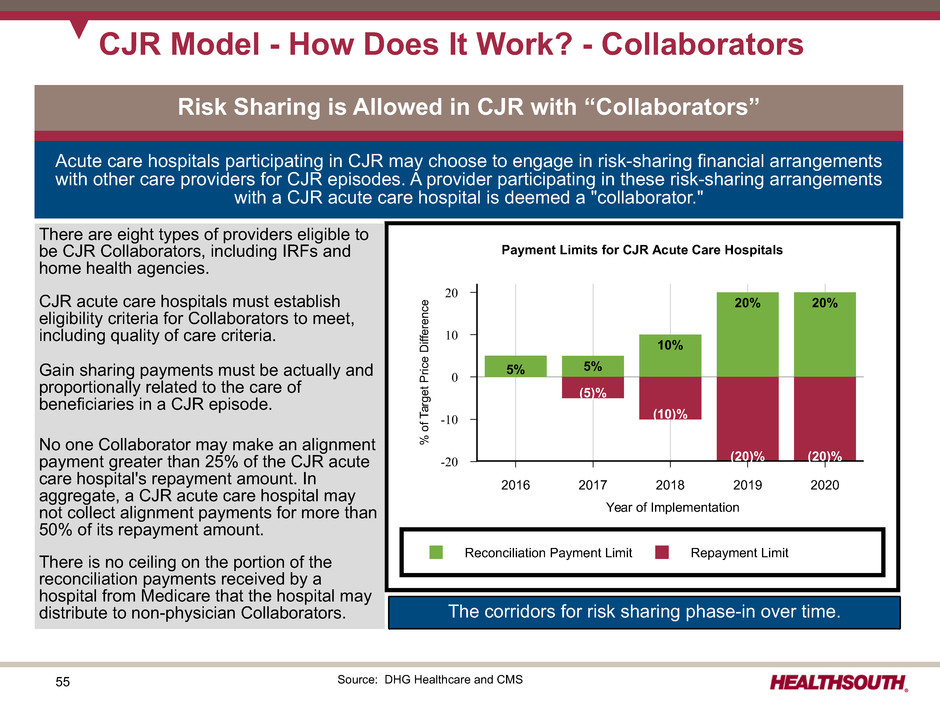
55 CJR Model - How Does It Work? - Collaborators Reconciliation Payment Limit Repayment Limit Payment Limits for CJR Acute Care Hospitals 20 10 0 -10 -20 % of Ta rg et Pr ic e D iff er en ce 2016 2017 2018 2019 2020 Year of Implementation 5% 5% 10% 20% 20% (5)% (10)% (20)% (20)% Risk Sharing is Allowed in CJR with “Collaborators” Acute care hospitals participating in CJR may choose to engage in risk-sharing financial arrangements with other care providers for CJR episodes. A provider participating in these risk-sharing arrangements with a CJR acute care hospital is deemed a "collaborator." There are eight types of providers eligible to be CJR Collaborators, including IRFs and home health agencies. CJR acute care hospitals must establish eligibility criteria for Collaborators to meet, including quality of care criteria. Gain sharing payments must be actually and proportionally related to the care of beneficiaries in a CJR episode. No one Collaborator may make an alignment payment greater than 25% of the CJR acute care hospital's repayment amount. In aggregate, a CJR acute care hospital may not collect alignment payments for more than 50% of its repayment amount. There is no ceiling on the portion of the reconciliation payments received by a hospital from Medicare that the hospital may distribute to non-physician Collaborators. Source: DHG Healthcare and CMS The corridors for risk sharing phase-in over time.
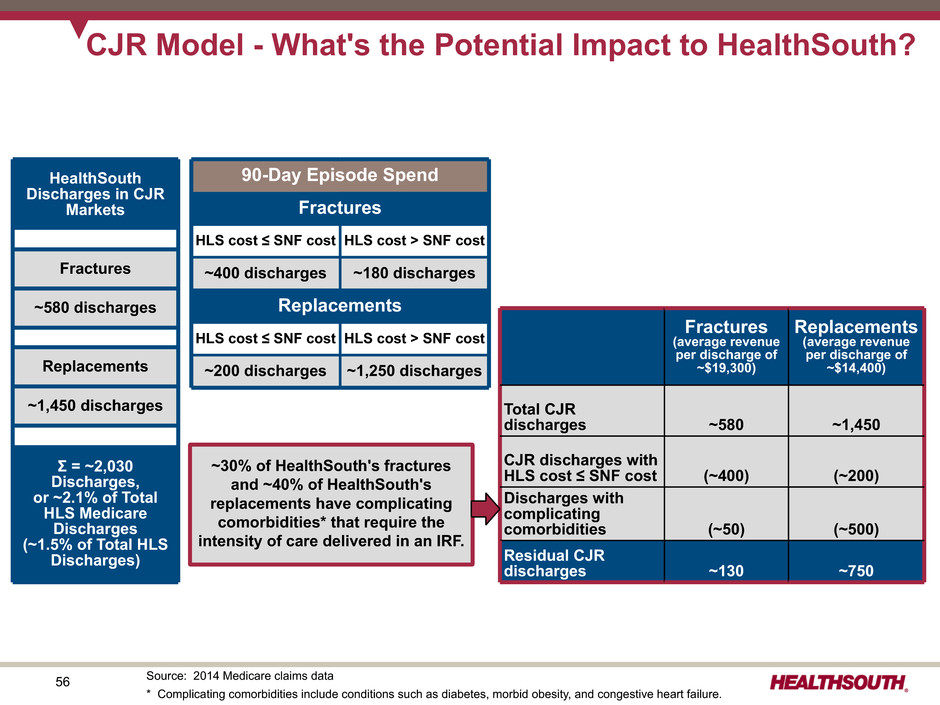
56 CJR Model - What's the Potential Impact to HealthSouth? Source: 2014 Medicare claims data * Complicating comorbidities include conditions such as diabetes, morbid obesity, and congestive heart failure. ~30% of HealthSouth's fractures and ~40% of HealthSouth's replacements have complicating comorbidities* that require the intensity of care delivered in an IRF. HealthSouth Discharges in CJR Markets Fractures ~580 discharges Replacements ~1,450 discharges Σ = ~2,030 Discharges, or ~2.1% of Total HLS Medicare Discharges (~1.5% of Total HLS Discharges) 90-Day Episode Spend Fractures HLS cost ≤ SNF cost HLS cost > SNF cost ~400 discharges ~180 discharges Replacements HLS cost ≤ SNF cost HLS cost > SNF cost ~200 discharges ~1,250 discharges Fractures (average revenue per discharge of ~$19,300) Replacements (average revenue per discharge of ~$14,400) Total CJR discharges ~580 ~1,450 CJR discharges with HLS cost ≤ SNF cost (~400) (~200) Discharges with complicating comorbidities (~50) (~500) Residual CJR discharges ~130 ~750
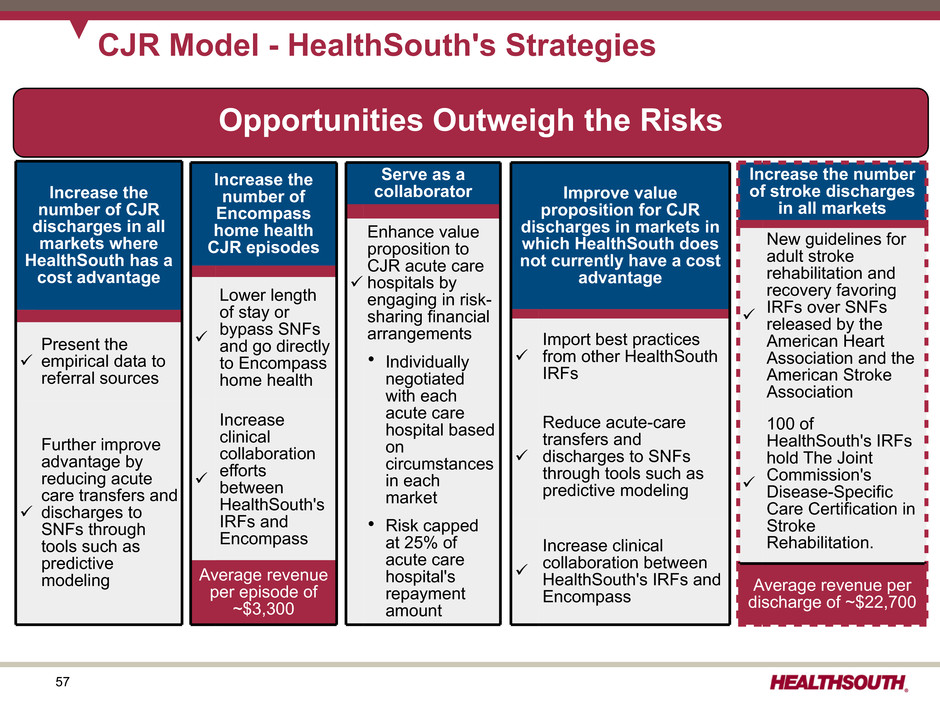
57 CJR Model - HealthSouth's Strategies Opportunities Outweigh the Risks Increase the number of CJR discharges in all markets where HealthSouth has a cost advantage ü Present the empirical data to referral sources ü Further improve advantage by reducing acute care transfers and discharges to SNFs through tools such as predictive modeling Increase the number of Encompass home health CJR episodes ü Lower length of stay or bypass SNFs and go directly to Encompass home health ü Increase clinical collaboration efforts between HealthSouth's IRFs and Encompass Average revenue per episode of ~$3,300 Increase the number of stroke discharges in all markets ü New guidelines for adult stroke rehabilitation and recovery favoring IRFs over SNFs released by the American Heart Association and the American Stroke Association ü 100 of HealthSouth's IRFs hold The Joint Commission's Disease-Specific Care Certification in Stroke Rehabilitation. Average revenue per discharge of ~$22,700 Serve as a collaborator ü Enhance value proposition to CJR acute care hospitals by engaging in risk- sharing financial arrangements Ÿ Individually negotiated with each acute care hospital based on circumstances in each market Ÿ Risk capped at 25% of acute care hospital's repayment amount Improve value proposition for CJR discharges in markets in which HealthSouth does not currently have a cost advantage ü Import best practices from other HealthSouth IRFs ü Reduce acute-care transfers and discharges to SNFs through tools such as predictive modeling ü Increase clinical collaboration between HealthSouth's IRFs and Encompass
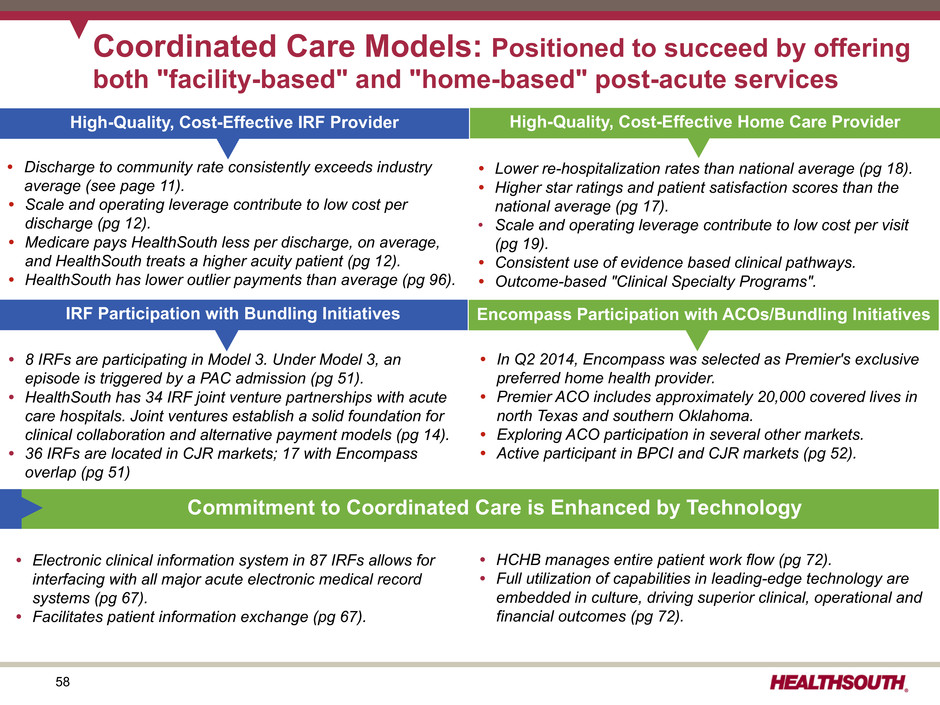
58 • HCHB manages entire patient work flow (pg 72). • Full utilization of capabilities in leading-edge technology are embedded in culture, driving superior clinical, operational and financial outcomes (pg 72). • Electronic clinical information system in 87 IRFs allows for interfacing with all major acute electronic medical record systems (pg 67). • Facilitates patient information exchange (pg 67). Coordinated Care Models: Positioned to succeed by offering both "facility-based" and "home-based" post-acute services • Lower re-hospitalization rates than national average (pg 18). • Higher star ratings and patient satisfaction scores than the national average (pg 17). • Scale and operating leverage contribute to low cost per visit (pg 19). • Consistent use of evidence based clinical pathways. • Outcome-based "Clinical Specialty Programs". • Discharge to community rate consistently exceeds industry average (see page 11). • Scale and operating leverage contribute to low cost per discharge (pg 12). • Medicare pays HealthSouth less per discharge, on average, and HealthSouth treats a higher acuity patient (pg 12). • HealthSouth has lower outlier payments than average (pg 96). • 8 IRFs are participating in Model 3. Under Model 3, an episode is triggered by a PAC admission (pg 51). • HealthSouth has 34 IRF joint venture partnerships with acute care hospitals. Joint ventures establish a solid foundation for clinical collaboration and alternative payment models (pg 14). • 36 IRFs are located in CJR markets; 17 with Encompass overlap (pg 51) • In Q2 2014, Encompass was selected as Premier's exclusive preferred home health provider. • Premier ACO includes approximately 20,000 covered lives in north Texas and southern Oklahoma. • Exploring ACO participation in several other markets. • Active participant in BPCI and CJR markets (pg 52). Commitment to Coordinated Care is Enhanced by Technology High-Quality, Cost-Effective IRF Provider High-Quality, Cost-Effective Home Care Provider IRF Participation with Bundling Initiatives Encompass Participation with ACOs/Bundling Initiatives
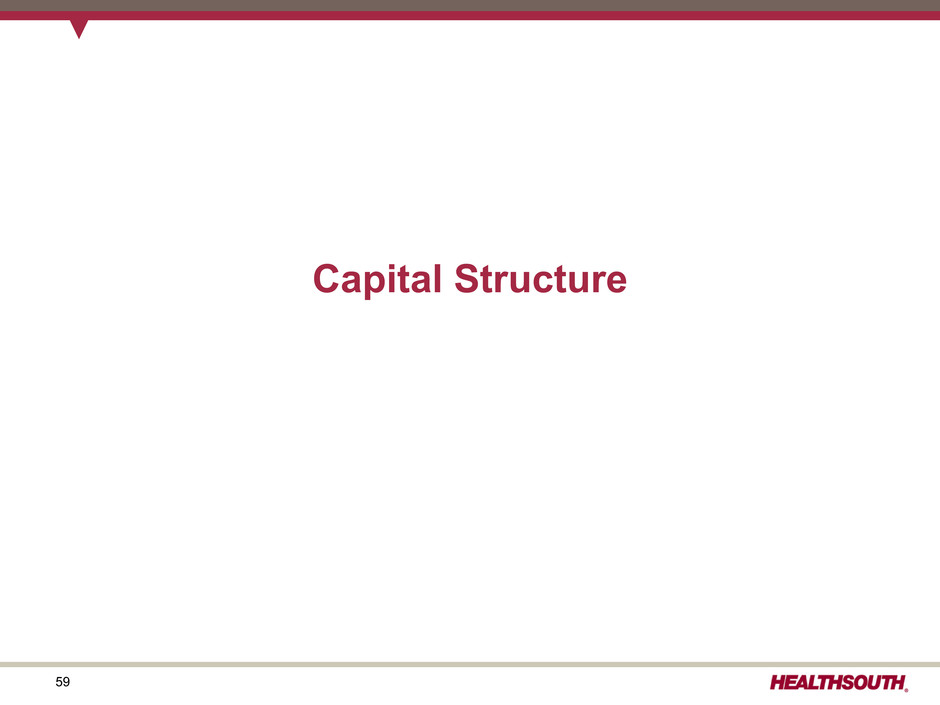
59 Capital Structure
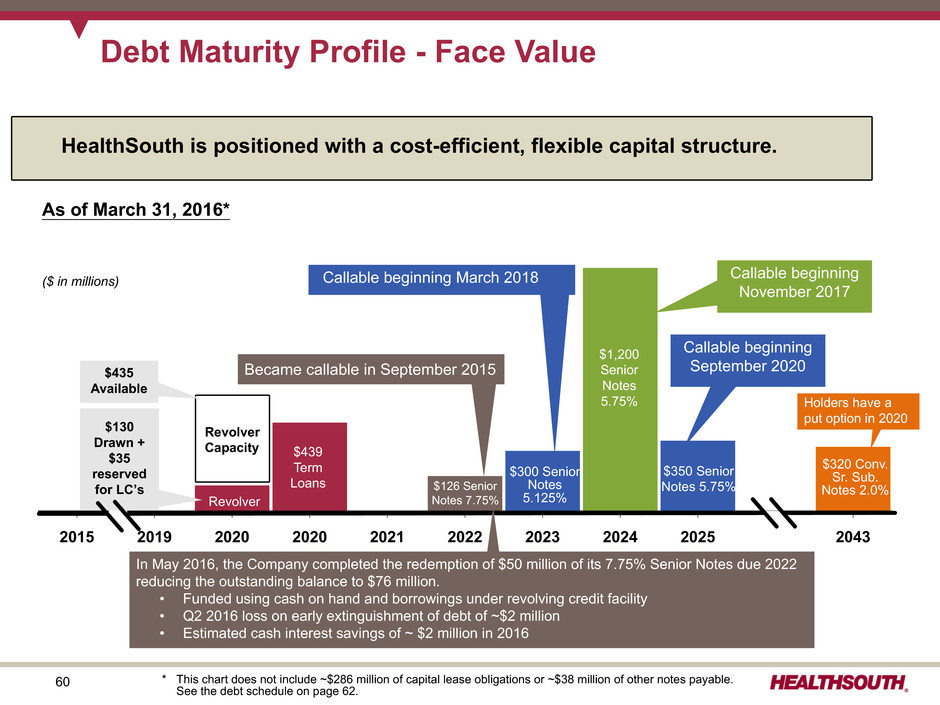
60 2015 2019 2020 2020 2021 2022 2023 2024 2025 2043 $350 Senior Notes 5.75% $1,200 Senior Notes 5.75% $320 Conv. Sr. Sub. Notes 2.0% $300 Senior Notes 5.125% $130 Drawn + $35 reserved for LC’s Holders have a put option in 2020 As of March 31, 2016* Debt Maturity Profile - Face Value ($ in millions) $435 Available $126 Senior Notes 7.75% Callable beginning November 2017 HealthSouth is positioned with a cost-efficient, flexible capital structure. Callable beginning March 2018 Revolver Revolver Capacity $439 Term Loans Became callable in September 2015 Callable beginning September 2020 * This chart does not include ~$286 million of capital lease obligations or ~$38 million of other notes payable. See the debt schedule on page 62. In May 2016, the Company completed the redemption of $50 million of its 7.75% Senior Notes due 2022 reducing the outstanding balance to $76 million. • Funded using cash on hand and borrowings under revolving credit facility • Q2 2016 loss on early extinguishment of debt of ~$2 million • Estimated cash interest savings of ~ $2 million in 2016
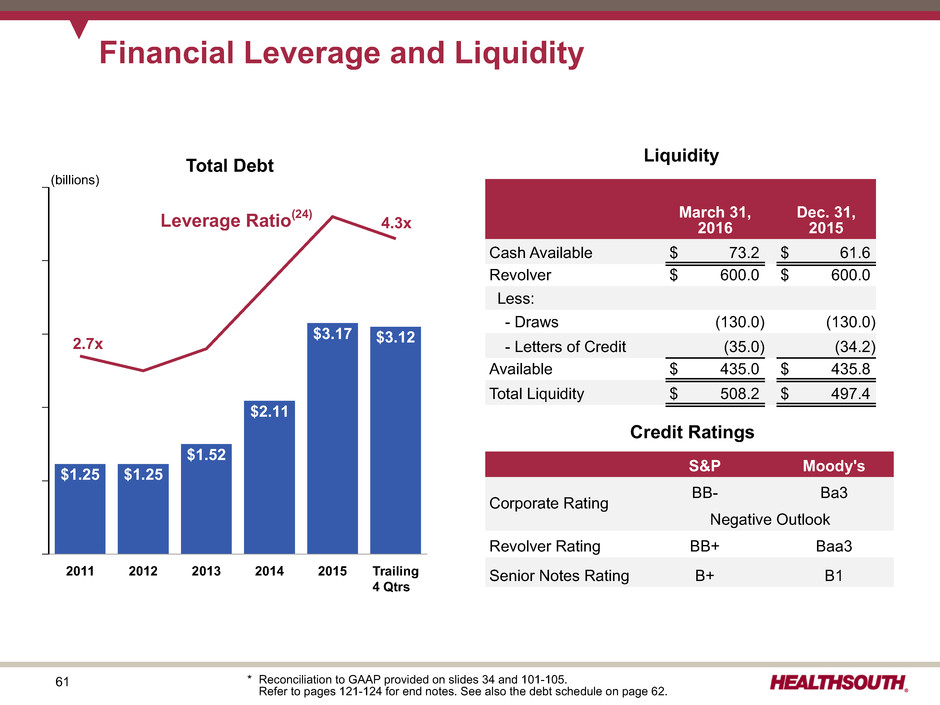
61 S&P Moody's Corporate Rating BB- Ba3 Negative Outlook Revolver Rating BB+ Baa3 Senior Notes Rating B+ B1 Financial Leverage and Liquidity (1) Liquidity Credit Ratings 2011 2012 2013 2014 2015 Trailing 4 Qtrs $1.25 $1.25 $1.52 $2.11 $3.17 $3.12 (billions) Leverage Ratio(24) Total Debt 4.3x March 31,2016 Dec. 31, 2015 Cash Available $ 73.2 $ 61.6 Revolver $ 600.0 $ 600.0 Less: - Draws (130.0) (130.0) - Letters of Credit (35.0) (34.2) Available $ 435.0 $ 435.8 Total Liquidity $ 508.2 $ 497.4 * Reconciliation to GAAP provided on slides 34 and 101-105. Refer to pages 121-124 for end notes. See also the debt schedule on page 62. 2.7x
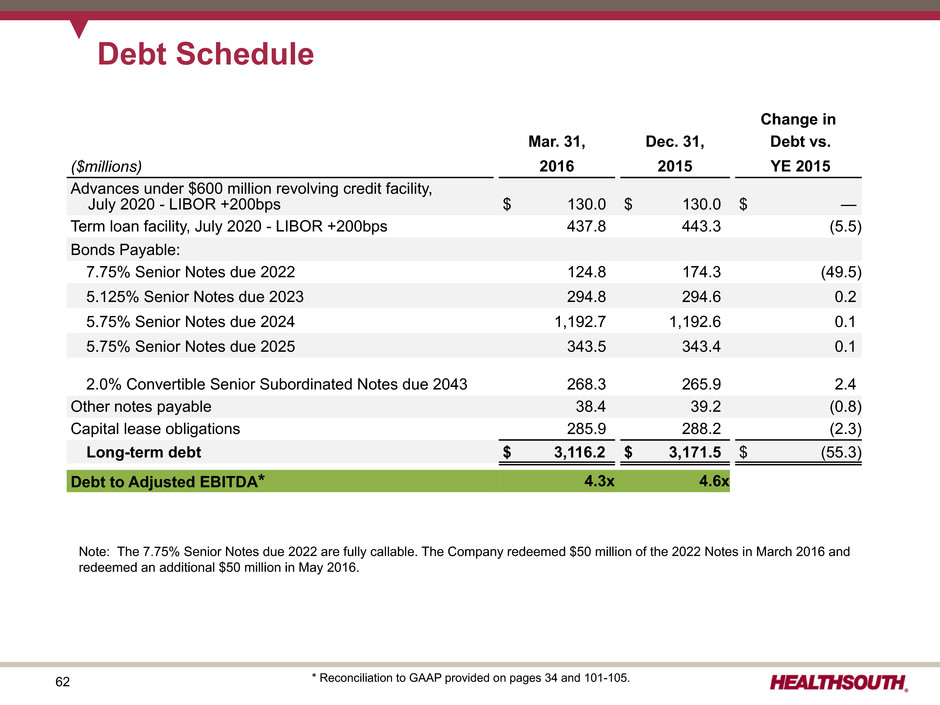
62 Debt Schedule * Reconciliation to GAAP provided on pages 34 and 101-105. Note: The 7.75% Senior Notes due 2022 are fully callable. The Company redeemed $50 million of the 2022 Notes in March 2016 and redeemed an additional $50 million in May 2016. Change in Mar. 31, Dec. 31, Debt vs. ($millions) 2016 2015 YE 2015 Advances under $600 million revolving credit facility, July 2020 - LIBOR +200bps $ 130.0 $ 130.0 $ — Term loan facility, July 2020 - LIBOR +200bps 437.8 443.3 (5.5) Bonds Payable: 7.75% Senior Notes due 2022 124.8 174.3 (49.5) 5.125% Senior Notes due 2023 294.8 294.6 0.2 5.75% Senior Notes due 2024 1,192.7 1,192.6 0.1 5.75% Senior Notes due 2025 343.5 343.4 0.1 2.0% Convertible Senior Subordinated Notes due 2043 268.3 265.9 2.4 Other notes payable 38.4 39.2 (0.8) Capital lease obligations 285.9 288.2 (2.3) Long-term debt $ 3,116.2 $ 3,171.5 $ (55.3) Debt to Adjusted EBITDA* 4.3x 4.6x
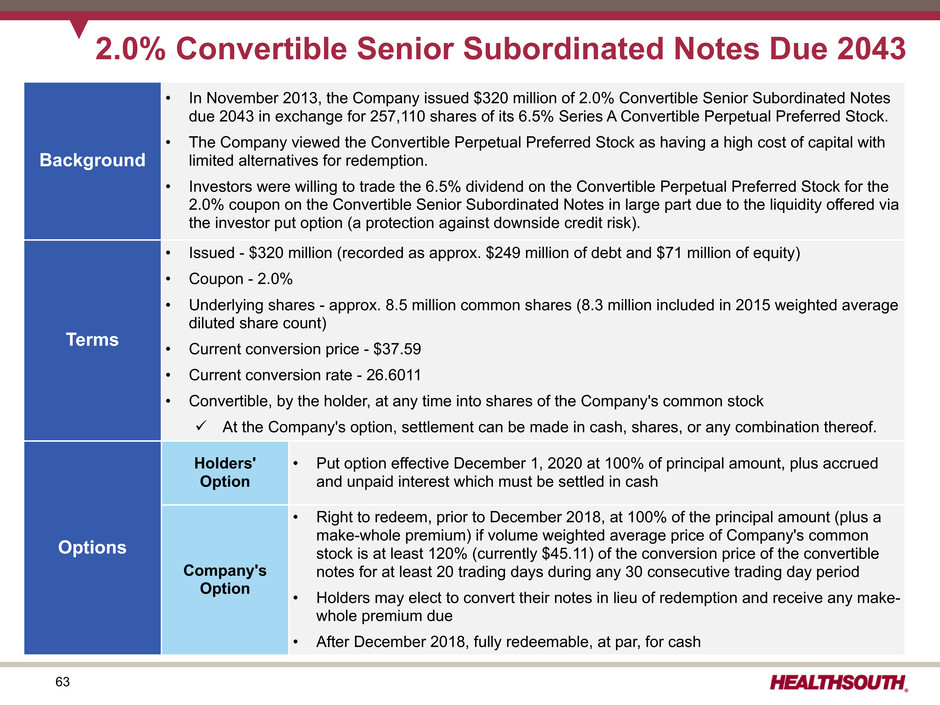
63 2.0% Convertible Senior Subordinated Notes Due 2043 Background • In November 2013, the Company issued $320 million of 2.0% Convertible Senior Subordinated Notes due 2043 in exchange for 257,110 shares of its 6.5% Series A Convertible Perpetual Preferred Stock. • The Company viewed the Convertible Perpetual Preferred Stock as having a high cost of capital with limited alternatives for redemption. • Investors were willing to trade the 6.5% dividend on the Convertible Perpetual Preferred Stock for the 2.0% coupon on the Convertible Senior Subordinated Notes in large part due to the liquidity offered via the investor put option (a protection against downside credit risk). Terms • Issued - $320 million (recorded as approx. $249 million of debt and $71 million of equity) • Coupon - 2.0% • Underlying shares - approx. 8.5 million common shares (8.3 million included in 2015 weighted average diluted share count) • Current conversion price - $37.59 • Current conversion rate - 26.6011 • Convertible, by the holder, at any time into shares of the Company's common stock ü At the Company's option, settlement can be made in cash, shares, or any combination thereof. Options Holders' Option • Put option effective December 1, 2020 at 100% of principal amount, plus accrued and unpaid interest which must be settled in cash Company's Option • Right to redeem, prior to December 2018, at 100% of the principal amount (plus a make-whole premium) if volume weighted average price of Company's common stock is at least 120% (currently $45.11) of the conversion price of the convertible notes for at least 20 trading days during any 30 consecutive trading day period • Holders may elect to convert their notes in lieu of redemption and receive any make- whole premium due • After December 2018, fully redeemable, at par, for cash
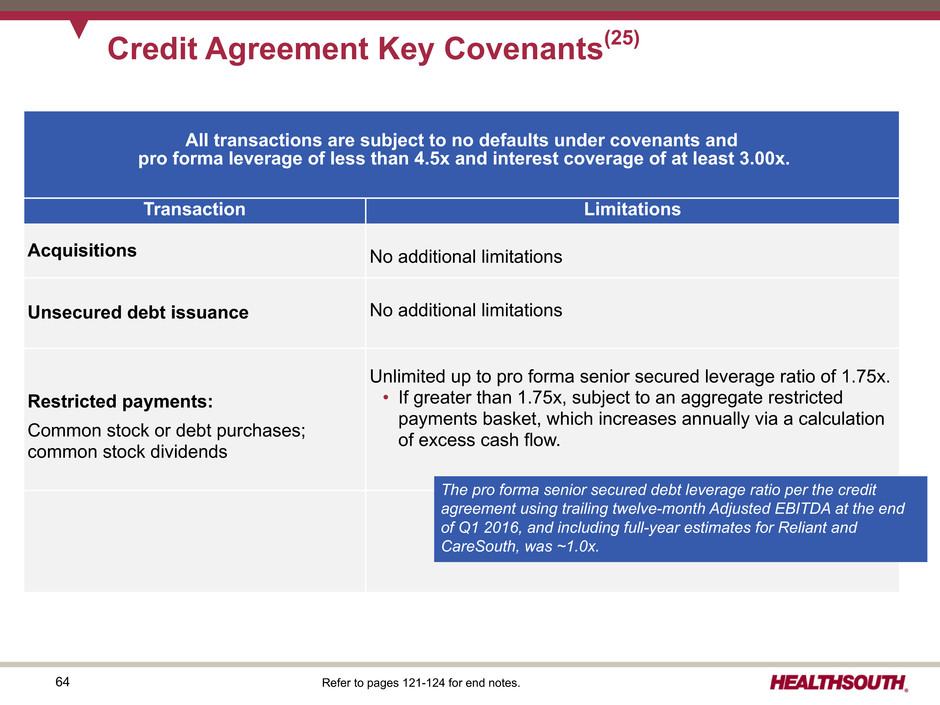
64 Credit Agreement Key Covenants(25) All transactions are subject to no defaults under covenants and pro forma leverage of less than 4.5x and interest coverage of at least 3.00x. Transaction Limitations Acquisitions No additional limitations Unsecured debt issuance No additional limitations Restricted payments: Common stock or debt purchases; common stock dividends Unlimited up to pro forma senior secured leverage ratio of 1.75x. • If greater than 1.75x, subject to an aggregate restricted payments basket, which increases annually via a calculation of excess cash flow. The pro forma senior secured debt leverage ratio per the credit agreement using trailing twelve-month Adjusted EBITDA at the end of Q1 2016, and including full-year estimates for Reliant and CareSouth, was ~1.0x. Refer to pages 121-124 for end notes.
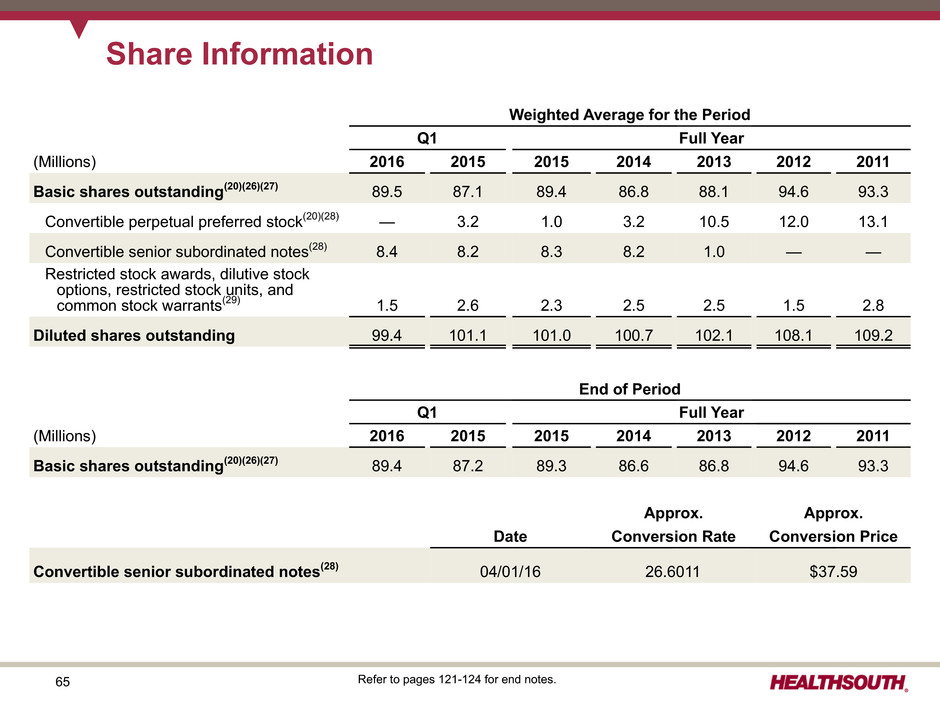
65 Share Information Weighted Average for the Period Q1 Full Year (Millions) 2016 2015 2015 2014 2013 2012 2011 Basic shares outstanding(20)(26)(27) 89.5 87.1 89.4 86.8 88.1 94.6 93.3 Convertible perpetual preferred stock(20)(28) — 3.2 1.0 3.2 10.5 12.0 13.1 Convertible senior subordinated notes(28) 8.4 8.2 8.3 8.2 1.0 — — Restricted stock awards, dilutive stock options, restricted stock units, and common stock warrants(29) 1.5 2.6 2.3 2.5 2.5 1.5 2.8 Diluted shares outstanding 99.4 101.1 101.0 100.7 102.1 108.1 109.2 End of Period Q1 Full Year (Millions) 2016 2015 2015 2014 2013 2012 2011 Basic shares outstanding(20)(26)(27) 89.4 87.2 89.3 86.6 86.8 94.6 93.3 Approx. Approx. Date Conversion Rate Conversion Price Convertible senior subordinated notes(28) 04/01/16 26.6011 $37.59 Refer to pages 121-124 for end notes.
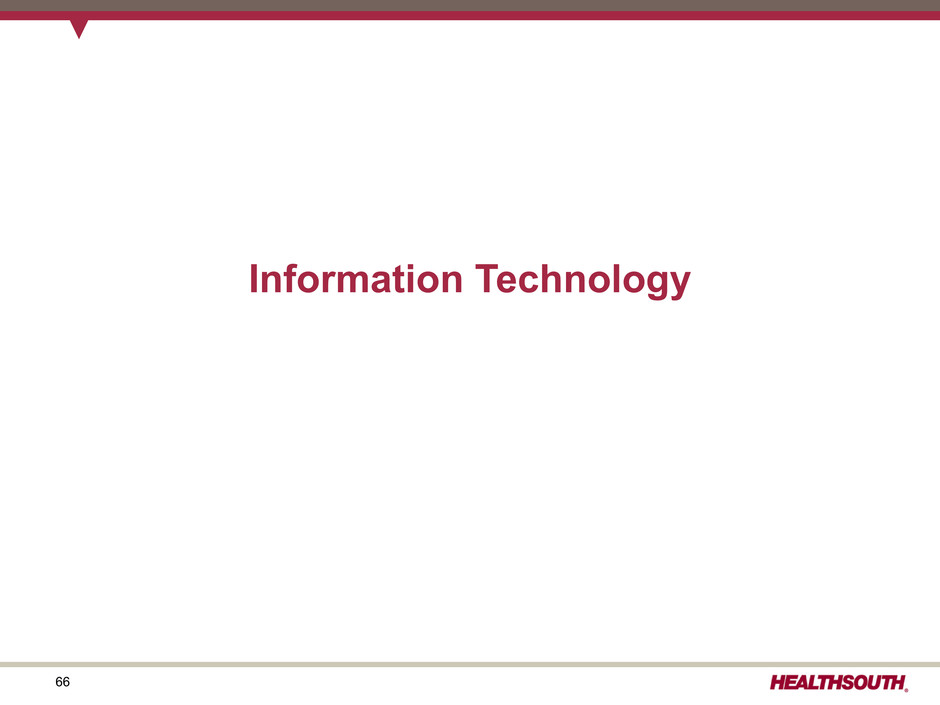
66 Information Technology
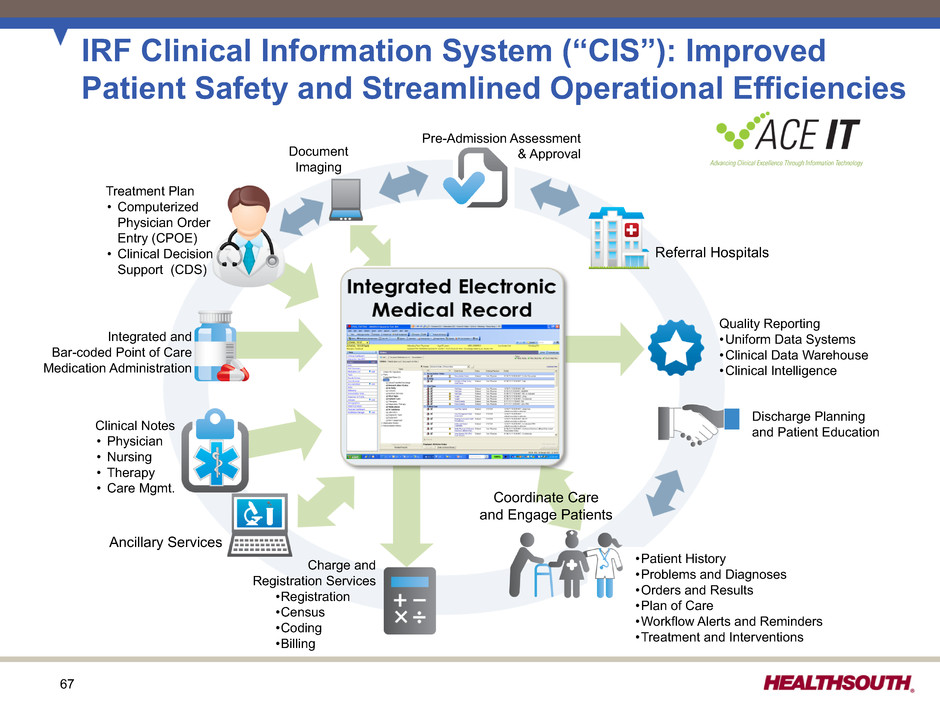
67 IRF Clinical Information System (“CIS”): Improved Patient Safety and Streamlined Operational Efficiencies Pre-Admission Assessment & Approval Discharge Planning and Patient Education •Patient History •Problems and Diagnoses •Orders and Results •Plan of Care •Workflow Alerts and Reminders •Treatment and Interventions Document Imaging Charge and Registration Services •Registration •Census •Coding •Billing Quality Reporting •Uniform Data Systems •Clinical Data Warehouse •Clinical Intelligence Referral Hospitals Ancillary Services Clinical Notes • Physician • Nursing • Therapy • Care Mgmt. Integrated and Bar-coded Point of Care Medication Administration Treatment Plan • Computerized Physician Order Entry (CPOE) • Clinical Decision Support (CDS) Coordinate Care and Engage Patients
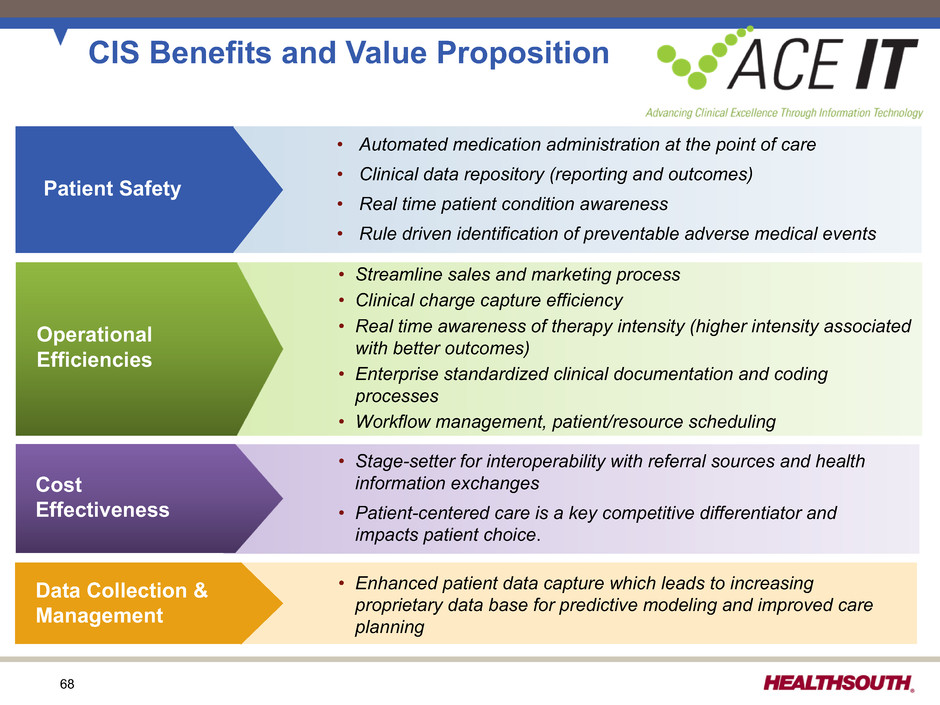
68 CIS Benefits and Value Proposition Operational Efficiencies Cost Effectiveness • Automated medication administration at the point of care • Clinical data repository (reporting and outcomes) • Real time patient condition awareness • Rule driven identification of preventable adverse medical events • Streamline sales and marketing process • Clinical charge capture efficiency • Real time awareness of therapy intensity (higher intensity associated with better outcomes) • Enterprise standardized clinical documentation and coding processes • Workflow management, patient/resource scheduling • Stage-setter for interoperability with referral sources and health information exchanges • Patient-centered care is a key competitive differentiator and impacts patient choice. Patient Safety Data Collection & Management • Enhanced patient data capture which leads to increasing proprietary data base for predictive modeling and improved care planning
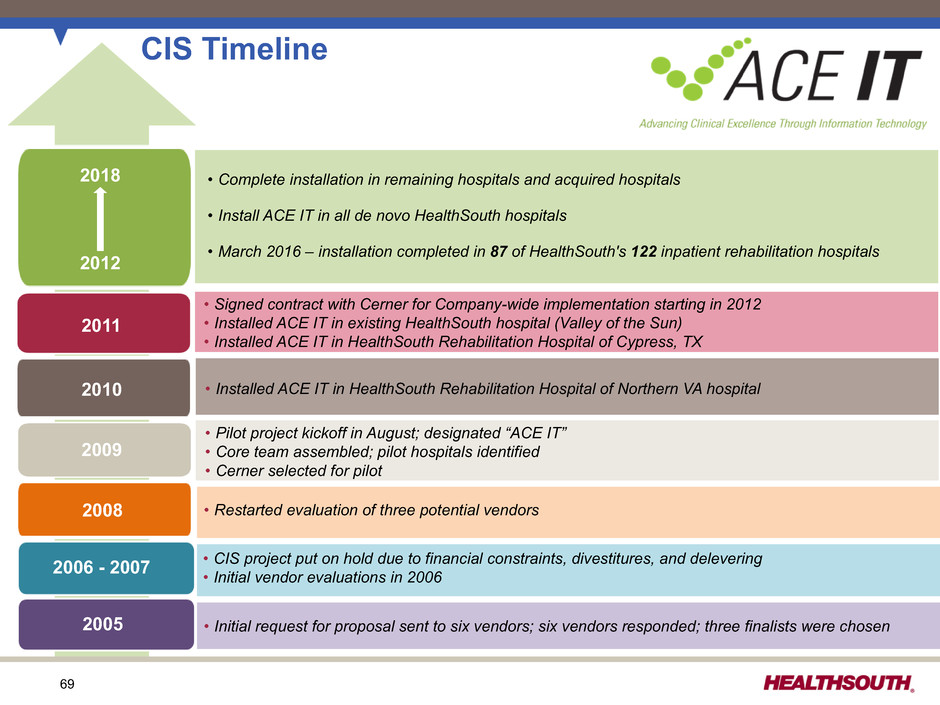
69 • Installed ACE IT in HealthSouth Rehabilitation Hospital of Northern VA hospital • Pilot project kickoff in August; designated “ACE IT” • Core team assembled; pilot hospitals identified • Cerner selected for pilot • Signed contract with Cerner for Company-wide implementation starting in 2012 • Installed ACE IT in existing HealthSouth hospital (Valley of the Sun) • Installed ACE IT in HealthSouth Rehabilitation Hospital of Cypress, TX • Complete installation in remaining hospitals and acquired hospitals • Install ACE IT in all de novo HealthSouth hospitals • March 2016 – installation completed in 87 of HealthSouth's 122 inpatient rehabilitation hospitals CIS Timeline • Restarted evaluation of three potential vendors • CIS project put on hold due to financial constraints, divestitures, and delevering • Initial vendor evaluations in 2006 • Initial request for proposal sent to six vendors; six vendors responded; three finalists were chosen 2018 2012 2011 2010 2009 2008 2006 - 2007 2005
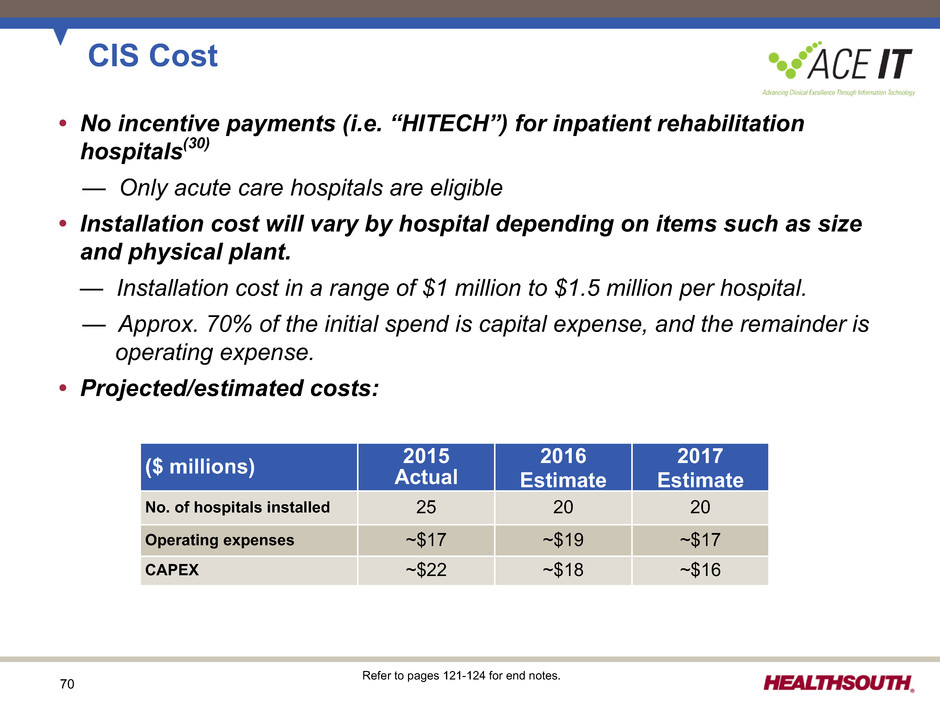
70 CIS Cost • No incentive payments (i.e. “HITECH”) for inpatient rehabilitation hospitals(30) — Only acute care hospitals are eligible • Installation cost will vary by hospital depending on items such as size and physical plant. — Installation cost in a range of $1 million to $1.5 million per hospital. — Approx. 70% of the initial spend is capital expense, and the remainder is operating expense. • Projected/estimated costs: ($ millions) 2015Actual 2016 Estimate 2017 Estimate No. of hospitals installed 25 20 20 Operating expenses ~$17 ~$19 ~$17 CAPEX ~$22 ~$18 ~$16 Refer to pages 121-124 for end notes.
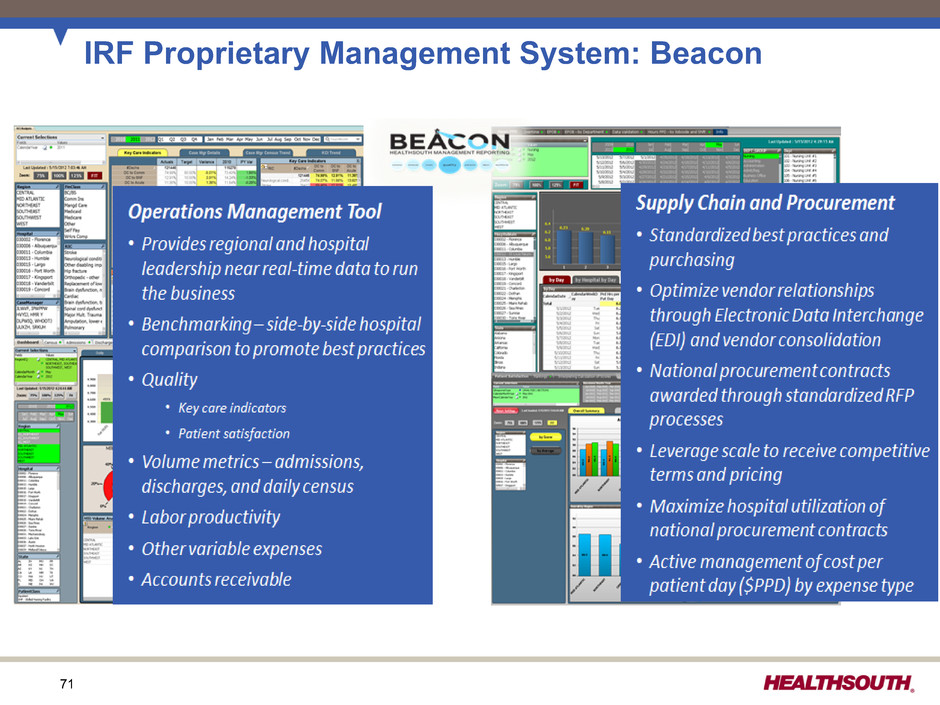
71 IRF Proprietary Management System: Beacon
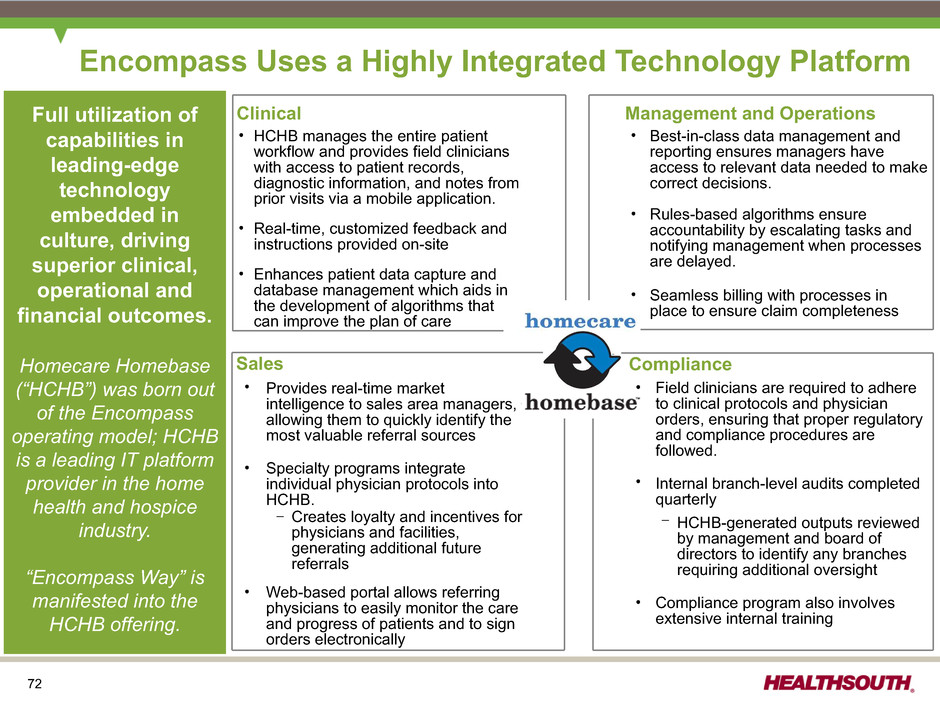
72 Encompass Uses a Highly Integrated Technology Platform Clinical Ÿ HCHB manages the entire patient workflow and provides field clinicians with access to patient records, diagnostic information, and notes from prior visits via a mobile application. Ÿ Real-time, customized feedback and instructions provided on-site Ÿ Enhances patient data capture and database management which aids in the development of algorithms that can improve the plan of care Sales Ÿ Provides real-time market intelligence to sales area managers, allowing them to quickly identify the most valuable referral sources Ÿ Specialty programs integrate individual physician protocols into HCHB. – Creates loyalty and incentives for physicians and facilities, generating additional future referrals Ÿ Web-based portal allows referring physicians to easily monitor the care and progress of patients and to sign orders electronically Compliance Ÿ Field clinicians are required to adhere to clinical protocols and physician orders, ensuring that proper regulatory and compliance procedures are followed. Ÿ Internal branch-level audits completed quarterly – HCHB-generated outputs reviewed by management and board of directors to identify any branches requiring additional oversight Ÿ Compliance program also involves extensive internal training Management and Operations Ÿ Best-in-class data management and reporting ensures managers have access to relevant data needed to make correct decisions. Ÿ Rules-based algorithms ensure accountability by escalating tasks and notifying management when processes are delayed. Ÿ Seamless billing with processes in place to ensure claim completeness Full utilization of capabilities in leading-edge technology embedded in culture, driving superior clinical, operational and financial outcomes. Homecare Homebase (“HCHB”) was born out of the Encompass operating model; HCHB is a leading IT platform provider in the home health and hospice industry. “Encompass Way” is manifested into the HCHB offering.
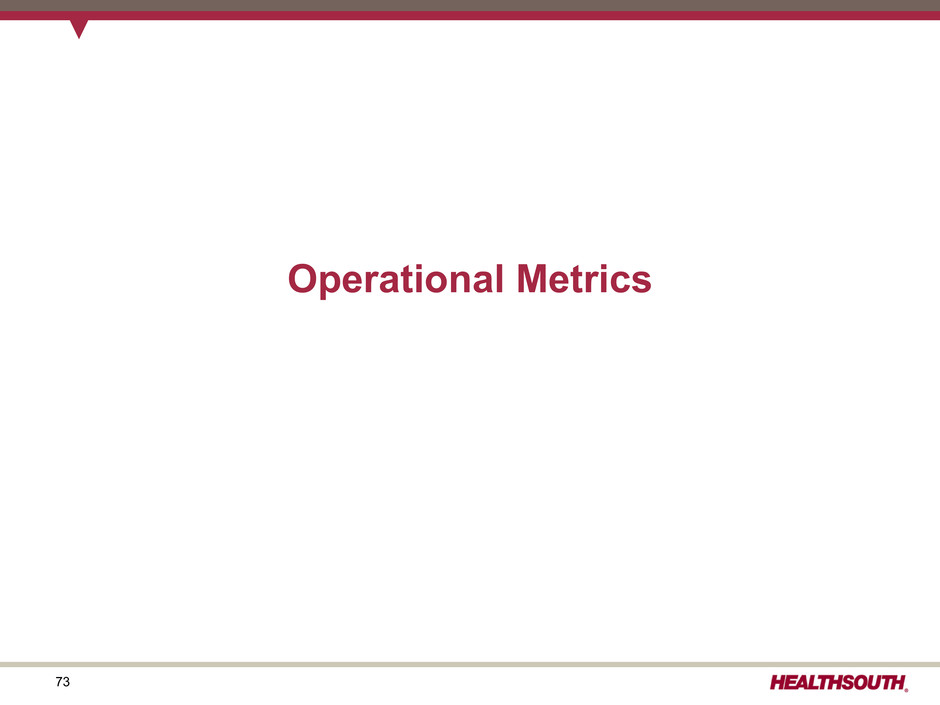
73 Operational Metrics
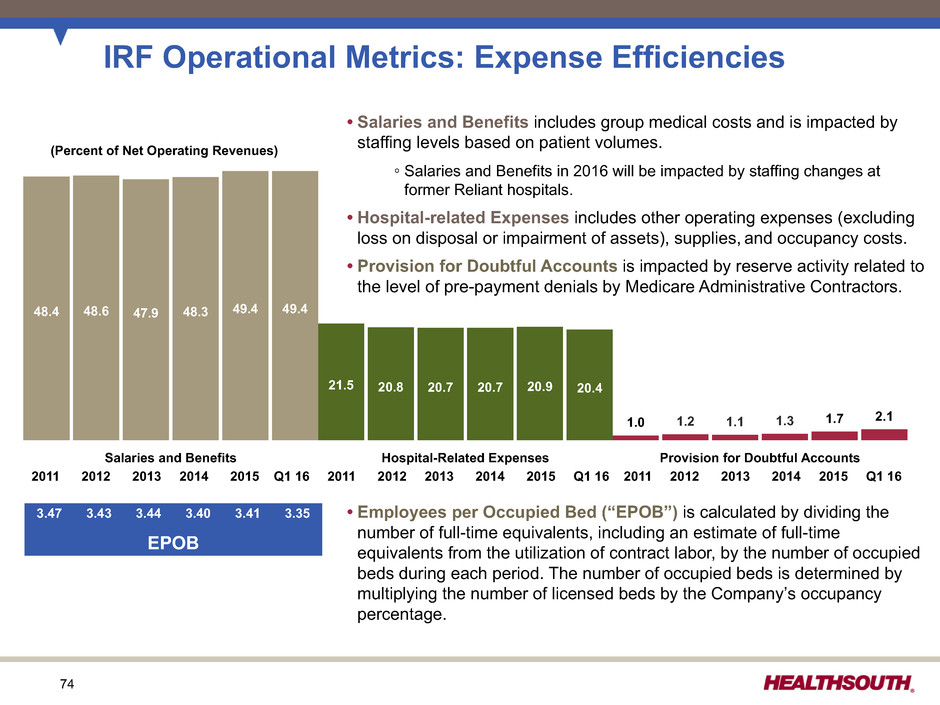
74 • Salaries and Benefits includes group medical costs and is impacted by staffing levels based on patient volumes. ◦ Salaries and Benefits in 2016 will be impacted by staffing changes at former Reliant hospitals. • Hospital-related Expenses includes other operating expenses (excluding loss on disposal or impairment of assets), supplies, and occupancy costs. • Provision for Doubtful Accounts is impacted by reserve activity related to the level of pre-payment denials by Medicare Administrative Contractors. • Employees per Occupied Bed (“EPOB”) is calculated by dividing the number of full-time equivalents, including an estimate of full-time equivalents from the utilization of contract labor, by the number of occupied beds during each period. The number of occupied beds is determined by multiplying the number of licensed beds by the Company’s occupancy percentage. Salaries and Benefits Hospital-Related Expenses Provision for Doubtful Accounts 48.4 21.5 1.0 48.6 20.8 1.2 47.9 20.7 1.1 48.3 20.7 1.3 49.4 20.9 1.7 49.4 20.4 2.1 IRF Operational Metrics: Expense Efficiencies 2011 2012 2013 2014 2015 Q1 16 2011 2012 2013 2014 2015 Q1 16 2011 2012 2013 2014 2015 Q1 16 3.47 3.43 3.44 3.40 3.41 3.35 EPOB (Percent of Net Operating Revenues)

75 IRF Operational and Labor Metrics Refer to pages 121-124 for end notes. Q1 Q4 Q3 Q2 Q1 Full Year 2016 2015 2015 2015 2015 2015 (In Millions) Net patient revenue-inpatient $ 719.4 $ 696.8 $ 625.1 $ 618.7 $ 606.6 $ 2,547.2 Net patient revenue-outpatient and other revenues 29.8 29.1 26.5 26.6 23.7 105.9 Net operating revenues $ 749.2 $ 725.9 $ 651.6 $ 645.3 $ 630.3 $ 2,653.1 Discharges(31) 41,098 40,891 36,746 36,408 35,116 149,161 Revenue per discharge $ 17,505 $ 17,040 $ 17,011 $ 16,994 $ 17,274 $ 17,077 Outpatient visits 162,649 163,119 138,121 144,914 131,353 577,507 Average length of stay 12.9 12.6 12.9 13.0 13.3 12.9 Occupancy % 68.9% 66.4% 69.6% 70.4% 72.8% 62.8% # of licensed beds 8,481 8,404 7,422 7,374 7,100 8,404 Occupied beds 5,843 5,580 5,166 5,191 5,169 5,278 Full-time equivalents (FTEs)(32) 19,352 19,136 17,782 17,601 17,002 17,880 Contract labor 194 152 141 118 116 132 Total FTE and contract labor 19,546 19,288 17,923 17,719 17,118 18,012 EPOB(33) 3.35 3.46 3.47 3.41 3.31 3.41
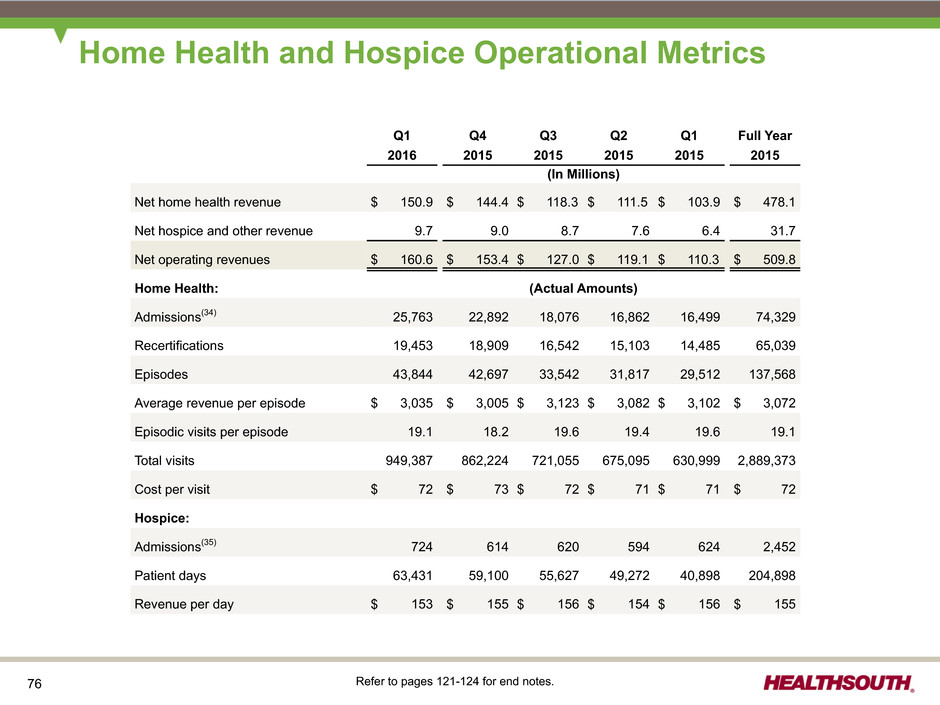
76 Q1 Q4 Q3 Q2 Q1 Full Year 2016 2015 2015 2015 2015 2015 (In Millions) Net home health revenue $ 150.9 $ 144.4 $ 118.3 $ 111.5 $ 103.9 $ 478.1 Net hospice and other revenue 9.7 9.0 8.7 7.6 6.4 31.7 Net operating revenues $ 160.6 $ 153.4 $ 127.0 $ 119.1 $ 110.3 $ 509.8 Home Health: (Actual Amounts) Admissions(34) 25,763 22,892 18,076 16,862 16,499 74,329 Recertifications 19,453 18,909 16,542 15,103 14,485 65,039 Episodes 43,844 42,697 33,542 31,817 29,512 137,568 Average revenue per episode $ 3,035 $ 3,005 $ 3,123 $ 3,082 $ 3,102 $ 3,072 Episodic visits per episode 19.1 18.2 19.6 19.4 19.6 19.1 Total visits 949,387 862,224 721,055 675,095 630,999 2,889,373 Cost per visit $ 72 $ 73 $ 72 $ 71 $ 71 $ 72 Hospice: Admissions(35) 724 614 620 594 624 2,452 Patient days 63,431 59,100 55,627 49,272 40,898 204,898 Revenue per day $ 153 $ 155 $ 156 $ 154 $ 156 $ 155 Home Health and Hospice Operational Metrics Refer to pages 121-124 for end notes.
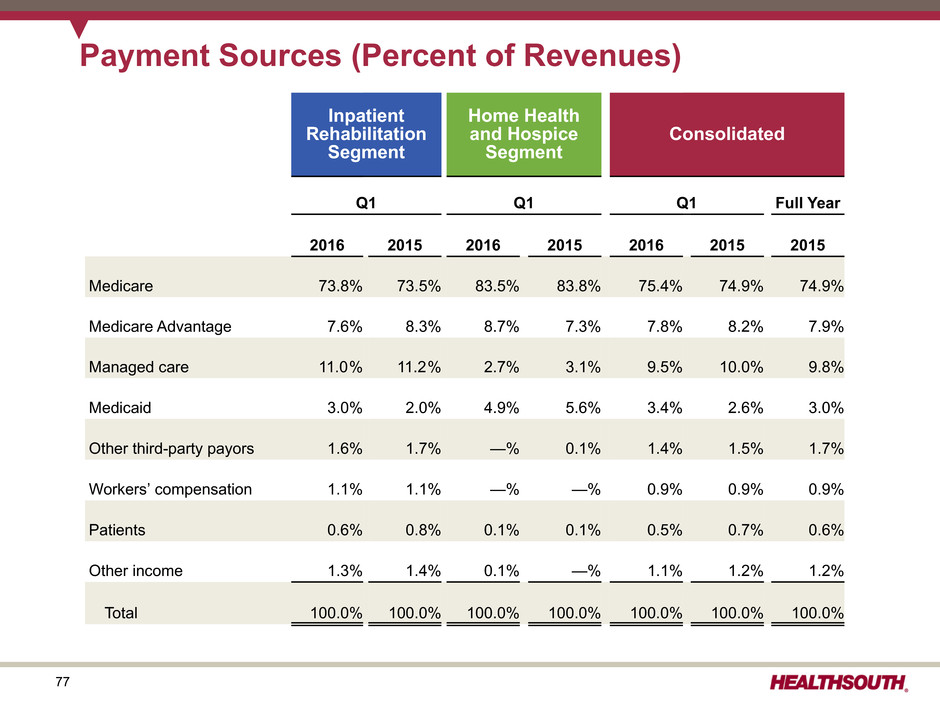
77 Payment Sources (Percent of Revenues) Inpatient Rehabilitation Segment Home Health and Hospice Segment Consolidated Q1 Q1 Q1 Full Year 2016 2015 2016 2015 2016 2015 2015 Medicare 73.8% 73.5% 83.5% 83.8% 75.4% 74.9% 74.9% Medicare Advantage 7.6% 8.3% 8.7% 7.3% 7.8% 8.2% 7.9% Managed care 11.0% 11.2% 2.7% 3.1% 9.5% 10.0% 9.8% Medicaid 3.0% 2.0% 4.9% 5.6% 3.4% 2.6% 3.0% Other third-party payors 1.6% 1.7% —% 0.1% 1.4% 1.5% 1.7% Workers’ compensation 1.1% 1.1% —% —% 0.9% 0.9% 0.9% Patients 0.6% 0.8% 0.1% 0.1% 0.5% 0.7% 0.6% Other income 1.3% 1.4% 0.1% —% 1.1% 1.2% 1.2% Total 100.0% 100.0% 100.0% 100.0% 100.0% 100.0% 100.0%
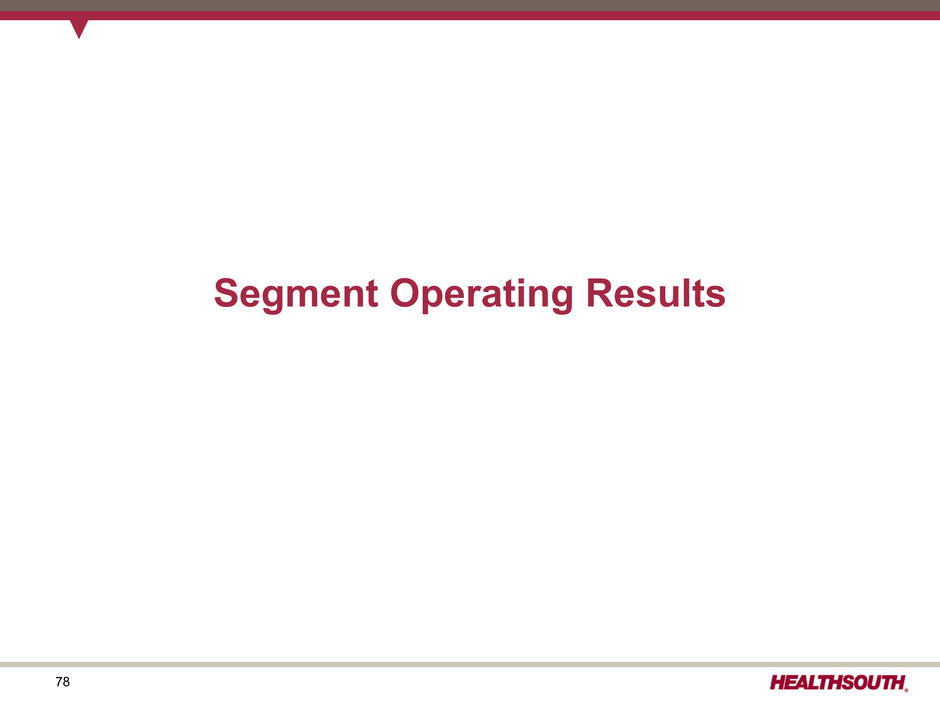
78 Segment Operating Results
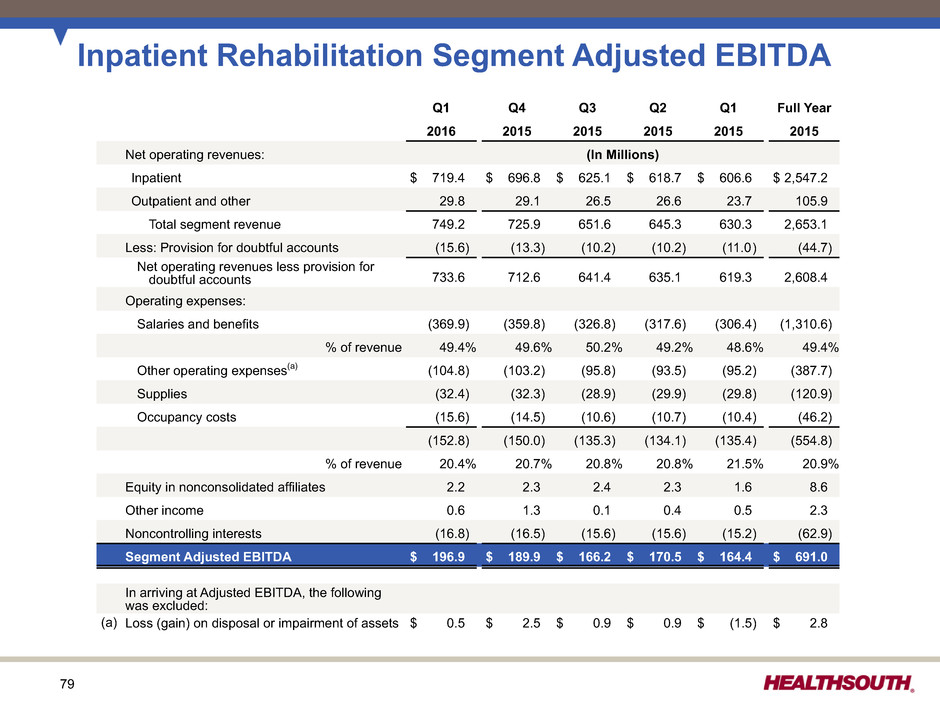
79 Inpatient Rehabilitation Segment Adjusted EBITDA Q1 Q4 Q3 Q2 Q1 Full Year 2016 2015 2015 2015 2015 2015 Net operating revenues: (In Millions) Inpatient $ 719.4 $ 696.8 $ 625.1 $ 618.7 $ 606.6 $ 2,547.2 Outpatient and other 29.8 29.1 26.5 26.6 23.7 105.9 Total segment revenue 749.2 725.9 651.6 645.3 630.3 2,653.1 Less: Provision for doubtful accounts (15.6) (13.3) (10.2) (10.2) (11.0) (44.7) Net operating revenues less provision for doubtful accounts 733.6 712.6 641.4 635.1 619.3 2,608.4 Operating expenses: Salaries and benefits (369.9) (359.8) (326.8) (317.6) (306.4) (1,310.6) % of revenue 49.4% 49.6% 50.2% 49.2% 48.6% 49.4% Other operating expenses(a) (104.8) (103.2) (95.8) (93.5) (95.2) (387.7) Supplies (32.4) (32.3) (28.9) (29.9) (29.8) (120.9) Occupancy costs (15.6) (14.5) (10.6) (10.7) (10.4) (46.2) (152.8) (150.0) (135.3) (134.1) (135.4) (554.8) % of revenue 20.4% 20.7% 20.8% 20.8% 21.5% 20.9% Equity in nonconsolidated affiliates 2.2 2.3 2.4 2.3 1.6 8.6 Other income 0.6 1.3 0.1 0.4 0.5 2.3 Noncontrolling interests (16.8) (16.5) (15.6) (15.6) (15.2) (62.9) Segment Adjusted EBITDA $ 196.9 $ 189.9 $ 166.2 $ 170.5 $ 164.4 $ 691.0 In arriving at Adjusted EBITDA, the following was excluded: (a) Loss (gain) on disposal or impairment of assets $ 0.5 $ 2.5 $ 0.9 $ 0.9 $ (1.5) $ 2.8
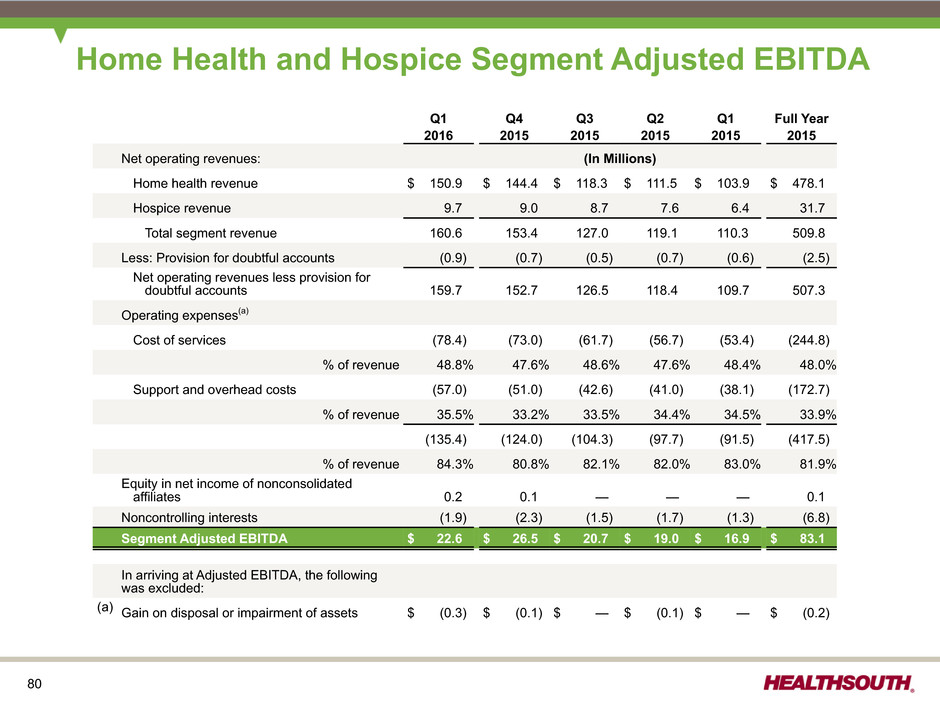
80 Home Health and Hospice Segment Adjusted EBITDA Q1 Q4 Q3 Q2 Q1 Full Year 2016 2015 2015 2015 2015 2015 Net operating revenues: (In Millions) Home health revenue $ 150.9 $ 144.4 $ 118.3 $ 111.5 $ 103.9 $ 478.1 Hospice revenue 9.7 9.0 8.7 7.6 6.4 31.7 Total segment revenue 160.6 153.4 127.0 119.1 110.3 509.8 Less: Provision for doubtful accounts (0.9) (0.7) (0.5) (0.7) (0.6) (2.5) Net operating revenues less provision for doubtful accounts 159.7 152.7 126.5 118.4 109.7 507.3 Operating expenses(a) Cost of services (78.4) (73.0) (61.7) (56.7) (53.4) (244.8) % of revenue 48.8% 47.6% 48.6% 47.6% 48.4% 48.0% Support and overhead costs (57.0) (51.0) (42.6) (41.0) (38.1) (172.7) % of revenue 35.5% 33.2% 33.5% 34.4% 34.5% 33.9% (135.4) (124.0) (104.3) (97.7) (91.5) (417.5) % of revenue 84.3% 80.8% 82.1% 82.0% 83.0% 81.9% Equity in net income of nonconsolidated affiliates 0.2 0.1 — — — 0.1 Noncontrolling interests (1.9) (2.3) (1.5) (1.7) (1.3) (6.8) Segment Adjusted EBITDA $ 22.6 $ 26.5 $ 20.7 $ 19.0 $ 16.9 $ 83.1 In arriving at Adjusted EBITDA, the following was excluded: (a) Gain on disposal or impairment of assets $ (0.3) $ (0.1) $ — $ (0.1) $ — $ (0.2)
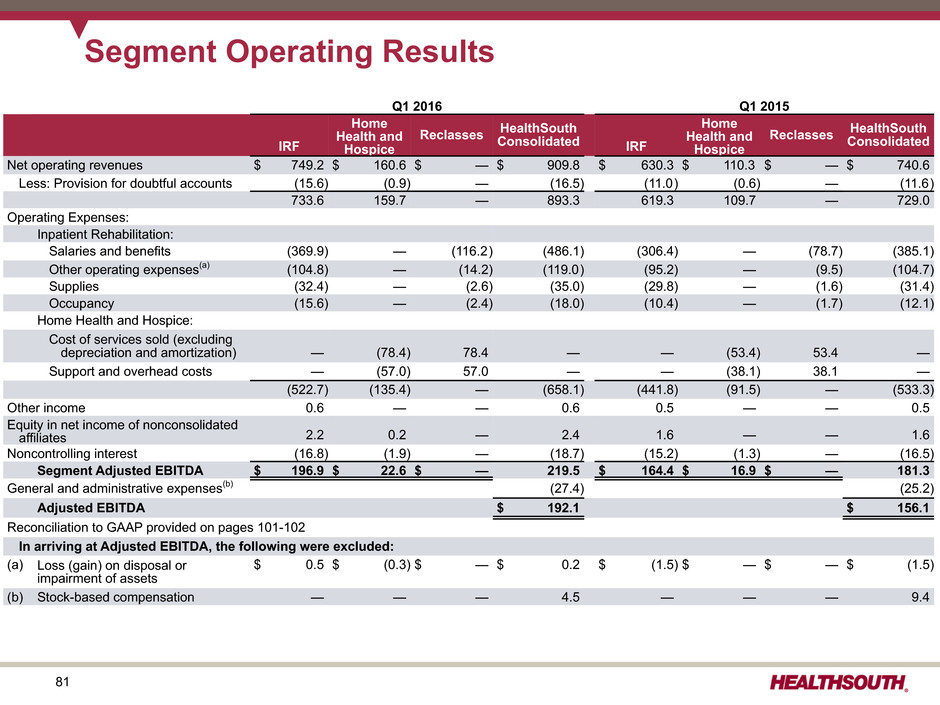
81 Segment Operating Results Q1 2016 Q1 2015 IRF Home Health and Hospice Reclasses HealthSouthConsolidated IRF Home Health and Hospice Reclasses HealthSouthConsolidated Net operating revenues $ 749.2 $ 160.6 $ — $ 909.8 $ 630.3 $ 110.3 $ — $ 740.6 Less: Provision for doubtful accounts (15.6) (0.9) — (16.5) (11.0) (0.6) — (11.6) 733.6 159.7 — 893.3 619.3 109.7 — 729.0 Operating Expenses: Inpatient Rehabilitation: Salaries and benefits (369.9) — (116.2) (486.1) (306.4) — (78.7) (385.1) Other operating expenses(a) (104.8) — (14.2) (119.0) (95.2) — (9.5) (104.7) Supplies (32.4) — (2.6) (35.0) (29.8) — (1.6) (31.4) Occupancy (15.6) — (2.4) (18.0) (10.4) — (1.7) (12.1) Home Health and Hospice: Cost of services sold (excluding depreciation and amortization) — (78.4) 78.4 — — (53.4) 53.4 — Support and overhead costs — (57.0) 57.0 — — (38.1) 38.1 — (522.7) (135.4) — (658.1) (441.8) (91.5) — (533.3) Other income 0.6 — — 0.6 0.5 — — 0.5 Equity in net income of nonconsolidated affiliates 2.2 0.2 — 2.4 1.6 — — 1.6 Noncontrolling interest (16.8) (1.9) — (18.7) (15.2) (1.3) — (16.5) Segment Adjusted EBITDA $ 196.9 $ 22.6 $ — 219.5 $ 164.4 $ 16.9 $ — 181.3 General and administrative expenses(b) (27.4) (25.2) Adjusted EBITDA $ 192.1 $ 156.1 Reconciliation to GAAP provided on pages 101-102 In arriving at Adjusted EBITDA, the following were excluded: (a) Loss (gain) on disposal or impairment of assets $ 0.5 $ (0.3) $ — $ 0.2 $ (1.5) $ — $ — $ (1.5) (b) Stock-based compensation — — — 4.5 — — — 9.4

82 Segment Operating Results Year Ended December 31, 2015 IRF Home Health and Hospice Reclasses HealthSouth Consolidated Net operating revenues $ 2,653.1 $ 509.8 $ — $ 3,162.9 Less: Provision for doubtful accounts (44.7) (2.5) — (47.2) 2,608.4 507.3 — 3,115.7 Operating Expenses: Inpatient Rehabilitation: Salaries and benefits (1,310.6) — (360.2) (1,670.8) Other operating expenses(a) (387.7) — (41.8) (429.5) Supplies (120.9) — (7.8) (128.7) Occupancy (46.2) — (7.7) (53.9) Home Health and Hospice: Cost of services sold (excluding depreciation and amortization) — (244.8) 244.8 — Support and overhead costs — (172.7) 172.7 — (1,865.4) (417.5) — (2,282.9) Other income 2.3 — — 2.3 Equity in net income of nonconsolidated affiliates 8.6 0.1 — 8.7 Noncontrolling interest (62.9) (6.8) — (69.7) Segment Adjusted EBITDA $ 691.0 $ 83.1 $ — 774.1 General and administrative expenses(b)(c) (94.8) Gain related to SCA equity interest 3.2 Adjusted EBITDA $ 682.5 Reconciliation to GAAP provided on page 102 In arriving at Adjusted EBITDA, the following were excluded: (a) Loss (gain) on disposal or impairment of assets $ 2.8 $ (0.2) $ — $ 2.6 (b) Stock-based compensation expense — — — 26.2 (c) Transaction costs — — — 12.3
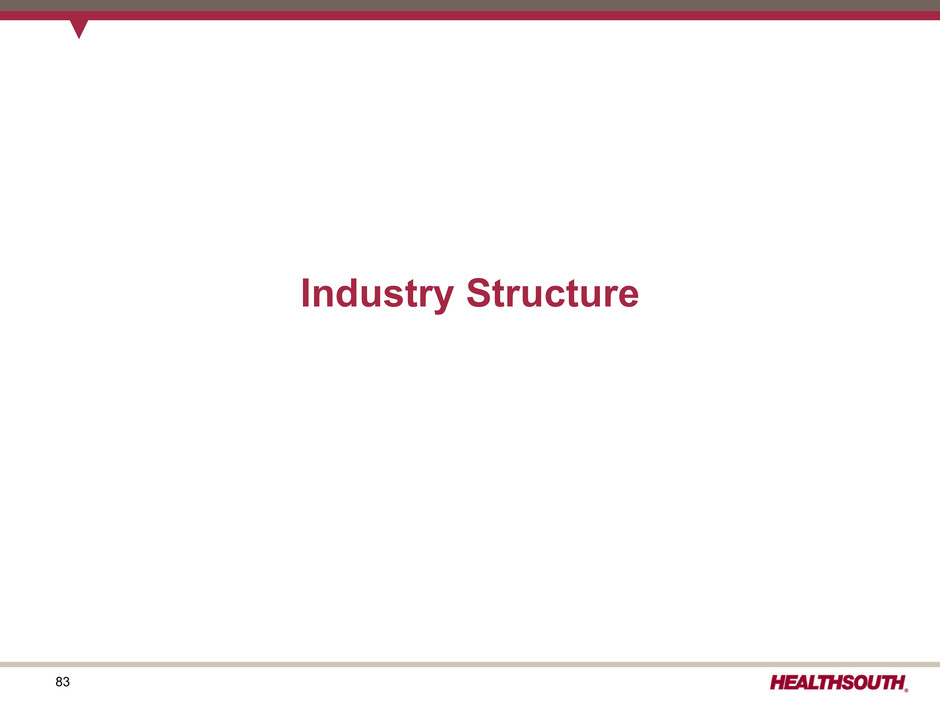
83 Industry Structure
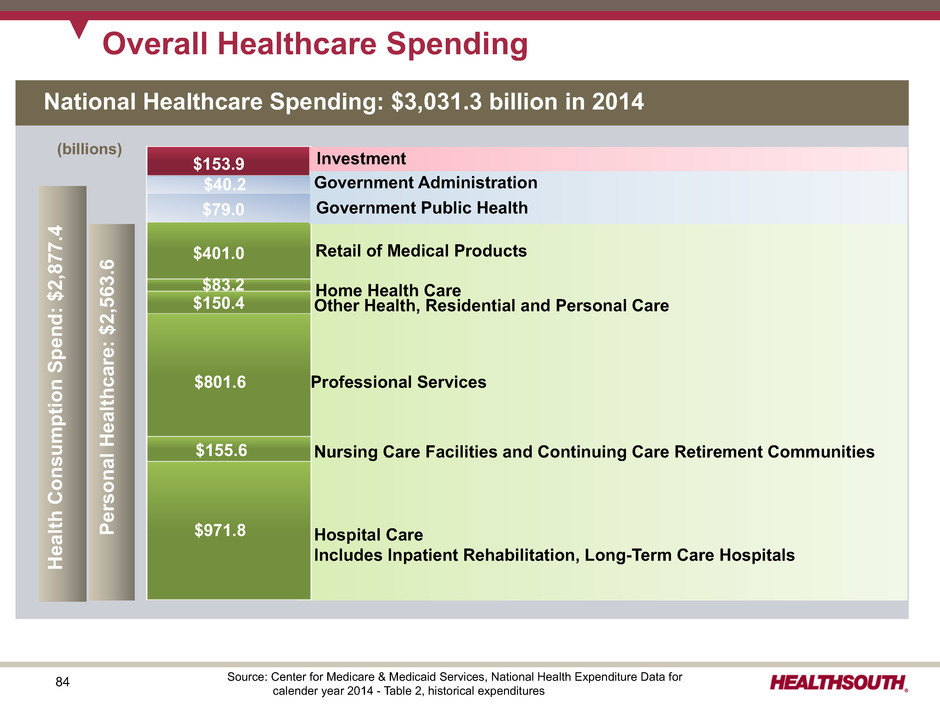
84 Overall Healthcare Spending Hospital Care Includes Inpatient Rehabilitation, Long-Term Care Hospitals $801.6 $150.4 $83.2 $401.0 Nursing Care Facilities and Continuing Care Retirement Communities Professional Services Other Health, Residential and Personal Care Home Health Care Retail of Medical Products $153.9 (billions) Health Consumption Spend: $2,877.4 Personal Healthcare: $2,563. 6 Investment Net Cost of Health InsuranceGovernment Public Health Government Administration $971.8 $155.6 Source: Center for Medicare & Medicaid Services, National Health Expenditure Data for calender year 2014 - Table 2, historical expenditures National Healthcare Spending: $3,031.3 billion in 2014 $40.2 $79.0
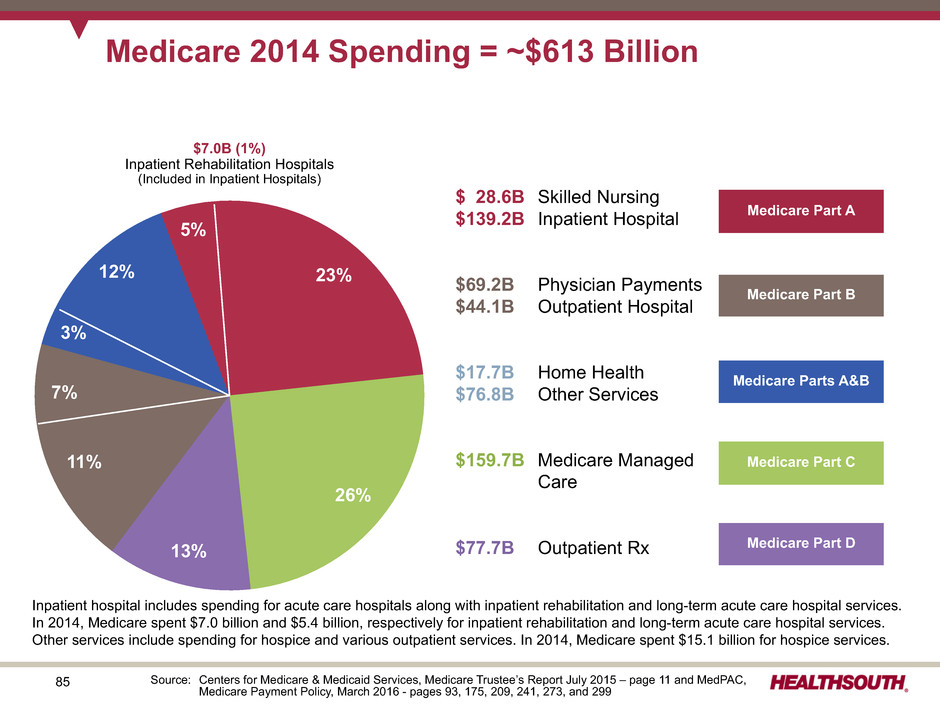
85 Source: Centers for Medicare & Medicaid Services, Medicare Trustee’s Report July 2015 – page 11 and MedPAC, Medicare Payment Policy, March 2016 - pages 93, 175, 209, 241, 273, and 299 Medicare 2014 Spending = ~$613 Billion $ 28.6B Skilled Nursing $139.2B Inpatient Hospital $69.2B Physician Payments $44.1B Outpatient Hospital $17.7B Home Health $76.8B Other Services $159.7B Medicare Managed Care $77.7B Outpatient Rx $7.0B (1%) Inpatient Rehabilitation Hospitals (Included in Inpatient Hospitals) 13% 3% 7% 12% 11% 26% 23% Medicare Part A Medicare Part B Medicare Parts A&B Medicare Part C Medicare Part D 5% Inpatient hospital includes spending for acute care hospitals along with inpatient rehabilitation and long-term acute care hospital services. In 2014, Medicare spent $7.0 billion and $5.4 billion, respectively for inpatient rehabilitation and long-term acute care hospital services. Other services include spending for hospice and various outpatient services. In 2014, Medicare spent $15.1 billion for hospice services.
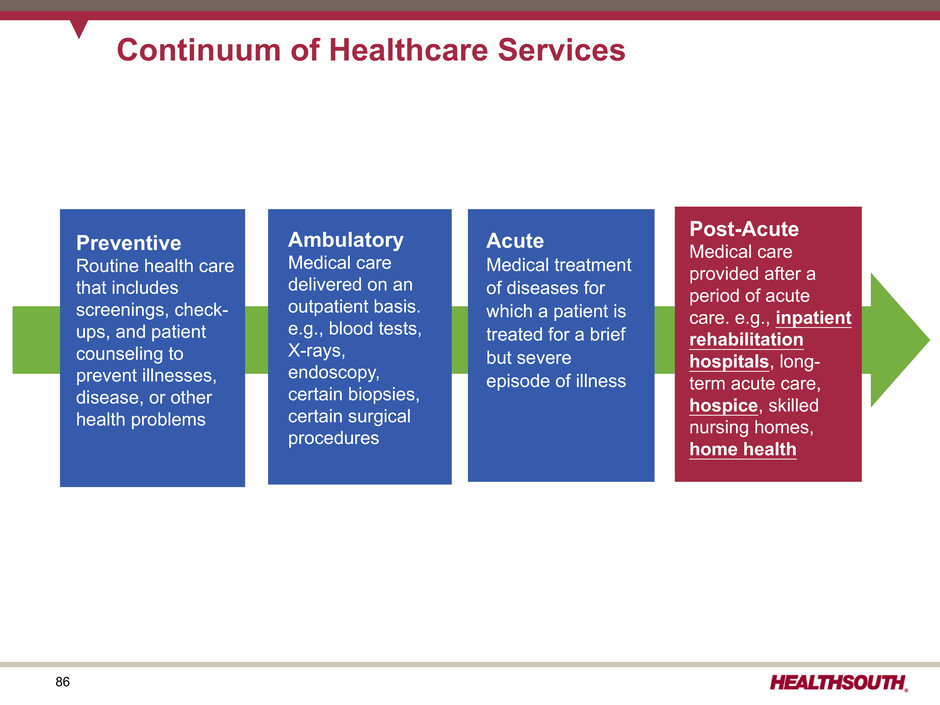
86 Continuum of Healthcare Services Preventive Routine health care that includes screenings, check- ups, and patient counseling to prevent illnesses, disease, or other health problems Acute Medical treatment of diseases for which a patient is treated for a brief but severe episode of illness Ambulatory Medical care delivered on an outpatient basis. e.g., blood tests, X-rays, endoscopy, certain biopsies, certain surgical procedures Post-Acute Medical care provided after a period of acute care. e.g., inpatient rehabilitation hospitals, long- term acute care, hospice, skilled nursing homes, home health
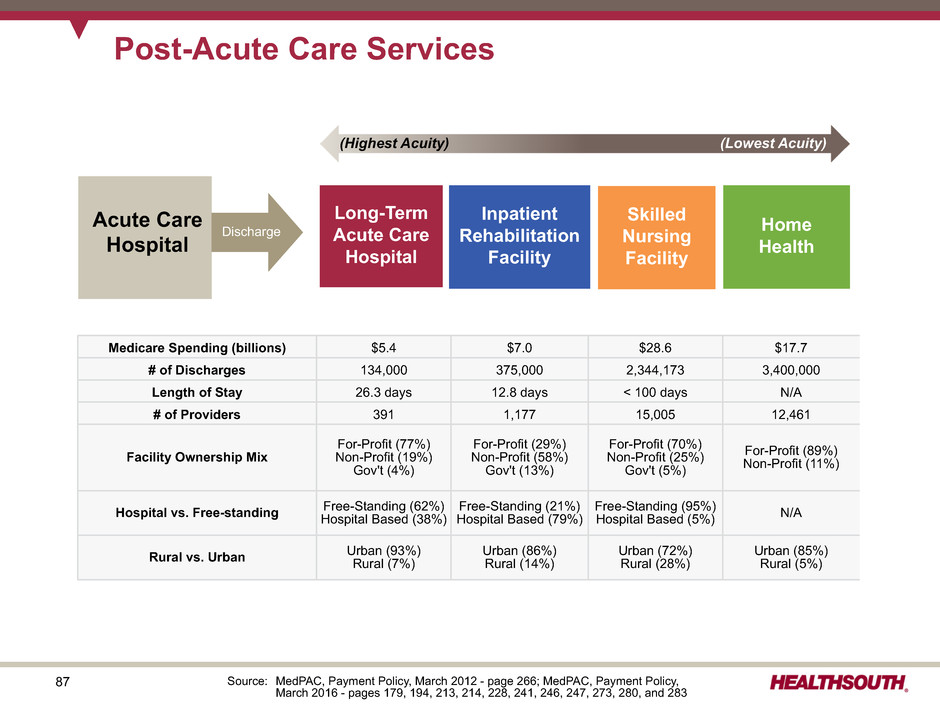
87 Post-Acute Care Services Acute Care Hospital Home Health Long-Term Acute Care Hospital Inpatient Rehabilitation Facility Skilled Nursing Facility Discharge Medicare Spending (billions) $5.4 $7.0 $28.6 $17.7 # of Discharges 134,000 375,000 2,344,173 3,400,000 Length of Stay 26.3 days 12.8 days < 100 days N/A # of Providers 391 1,177 15,005 12,461 Facility Ownership Mix For-Profit (77%) Non-Profit (19%) Gov't (4%) For-Profit (29%) Non-Profit (58%) Gov't (13%) For-Profit (70%) Non-Profit (25%) Gov't (5%) For-Profit (89%) Non-Profit (11%) Hospital vs. Free-standing Free-Standing (62%)Hospital Based (38%) Free-Standing (21%) Hospital Based (79%) Free-Standing (95%) Hospital Based (5%) N/A Rural vs. Urban Urban (93%)Rural (7%) Urban (86%) Rural (14%) Urban (72%) Rural (28%) Urban (85%) Rural (5%) (Lowest Acuity)(Highest Acuity) Source: MedPAC, Payment Policy, March 2012 - page 266; MedPAC, Payment Policy, March 2016 - pages 179, 194, 213, 214, 228, 241, 246, 247, 273, 280, and 283
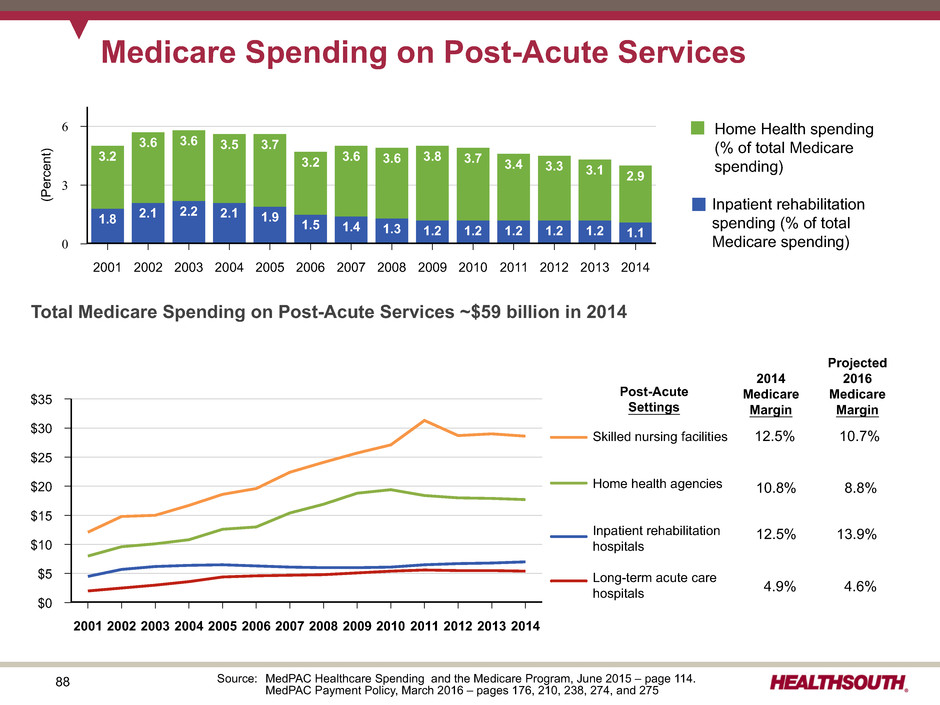
88 $35 $30 $25 $20 $15 $10 $5 $0 2001 2002 2003 2004 2005 2006 2007 2008 2009 2010 2011 2012 2013 2014 Medicare Spending on Post-Acute Services Post-Acute Settings 2014 Medicare Margin Projected 2016 Medicare Margin 12.5% 10.7% 10.8% 8.8% 12.5% 13.9% 4.9% 4.6% Skilled nursing facilities Home health agencies Inpatient rehabilitation hospitals Long-term acute care hospitals Inpatient rehabilitation spending (% of total Medicare spending) 6 3 0 (P er ce nt ) 2001 2002 2003 2004 2005 2006 2007 2008 2009 2010 2011 2012 2013 2014 1.8 2.1 2.2 2.1 1.9 1.5 1.4 1.3 1.2 1.2 1.2 1.2 1.2 1.1 3.2 3.6 3.6 3.5 3.7 3.2 3.6 3.6 3.8 3.7 3.4 3.3 3.1 2.9 Home Health spending (% of total Medicare spending) Total Medicare Spending on Post-Acute Services ~$59 billion in 2014 Source: MedPAC Healthcare Spending and the Medicare Program, June 2015 – page 114. MedPAC Payment Policy, March 2016 – pages 176, 210, 238, 274, and 275
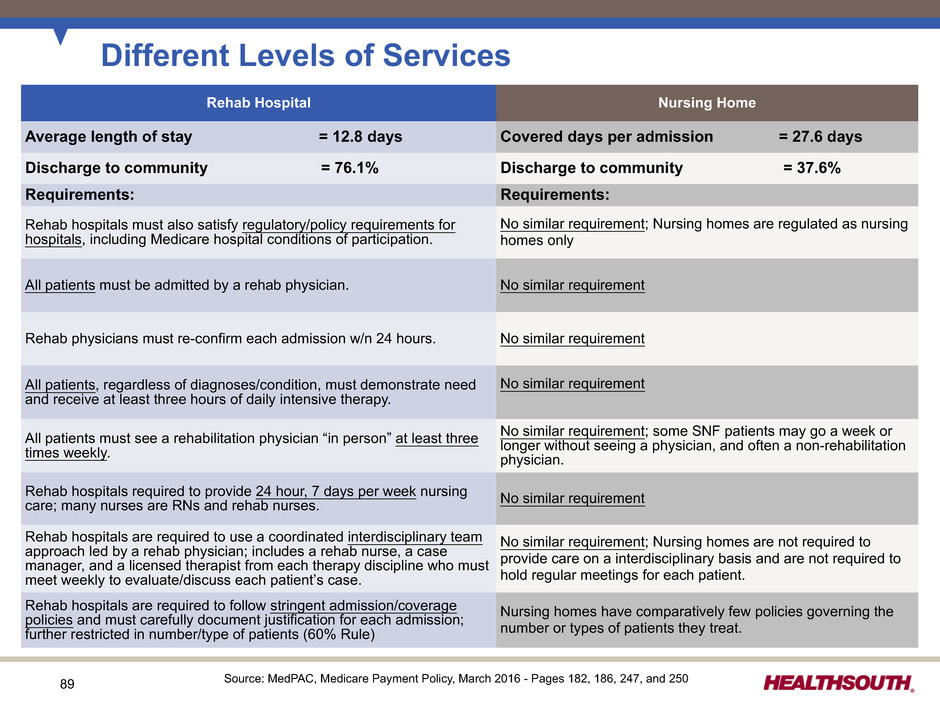
89 Different Levels of Services Rehab Hospital Nursing Home Average length of stay = 12.8 days Covered days per admission = 27.6 days Discharge to community = 76.1% Discharge to community = 37.6% Requirements: Requirements: Rehab hospitals must also satisfy regulatory/policy requirements for hospitals, including Medicare hospital conditions of participation. No similar requirement; Nursing homes are regulated as nursing homes only All patients must be admitted by a rehab physician. No similar requirement Rehab physicians must re-confirm each admission w/n 24 hours. No similar requirement All patients, regardless of diagnoses/condition, must demonstrate need and receive at least three hours of daily intensive therapy. No similar requirement All patients must see a rehabilitation physician “in person” at least three times weekly. No similar requirement; some SNF patients may go a week or longer without seeing a physician, and often a non-rehabilitation physician. Rehab hospitals required to provide 24 hour, 7 days per week nursing care; many nurses are RNs and rehab nurses. No similar requirement Rehab hospitals are required to use a coordinated interdisciplinary team approach led by a rehab physician; includes a rehab nurse, a case manager, and a licensed therapist from each therapy discipline who must meet weekly to evaluate/discuss each patient’s case. No similar requirement; Nursing homes are not required to provide care on a interdisciplinary basis and are not required to hold regular meetings for each patient. Rehab hospitals are required to follow stringent admission/coverage policies and must carefully document justification for each admission; further restricted in number/type of patients (60% Rule) Nursing homes have comparatively few policies governing the number or types of patients they treat. Source: MedPAC, Medicare Payment Policy, March 2016 - Pages 182, 186, 247, and 250
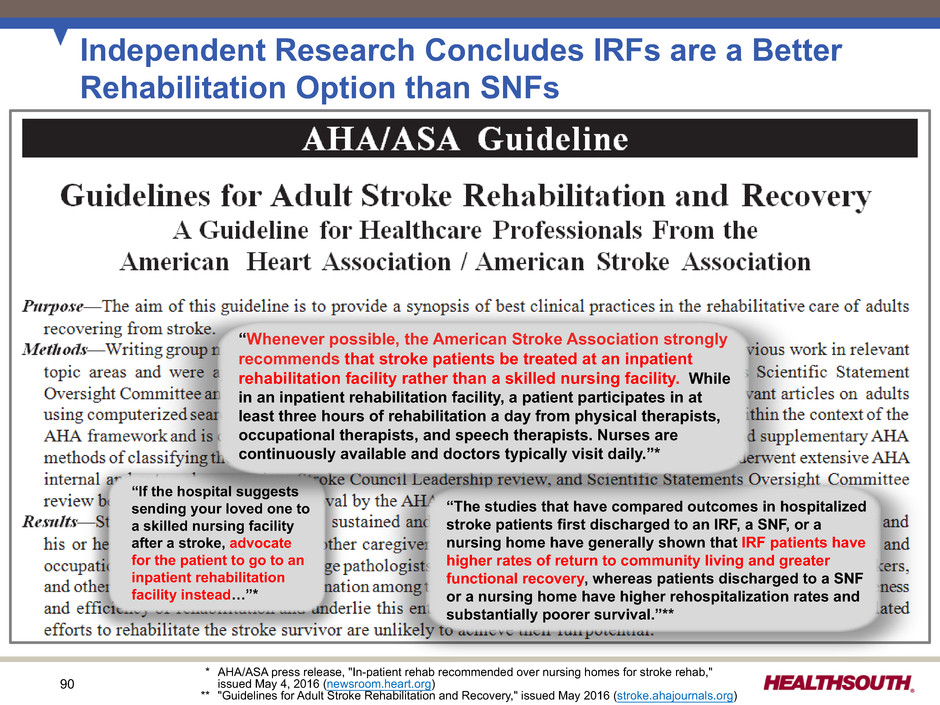
90 Independent Research Concludes IRFs are a Better Rehabilitation Option than SNFs “The studies that have compared outcomes in hospitalized stroke patients first discharged to an IRF, a SNF, or a nursing home have generally shown that IRF patients have higher rates of return to community living and greater functional recovery, whereas patients discharged to a SNF or a nursing home have higher rehospitalization rates and substantially poorer survival.”** “If the hospital suggests sending your loved one to a skilled nursing facility after a stroke, advocate for the patient to go to an inpatient rehabilitation facility instead…”* “Whenever possible, the American Stroke Association strongly recommends that stroke patients be treated at an inpatient rehabilitation facility rather than a skilled nursing facility. While in an inpatient rehabilitation facility, a patient participates in at least three hours of rehabilitation a day from physical therapists, occupational therapists, and speech therapists. Nurses are continuously available and doctors typically visit daily.”* * ** AHA/ASA press release, "In-patient rehab recommended over nursing homes for stroke rehab," issued May 4, 2016 (newsroom.heart.org) "Guidelines for Adult Stroke Rehabilitation and Recovery," issued May 2016 (stroke.ahajournals.org)
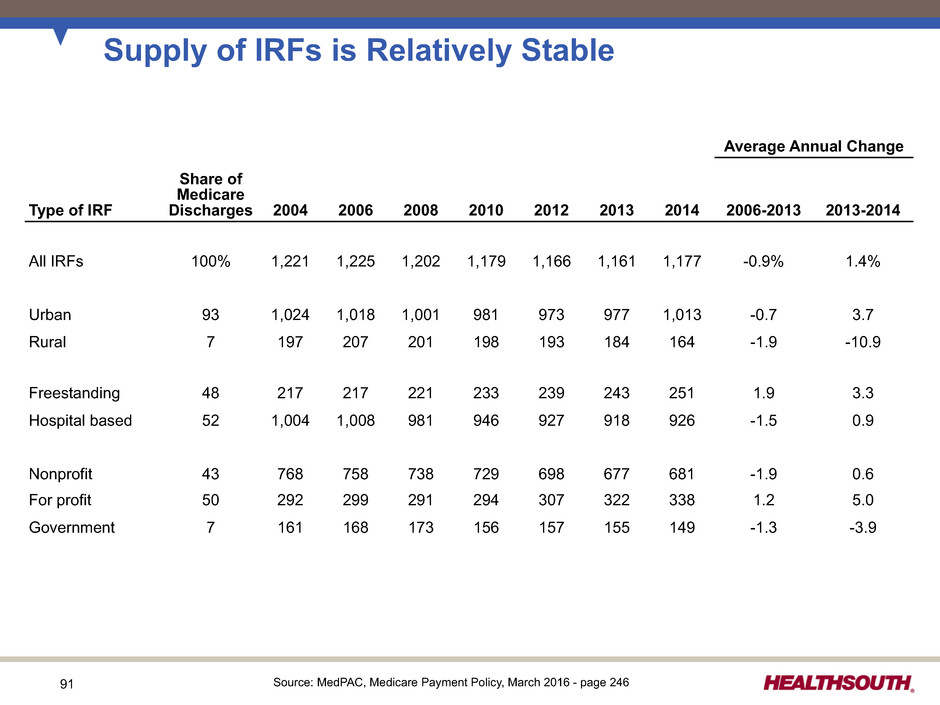
91 Supply of IRFs is Relatively Stable Average Annual Change Share of Medicare DischargesType of IRF 2004 2006 2008 2010 2012 2013 2014 2006-2013 2013-2014 All IRFs 100% 1,221 1,225 1,202 1,179 1,166 1,161 1,177 -0.9% 1.4% Urban 93 1,024 1,018 1,001 981 973 977 1,013 -0.7 3.7 Rural 7 197 207 201 198 193 184 164 -1.9 -10.9 Freestanding 48 217 217 221 233 239 243 251 1.9 3.3 Hospital based 52 1,004 1,008 981 946 927 918 926 -1.5 0.9 Nonprofit 43 768 758 738 729 698 677 681 -1.9 0.6 For profit 50 292 299 291 294 307 322 338 1.2 5.0 Government 7 161 168 173 156 157 155 149 -1.3 -3.9 Source: MedPAC, Medicare Payment Policy, March 2016 - page 246
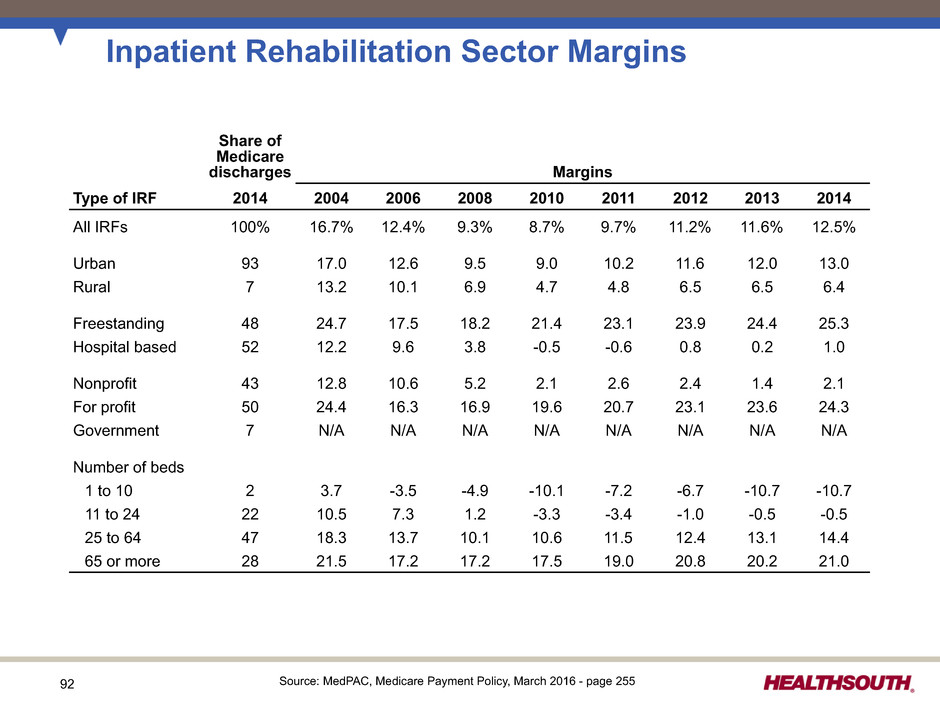
92 Inpatient Rehabilitation Sector Margins Share of Medicare discharges Margins Type of IRF 2014 2004 2006 2008 2010 2011 2012 2013 2014 All IRFs 100% 16.7% 12.4% 9.3% 8.7% 9.7% 11.2% 11.6% 12.5% Urban 93 17.0 12.6 9.5 9.0 10.2 11.6 12.0 13.0 Rural 7 13.2 10.1 6.9 4.7 4.8 6.5 6.5 6.4 Freestanding 48 24.7 17.5 18.2 21.4 23.1 23.9 24.4 25.3 Hospital based 52 12.2 9.6 3.8 -0.5 -0.6 0.8 0.2 1.0 Nonprofit 43 12.8 10.6 5.2 2.1 2.6 2.4 1.4 2.1 For profit 50 24.4 16.3 16.9 19.6 20.7 23.1 23.6 24.3 Government 7 N/A N/A N/A N/A N/A N/A N/A N/A Number of beds 1 to 10 2 3.7 -3.5 -4.9 -10.1 -7.2 -6.7 -10.7 -10.7 11 to 24 22 10.5 7.3 1.2 -3.3 -3.4 -1.0 -0.5 -0.5 25 to 64 47 18.3 13.7 10.1 10.6 11.5 12.4 13.1 14.4 65 or more 28 21.5 17.2 17.2 17.5 19.0 20.8 20.2 21.0 Source: MedPAC, Medicare Payment Policy, March 2016 - page 255
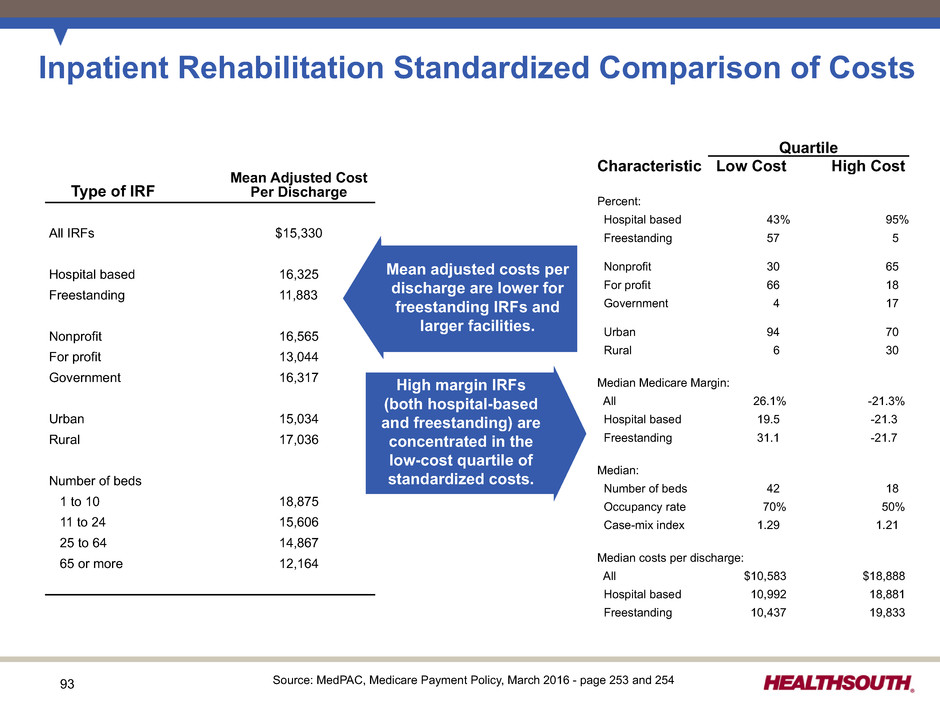
93 Inpatient Rehabilitation Standardized Comparison of Costs Type of IRF Mean Adjusted Cost Per Discharge All IRFs $15,330 Hospital based 16,325 Freestanding 11,883 Nonprofit 16,565 For profit 13,044 Government 16,317 Urban 15,034 Rural 17,036 Number of beds 1 to 10 18,875 11 to 24 15,606 25 to 64 14,867 65 or more 12,164 Quartile Characteristic Low Cost High Cost Percent: Hospital based 43% 95% Freestanding 57 5 Nonprofit 30 65 For profit 66 18 Government 4 17 Urban 94 70 Rural 6 30 Median Medicare Margin: All 26.1% -21.3% Hospital based 19.5 -21.3 Freestanding 31.1 -21.7 Median: Number of beds 42 18 Occupancy rate 70% 50% Case-mix index 1.29 1.21 Median costs per discharge: All $10,583 $18,888 Hospital based 10,992 18,881 Freestanding 10,437 19,833 Mean adjusted costs per discharge are lower for freestanding IRFs and larger facilities. High margin IRFs (both hospital-based and freestanding) are concentrated in the low-cost quartile of standardized costs. Source: MedPAC, Medicare Payment Policy, March 2016 - page 253 and 254
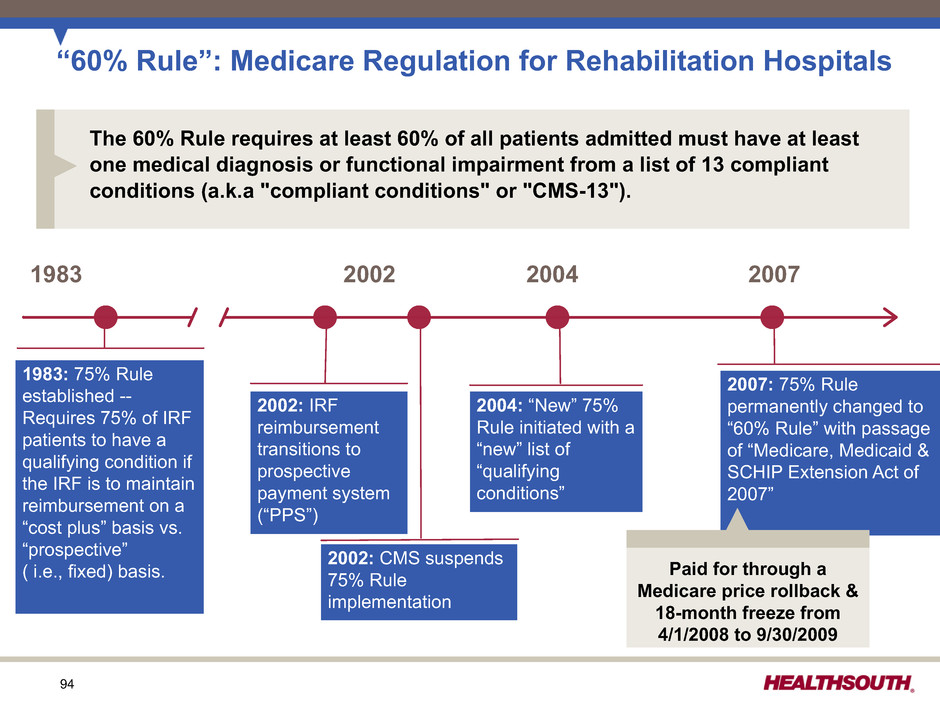
94 “60% Rule”: Medicare Regulation for Rehabilitation Hospitals 1983 1983: 75% Rule established -- Requires 75% of IRF patients to have a qualifying condition if the IRF is to maintain reimbursement on a “cost plus” basis vs. “prospective” ( i.e., fixed) basis. 2002 2004 2007 2002: IRF reimbursement transitions to prospective payment system (“PPS”) 2002: CMS suspends 75% Rule implementation 2004: “New” 75% Rule initiated with a “new” list of “qualifying conditions” 2007: 75% Rule permanently changed to “60% Rule” with passage of “Medicare, Medicaid & SCHIP Extension Act of 2007” Paid for through a Medicare price rollback & 18-month freeze from 4/1/2008 to 9/30/2009 The 60% Rule requires at least 60% of all patients admitted must have at least one medical diagnosis or functional impairment from a list of 13 compliant conditions (a.k.a "compliant conditions" or "CMS-13").
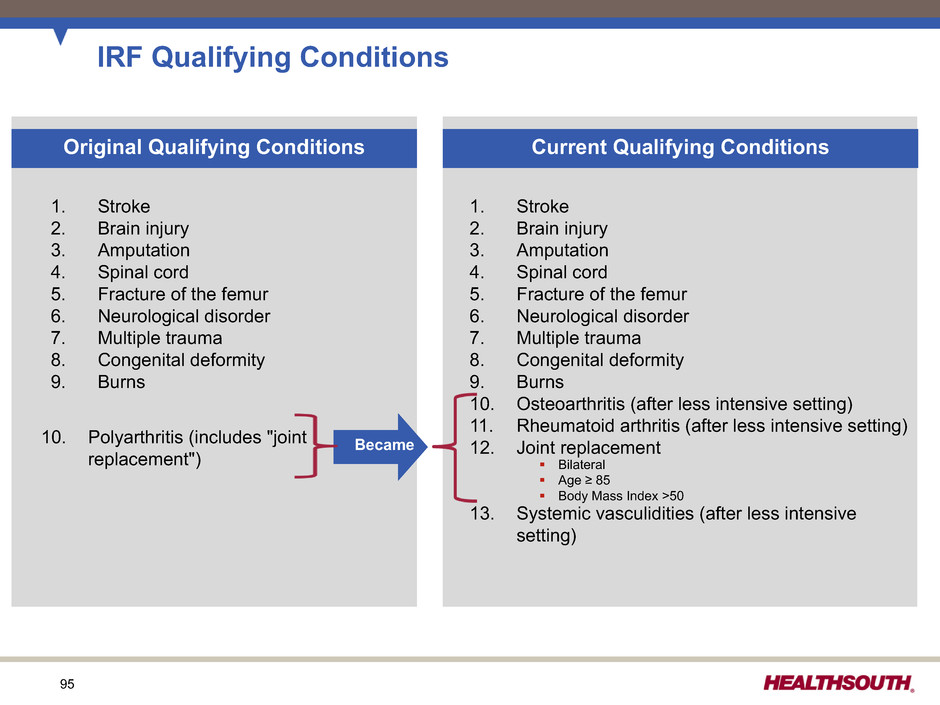
95 1. Stroke 2. Brain injury 3. Amputation 4. Spinal cord 5. Fracture of the femur 6. Neurological disorder 7. Multiple trauma 8. Congenital deformity 9. Burns IRF Qualifying Conditions 1. Stroke 2. Brain injury 3. Amputation 4. Spinal cord 5. Fracture of the femur 6. Neurological disorder 7. Multiple trauma 8. Congenital deformity 9. Burns 10. Osteoarthritis (after less intensive setting) 11. Rheumatoid arthritis (after less intensive setting) 12. Joint replacement 13. Systemic vasculidities (after less intensive setting) Original Qualifying Conditions Current Qualifying Conditions § Bilateral § Age ≥ 85 § Body Mass Index >50 10. Polyarthritis (includes "joint replacement") Became
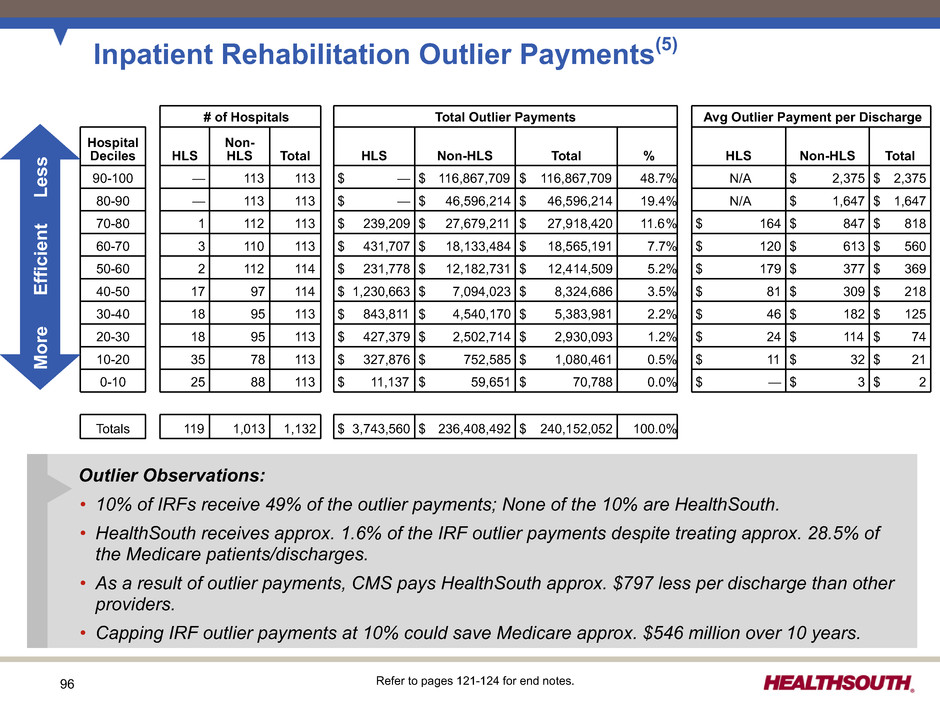
96 Inpatient Rehabilitation Outlier Payments(5) # of Hospitals Total Outlier Payments Avg Outlier Payment per Discharge Hospital Deciles HLS Non- HLS Total HLS Non-HLS Total % HLS Non-HLS Total 90-100 — 113 113 $ — $ 116,867,709 $ 116,867,709 48.7% N/A $ 2,375 $ 2,375 80-90 — 113 113 $ — $ 46,596,214 $ 46,596,214 19.4% N/A $ 1,647 $ 1,647 70-80 1 112 113 $ 239,209 $ 27,679,211 $ 27,918,420 11.6% $ 164 $ 847 $ 818 60-70 3 110 113 $ 431,707 $ 18,133,484 $ 18,565,191 7.7% $ 120 $ 613 $ 560 50-60 2 112 114 $ 231,778 $ 12,182,731 $ 12,414,509 5.2% $ 179 $ 377 $ 369 40-50 17 97 114 $ 1,230,663 $ 7,094,023 $ 8,324,686 3.5% $ 81 $ 309 $ 218 30-40 18 95 113 $ 843,811 $ 4,540,170 $ 5,383,981 2.2% $ 46 $ 182 $ 125 20-30 18 95 113 $ 427,379 $ 2,502,714 $ 2,930,093 1.2% $ 24 $ 114 $ 74 10-20 35 78 113 $ 327,876 $ 752,585 $ 1,080,461 0.5% $ 11 $ 32 $ 21 0-10 25 88 113 $ 11,137 $ 59,651 $ 70,788 0.0% $ — $ 3 $ 2 Totals 119 1,013 1,132 $ 3,743,560 $ 236,408,492 $ 240,152,052 100.0% Refer to pages 121-124 for end notes. More Efficient Less Outlier Observations: • 10% of IRFs receive 49% of the outlier payments; None of the 10% are HealthSouth. • HealthSouth receives approx. 1.6% of the IRF outlier payments despite treating approx. 28.5% of the Medicare patients/discharges. • As a result of outlier payments, CMS pays HealthSouth approx. $797 less per discharge than other providers. • Capping IRF outlier payments at 10% could save Medicare approx. $546 million over 10 years.
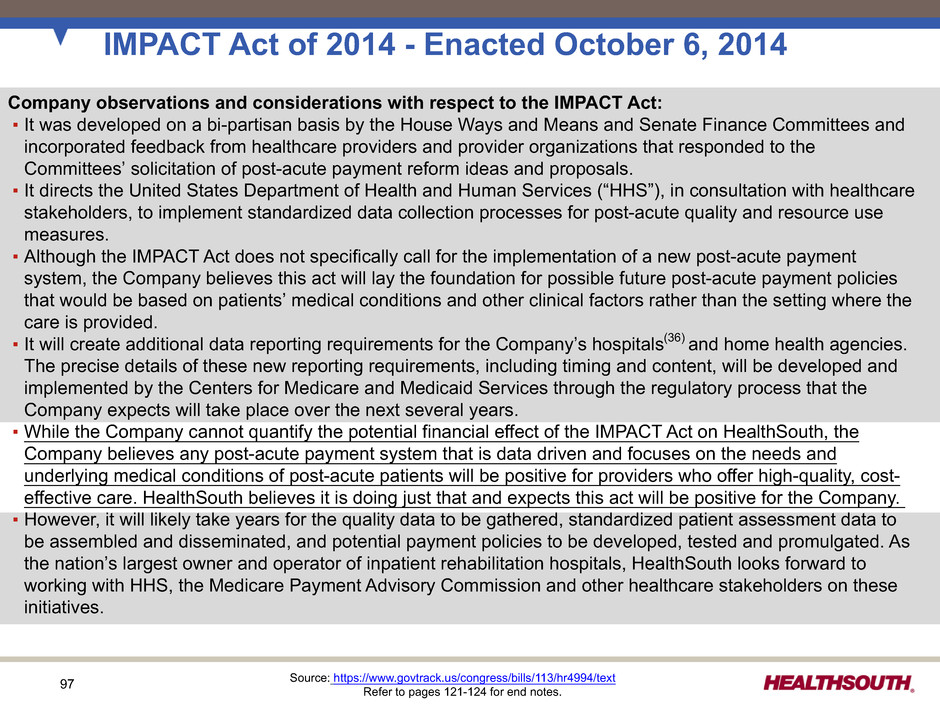
97 IMPACT Act of 2014 - Enacted October 6, 2014 Company observations and considerations with respect to the IMPACT Act: ▪ It was developed on a bi-partisan basis by the House Ways and Means and Senate Finance Committees and incorporated feedback from healthcare providers and provider organizations that responded to the Committees’ solicitation of post-acute payment reform ideas and proposals. ▪ It directs the United States Department of Health and Human Services (“HHS”), in consultation with healthcare stakeholders, to implement standardized data collection processes for post-acute quality and resource use measures. ▪ Although the IMPACT Act does not specifically call for the implementation of a new post-acute payment system, the Company believes this act will lay the foundation for possible future post-acute payment policies that would be based on patients’ medical conditions and other clinical factors rather than the setting where the care is provided. ▪ It will create additional data reporting requirements for the Company’s hospitals(36) and home health agencies. The precise details of these new reporting requirements, including timing and content, will be developed and implemented by the Centers for Medicare and Medicaid Services through the regulatory process that the Company expects will take place over the next several years. ▪ While the Company cannot quantify the potential financial effect of the IMPACT Act on HealthSouth, the Company believes any post-acute payment system that is data driven and focuses on the needs and underlying medical conditions of post-acute patients will be positive for providers who offer high-quality, cost- effective care. HealthSouth believes it is doing just that and expects this act will be positive for the Company. ▪ However, it will likely take years for the quality data to be gathered, standardized patient assessment data to be assembled and disseminated, and potential payment policies to be developed, tested and promulgated. As the nation’s largest owner and operator of inpatient rehabilitation hospitals, HealthSouth looks forward to working with HHS, the Medicare Payment Advisory Commission and other healthcare stakeholders on these initiatives. Source: https://www.govtrack.us/congress/bills/113/hr4994/text Refer to pages 121-124 for end notes.
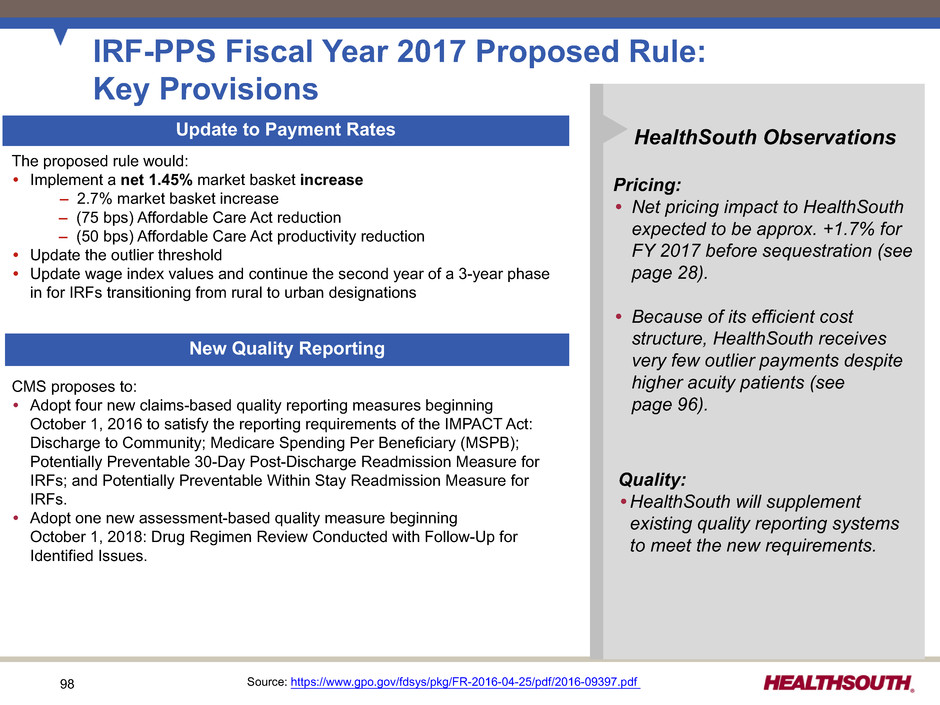
98 IRF-PPS Fiscal Year 2017 Proposed Rule: Key Provisions Source: https://www.gpo.gov/fdsys/pkg/FR-2016-04-25/pdf/2016-09397.pdf New Quality Reporting Update to Payment Rates HealthSouth Observations Pricing: • Net pricing impact to HealthSouth expected to be approx. +1.7% for FY 2017 before sequestration (see page 28). • Because of its efficient cost structure, HealthSouth receives very few outlier payments despite higher acuity patients (see page 96). Quality: • HealthSouth will supplement existing quality reporting systems to meet the new requirements. The proposed rule would: • Implement a net 1.45% market basket increase – 2.7% market basket increase – (75 bps) Affordable Care Act reduction – (50 bps) Affordable Care Act productivity reduction • Update the outlier threshold • Update wage index values and continue the second year of a 3-year phase in for IRFs transitioning from rural to urban designations CMS proposes to: • Adopt four new claims-based quality reporting measures beginning October 1, 2016 to satisfy the reporting requirements of the IMPACT Act: Discharge to Community; Medicare Spending Per Beneficiary (MSPB); Potentially Preventable 30-Day Post-Discharge Readmission Measure for IRFs; and Potentially Preventable Within Stay Readmission Measure for IRFs. • Adopt one new assessment-based quality measure beginning October 1, 2018: Drug Regimen Review Conducted with Follow-Up for Identified Issues.
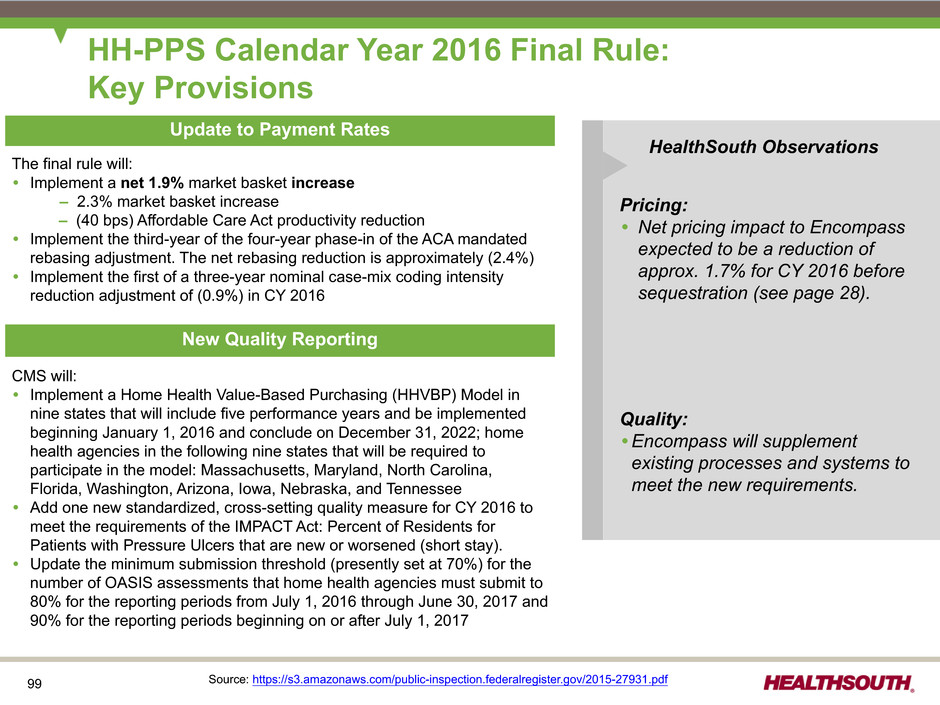
99 HH-PPS Calendar Year 2016 Final Rule: Key Provisions Source: https://s3.amazonaws.com/public-inspection.federalregister.gov/2015-27931.pdf New Quality Reporting Update to Payment Rates HealthSouth Observations Pricing: • Net pricing impact to Encompass expected to be a reduction of approx. 1.7% for CY 2016 before sequestration (see page 28). Quality: • Encompass will supplement existing processes and systems to meet the new requirements. The final rule will: • Implement a net 1.9% market basket increase – 2.3% market basket increase – (40 bps) Affordable Care Act productivity reduction • Implement the third-year of the four-year phase-in of the ACA mandated rebasing adjustment. The net rebasing reduction is approximately (2.4%) • Implement the first of a three-year nominal case-mix coding intensity reduction adjustment of (0.9%) in CY 2016 CMS will: • Implement a Home Health Value-Based Purchasing (HHVBP) Model in nine states that will include five performance years and be implemented beginning January 1, 2016 and conclude on December 31, 2022; home health agencies in the following nine states that will be required to participate in the model: Massachusetts, Maryland, North Carolina, Florida, Washington, Arizona, Iowa, Nebraska, and Tennessee • Add one new standardized, cross-setting quality measure for CY 2016 to meet the requirements of the IMPACT Act: Percent of Residents for Patients with Pressure Ulcers that are new or worsened (short stay). • Update the minimum submission threshold (presently set at 70%) for the number of OASIS assessments that home health agencies must submit to 80% for the reporting periods from July 1, 2016 through June 30, 2017 and 90% for the reporting periods beginning on or after July 1, 2017
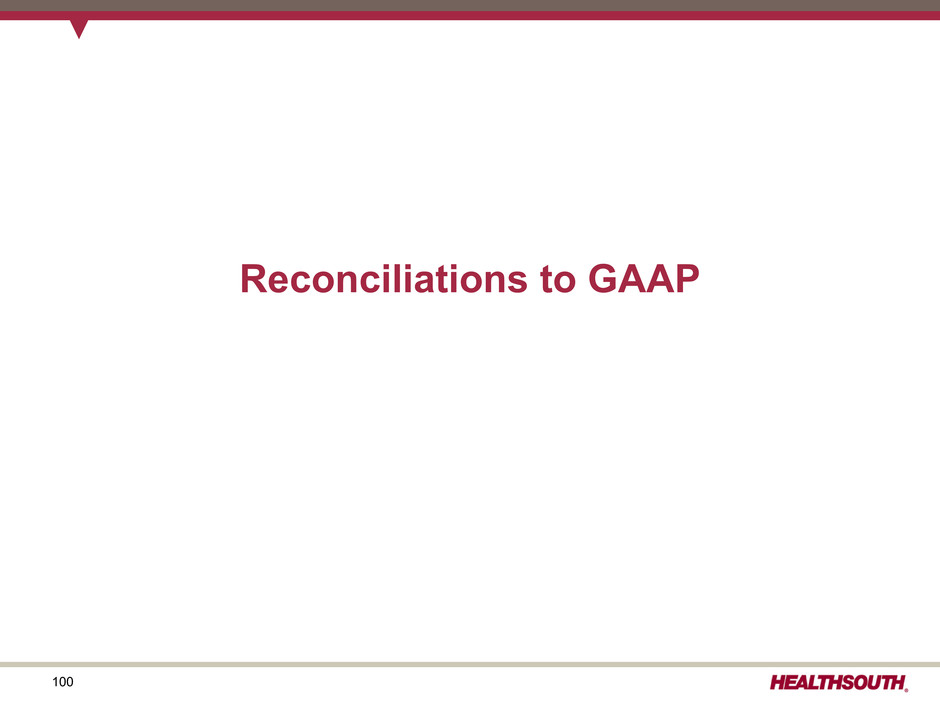
100 Reconciliations to GAAP
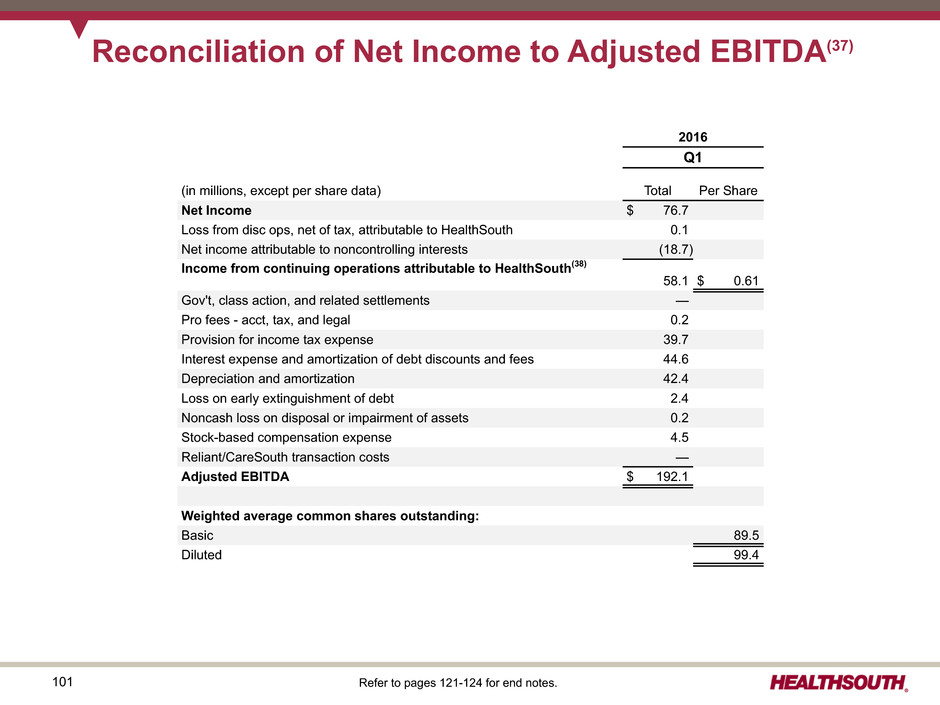
101 Reconciliation of Net Income to Adjusted EBITDA(37) Refer to pages 121-124 for end notes. 2016 Q1 (in millions, except per share data) Total Per Share Net Income $ 76.7 Loss from disc ops, net of tax, attributable to HealthSouth 0.1 Net income attributable to noncontrolling interests (18.7) Income from continuing operations attributable to HealthSouth(38) 58.1 $ 0.61 Gov't, class action, and related settlements — Pro fees - acct, tax, and legal 0.2 Provision for income tax expense 39.7 Interest expense and amortization of debt discounts and fees 44.6 Depreciation and amortization 42.4 Loss on early extinguishment of debt 2.4 Noncash loss on disposal or impairment of assets 0.2 Stock-based compensation expense 4.5 Reliant/CareSouth transaction costs — Adjusted EBITDA $ 192.1 Weighted average common shares outstanding: Basic 89.5 Diluted 99.4

102 Reconciliation of Net Income to Adjusted EBITDA(37) 2015 Q1 Q2 Q3 Q4 Full Year (in millions, except per share data) Total Per Share Total Per Share Total Per Share Total Per Share Total Per Share Net Income $ 59.0 $ 60.2 $ 67.8 $ 65.8 $ 252.8 Loss (income) from disc ops, net of tax, attributable to HealthSouth 0.3 1.6 (0.3) (0.7) 0.9 Net income attributable to noncontrolling interests (16.5) (17.3) (17.1) (18.8) (69.7) Income from continuing operations attributable to HealthSouth(38) 42.8 $ 0.44 44.5 $ 0.47 50.4 $ 0.52 46.3 $ 0.48 184.0 $ 1.92 Gov't, class action, and related settlements 8.0 — — (0.5) 7.5 Pro fees - acct, tax, and legal 2.2 0.1 0.4 0.3 3.0 Provision for income tax expense 30.3 32.2 35.9 43.5 141.9 Interest expense and amortization of debt discounts and fees 31.8 30.9 35.6 44.6 142.9 Depreciation and amortization 31.9 32.7 33.7 41.4 139.7 Loss on early extinguishment of debt 1.2 18.8 — 2.4 22.4 Noncash (gain) loss on disposal or impairment of assets (1.5) 0.8 0.9 2.4 2.6 Stock-based compensation expense 9.4 6.2 6.2 4.4 26.2 Reliant/CareSouth transaction costs — 3.3 2.3 6.7 12.3 Adjusted EBITDA $ 156.1 $ 169.5 $ 165.4 $ 191.5 $ 682.5 Weighted average common shares outstanding: Basic 87.1 89.8 90.6 90.1 89.4 Diluted 101.1 101.5 101.5 100.6 101.0 Refer to pages 121-124 for end notes.
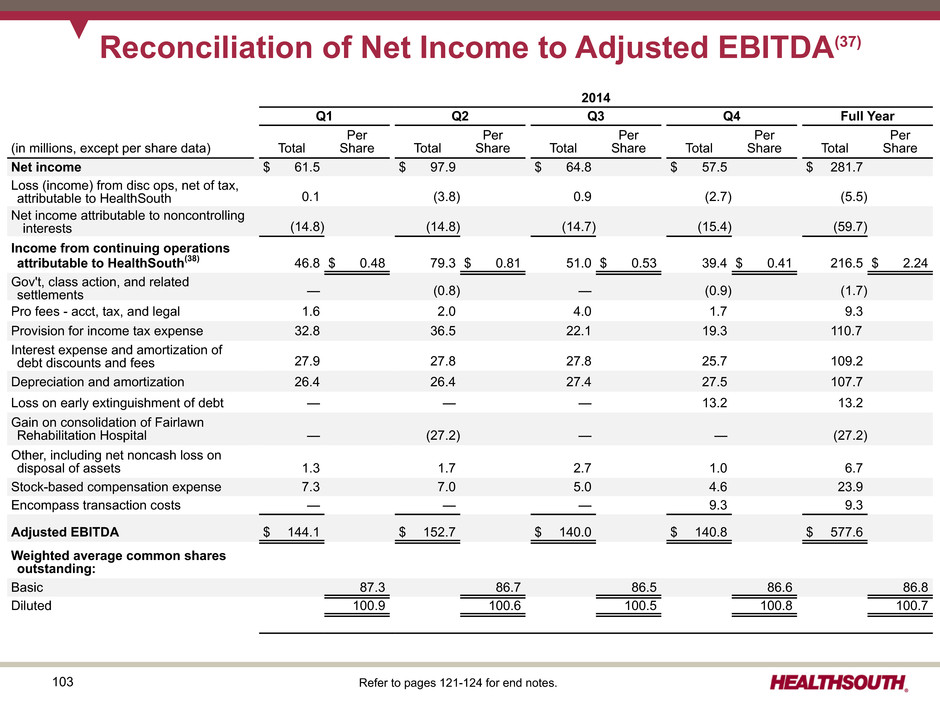
103 Reconciliation of Net Income to Adjusted EBITDA(37) 2014 Q1 Q2 Q3 Q4 Full Year (in millions, except per share data) Total Per Share Total Per Share Total Per Share Total Per Share Total Per Share Net income $ 61.5 $ 97.9 $ 64.8 $ 57.5 $ 281.7 Loss (income) from disc ops, net of tax, attributable to HealthSouth 0.1 (3.8) 0.9 (2.7) (5.5) Net income attributable to noncontrolling interests (14.8) (14.8) (14.7) (15.4) (59.7) Income from continuing operations attributable to HealthSouth(38) 46.8 $ 0.48 79.3 $ 0.81 51.0 $ 0.53 39.4 $ 0.41 216.5 $ 2.24 Gov't, class action, and related settlements — (0.8) — (0.9) (1.7) Pro fees - acct, tax, and legal 1.6 2.0 4.0 1.7 9.3 Provision for income tax expense 32.8 36.5 22.1 19.3 110.7 Interest expense and amortization of debt discounts and fees 27.9 27.8 27.8 25.7 109.2 Depreciation and amortization 26.4 26.4 27.4 27.5 107.7 Loss on early extinguishment of debt — — — 13.2 13.2 Gain on consolidation of Fairlawn Rehabilitation Hospital — (27.2) — — (27.2) Other, including net noncash loss on disposal of assets 1.3 1.7 2.7 1.0 6.7 Stock-based compensation expense 7.3 7.0 5.0 4.6 23.9 Encompass transaction costs — — — 9.3 9.3 Adjusted EBITDA $ 144.1 $ 152.7 $ 140.0 $ 140.8 $ 577.6 Weighted average common shares outstanding: Basic 87.3 86.7 86.5 86.6 86.8 Diluted 100.9 100.6 100.5 100.8 100.7 Refer to pages 121-124 for end notes.
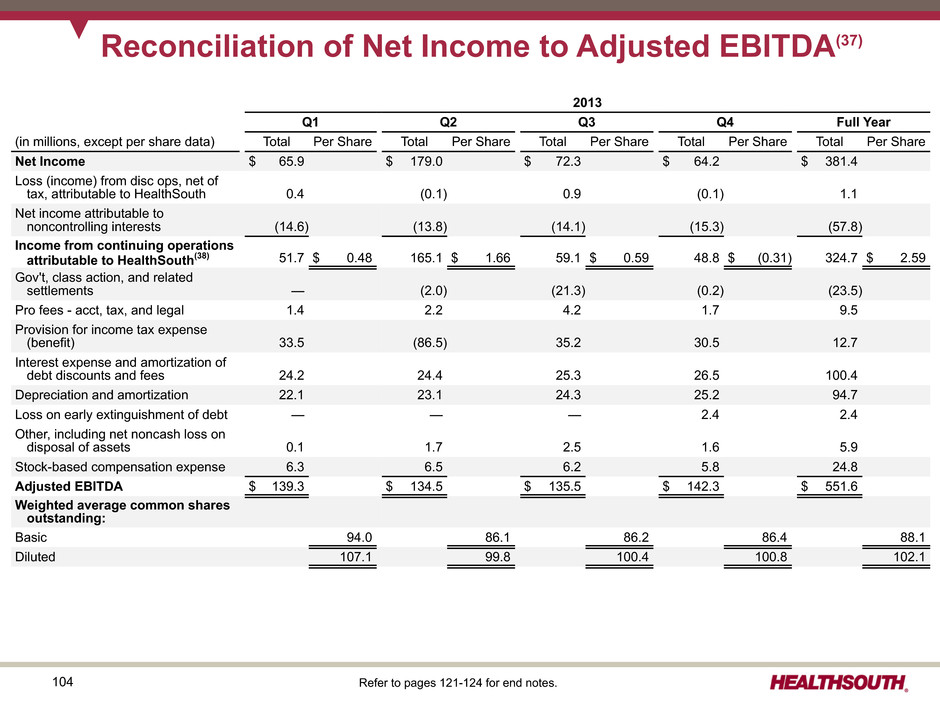
104 Reconciliation of Net Income to Adjusted EBITDA(37) 2013 Q1 Q2 Q3 Q4 Full Year (in millions, except per share data) Total Per Share Total Per Share Total Per Share Total Per Share Total Per Share Net Income $ 65.9 $ 179.0 $ 72.3 $ 64.2 $ 381.4 Loss (income) from disc ops, net of tax, attributable to HealthSouth 0.4 (0.1) 0.9 (0.1) 1.1 Net income attributable to noncontrolling interests (14.6) (13.8) (14.1) (15.3) (57.8) Income from continuing operations attributable to HealthSouth(38) 51.7 $ 0.48 165.1 $ 1.66 59.1 $ 0.59 48.8 $ (0.31) 324.7 $ 2.59 Gov't, class action, and related settlements — (2.0) (21.3) (0.2) (23.5) Pro fees - acct, tax, and legal 1.4 2.2 4.2 1.7 9.5 Provision for income tax expense (benefit) 33.5 (86.5) 35.2 30.5 12.7 Interest expense and amortization of debt discounts and fees 24.2 24.4 25.3 26.5 100.4 Depreciation and amortization 22.1 23.1 24.3 25.2 94.7 Loss on early extinguishment of debt — — — 2.4 2.4 Other, including net noncash loss on disposal of assets 0.1 1.7 2.5 1.6 5.9 Stock-based compensation expense 6.3 6.5 6.2 5.8 24.8 Adjusted EBITDA $ 139.3 $ 134.5 $ 135.5 $ 142.3 $ 551.6 Weighted average common shares outstanding: Basic 94.0 86.1 86.2 86.4 88.1 Diluted 107.1 99.8 100.4 100.8 102.1 Refer to pages 121-124 for end notes.
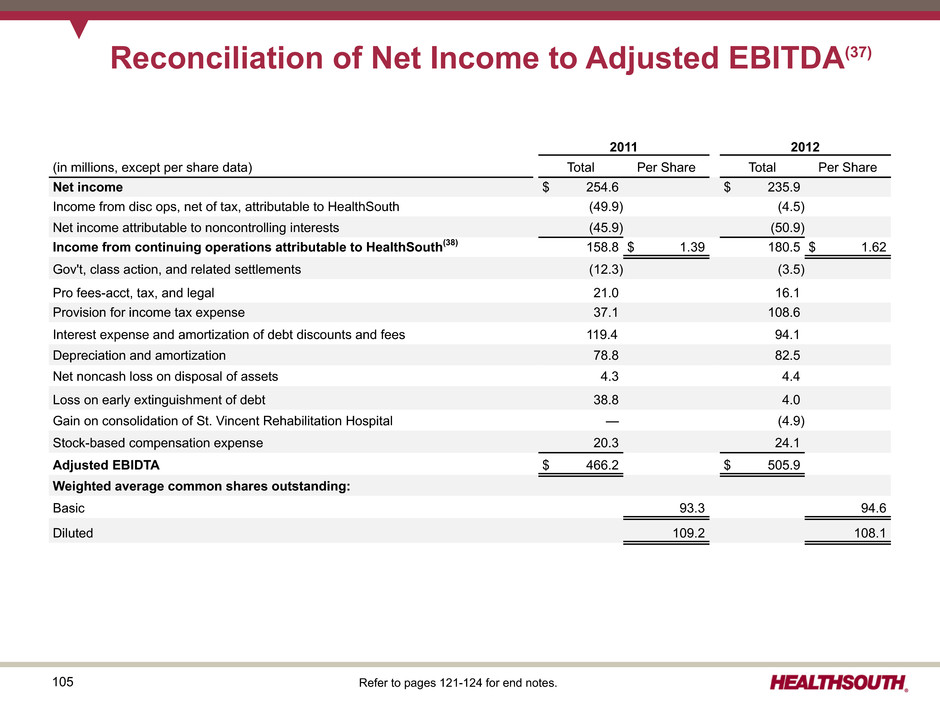
105 Reconciliation of Net Income to Adjusted EBITDA(37) 2011 2012 (in millions, except per share data) Total Per Share Total Per Share Net income $ 254.6 $ 235.9 Income from disc ops, net of tax, attributable to HealthSouth (49.9) (4.5) Net income attributable to noncontrolling interests (45.9) (50.9) Income from continuing operations attributable to HealthSouth(38) 158.8 $ 1.39 180.5 $ 1.62 Gov't, class action, and related settlements (12.3) (3.5) Pro fees-acct, tax, and legal 21.0 16.1 Provision for income tax expense 37.1 108.6 Interest expense and amortization of debt discounts and fees 119.4 94.1 Depreciation and amortization 78.8 82.5 Net noncash loss on disposal of assets 4.3 4.4 Loss on early extinguishment of debt 38.8 4.0 Gain on consolidation of St. Vincent Rehabilitation Hospital — (4.9) Stock-based compensation expense 20.3 24.1 Adjusted EBIDTA $ 466.2 $ 505.9 Weighted average common shares outstanding: Basic 93.3 94.6 Diluted 109.2 108.1 Refer to pages 121-124 for end notes.

106 Three Months Ended Year Ended March 31, December 31, 2016 2015 2015 2014 (In Millions) Total segment Adjusted EBITDA $ 219.5 $ 181.3 $ 774.1 $ 669.2 General and administrative expenses (31.9) (34.6) (133.3) (124.8) Depreciation and amortization (42.4) (31.9) (139.7) (107.7) (Loss) gain on disposal or impairment of assets (0.2) 1.5 (2.6) (6.7) Government, class action, and related settlements — (8.0) (7.5) 1.7 Professional fees - accounting, tax, and legal (0.2) (2.2) (3.0) (9.3) Loss on early extinguishment of debt (2.4) (1.2) (22.4) (13.2) Interest expense and amortization of debt discounts and fees (44.6) (31.8) (142.9) (109.2) Gain on consolidation of former equity method hospital — — — 27.2 Net income attributable to noncontrolling interests 18.7 16.5 69.7 59.7 Gain related to SCA equity interest — — 3.2 — Income from continuing operations before income tax expense $ 116.5 $ 89.6 $ 395.6 $ 386.9 Reconciliation of Segment Adjusted EBITDA to Income from Continuing Operations Before Income Tax Expense
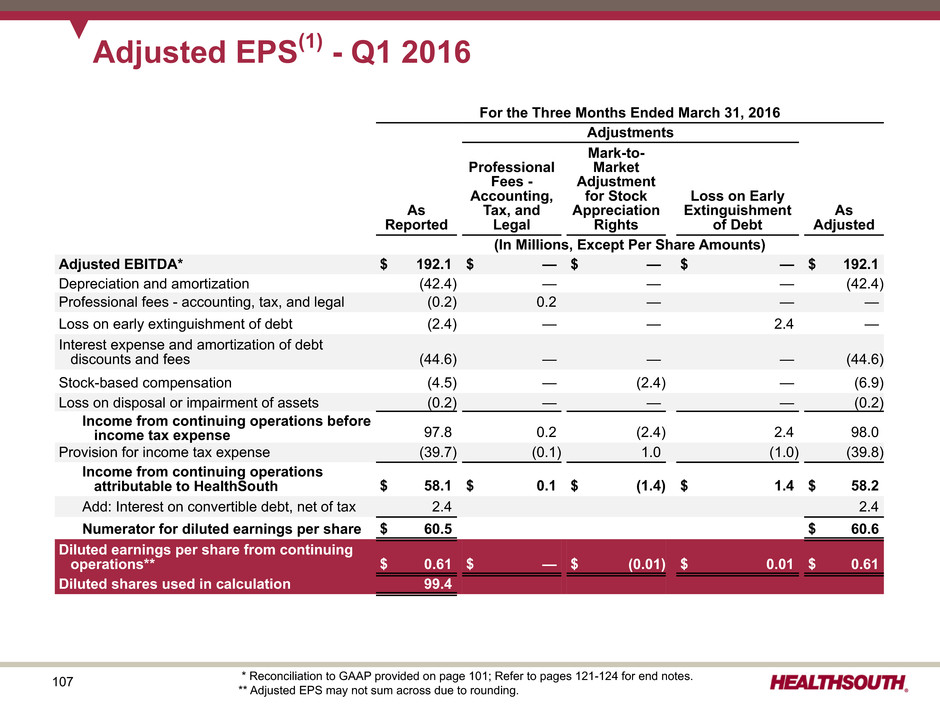
107 For the Three Months Ended March 31, 2016 Adjustments As Reported Professional Fees - Accounting, Tax, and Legal Mark-to- Market Adjustment for Stock Appreciation Rights Loss on Early Extinguishment of Debt As Adjusted (In Millions, Except Per Share Amounts) Adjusted EBITDA* $ 192.1 $ — $ — $ — $ 192.1 Depreciation and amortization (42.4) — — — (42.4) Professional fees - accounting, tax, and legal (0.2) 0.2 — — — Loss on early extinguishment of debt (2.4) — — 2.4 — Interest expense and amortization of debt discounts and fees (44.6) — — — (44.6) Stock-based compensation (4.5) — (2.4) — (6.9) Loss on disposal or impairment of assets (0.2) — — — (0.2) Income from continuing operations before income tax expense 97.8 0.2 (2.4) 2.4 98.0 Provision for income tax expense (39.7) (0.1) 1.0 (1.0) (39.8) Income from continuing operations attributable to HealthSouth $ 58.1 $ 0.1 $ (1.4) $ 1.4 $ 58.2 Add: Interest on convertible debt, net of tax 2.4 2.4 Numerator for diluted earnings per share $ 60.5 $ 60.6 Diluted earnings per share from continuing operations** $ 0.61 $ — $ (0.01) $ 0.01 $ 0.61 Diluted shares used in calculation 99.4 Adjusted EPS(1) - Q1 2016 * Reconciliation to GAAP provided on page 101; Refer to pages 121-124 for end notes. ** Adjusted EPS may not sum across due to rounding.
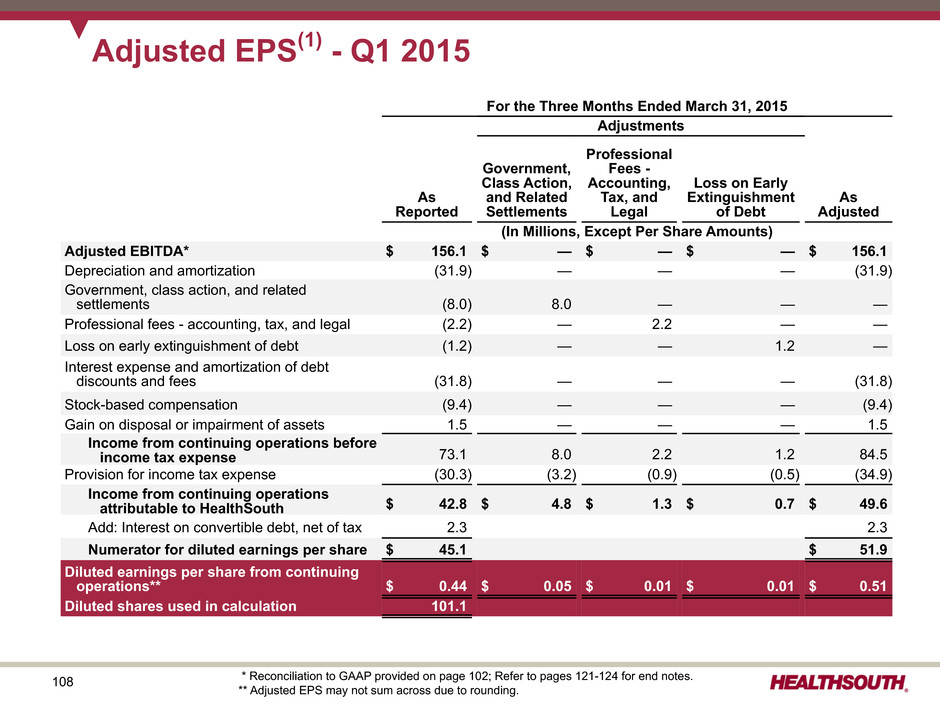
108 For the Three Months Ended March 31, 2015 Adjustments As Reported Government, Class Action, and Related Settlements Professional Fees - Accounting, Tax, and Legal Loss on Early Extinguishment of Debt As Adjusted (In Millions, Except Per Share Amounts) Adjusted EBITDA* $ 156.1 $ — $ — $ — $ 156.1 Depreciation and amortization (31.9) — — — (31.9) Government, class action, and related settlements (8.0) 8.0 — — — Professional fees - accounting, tax, and legal (2.2) — 2.2 — — Loss on early extinguishment of debt (1.2) — — 1.2 — Interest expense and amortization of debt discounts and fees (31.8) — — — (31.8) Stock-based compensation (9.4) — — — (9.4) Gain on disposal or impairment of assets 1.5 — — — 1.5 Income from continuing operations before income tax expense 73.1 8.0 2.2 1.2 84.5 Provision for income tax expense (30.3) (3.2) (0.9) (0.5) (34.9) Income from continuing operations attributable to HealthSouth $ 42.8 $ 4.8 $ 1.3 $ 0.7 $ 49.6 Add: Interest on convertible debt, net of tax 2.3 2.3 Numerator for diluted earnings per share $ 45.1 $ 51.9 Diluted earnings per share from continuing operations** $ 0.44 $ 0.05 $ 0.01 $ 0.01 $ 0.51 Diluted shares used in calculation 101.1 Adjusted EPS(1) - Q1 2015 * Reconciliation to GAAP provided on page 102; Refer to pages 121-124 for end notes. ** Adjusted EPS may not sum across due to rounding.
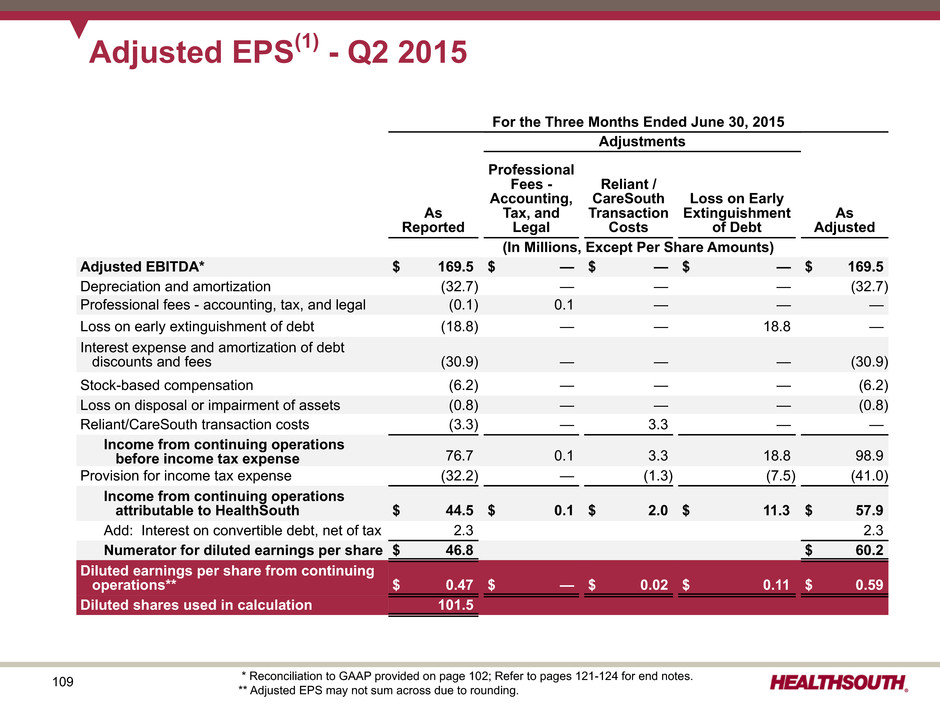
109 For the Three Months Ended June 30, 2015 Adjustments As Reported Professional Fees - Accounting, Tax, and Legal Reliant / CareSouth Transaction Costs Loss on Early Extinguishment of Debt As Adjusted (In Millions, Except Per Share Amounts) Adjusted EBITDA* $ 169.5 $ — $ — $ — $ 169.5 Depreciation and amortization (32.7) — — — (32.7) Professional fees - accounting, tax, and legal (0.1) 0.1 — — — Loss on early extinguishment of debt (18.8) — — 18.8 — Interest expense and amortization of debt discounts and fees (30.9) — — — (30.9) Stock-based compensation (6.2) — — — (6.2) Loss on disposal or impairment of assets (0.8) — — — (0.8) Reliant/CareSouth transaction costs (3.3) — 3.3 — — Income from continuing operations before income tax expense 76.7 0.1 3.3 18.8 98.9 Provision for income tax expense (32.2) — (1.3) (7.5) (41.0) Income from continuing operations attributable to HealthSouth $ 44.5 $ 0.1 $ 2.0 $ 11.3 $ 57.9 Add: Interest on convertible debt, net of tax 2.3 2.3 Numerator for diluted earnings per share $ 46.8 $ 60.2 Diluted earnings per share from continuing operations** $ 0.47 $ — $ 0.02 $ 0.11 $ 0.59 Diluted shares used in calculation 101.5 Adjusted EPS(1) - Q2 2015 * Reconciliation to GAAP provided on page 102; Refer to pages 121-124 for end notes. ** Adjusted EPS may not sum across due to rounding.
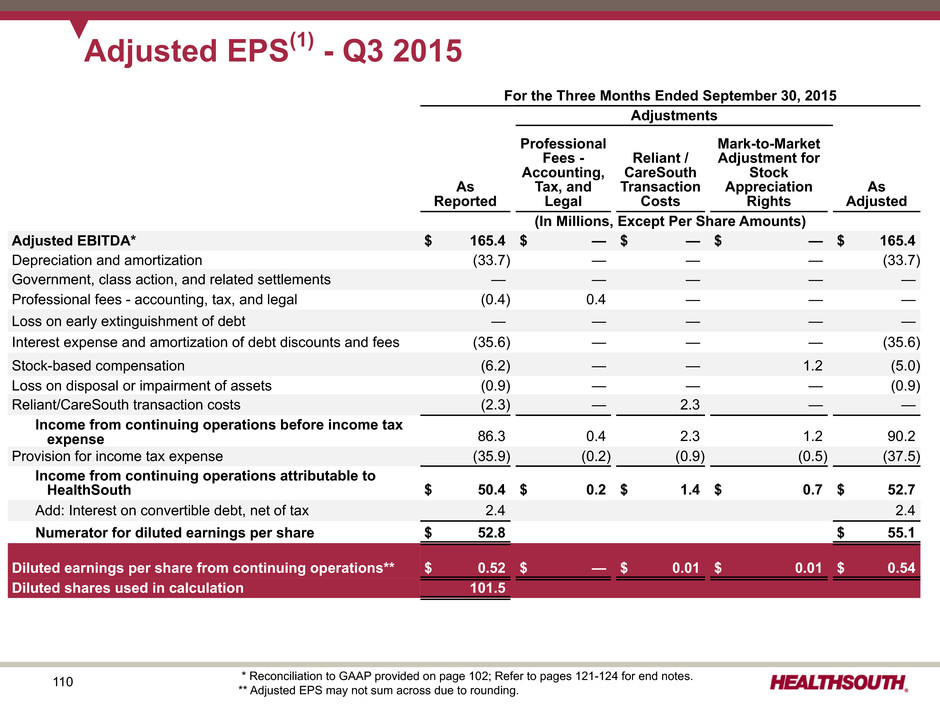
110 For the Three Months Ended September 30, 2015 Adjustments As Reported Professional Fees - Accounting, Tax, and Legal Reliant / CareSouth Transaction Costs Mark-to-Market Adjustment for Stock Appreciation Rights As Adjusted (In Millions, Except Per Share Amounts) Adjusted EBITDA* $ 165.4 $ — $ — $ — $ 165.4 Depreciation and amortization (33.7) — — — (33.7) Government, class action, and related settlements — — — — — Professional fees - accounting, tax, and legal (0.4) 0.4 — — — Loss on early extinguishment of debt — — — — — Interest expense and amortization of debt discounts and fees (35.6) — — — (35.6) Stock-based compensation (6.2) — — 1.2 (5.0) Loss on disposal or impairment of assets (0.9) — — — (0.9) Reliant/CareSouth transaction costs (2.3) — 2.3 — — Income from continuing operations before income tax expense 86.3 0.4 2.3 1.2 90.2 Provision for income tax expense (35.9) (0.2) (0.9) (0.5) (37.5) Income from continuing operations attributable to HealthSouth $ 50.4 $ 0.2 $ 1.4 $ 0.7 $ 52.7 Add: Interest on convertible debt, net of tax 2.4 2.4 Numerator for diluted earnings per share $ 52.8 $ 55.1 Diluted earnings per share from continuing operations** $ 0.52 $ — $ 0.01 $ 0.01 $ 0.54 Diluted shares used in calculation 101.5 Adjusted EPS(1) - Q3 2015 * Reconciliation to GAAP provided on page 102; Refer to pages 121-124 for end notes. ** Adjusted EPS may not sum across due to rounding.
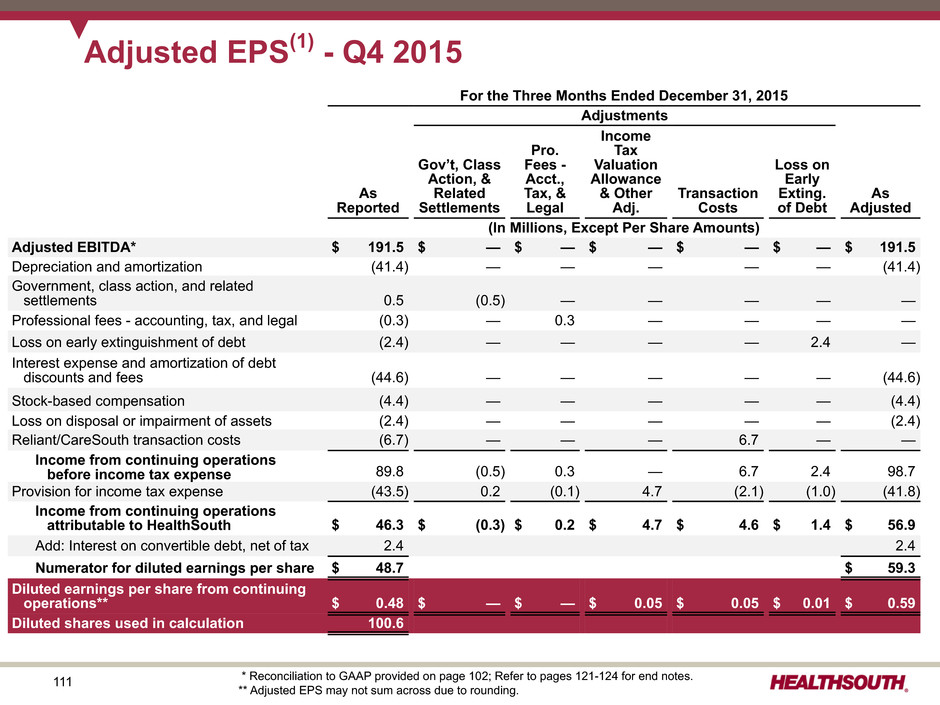
111 For the Three Months Ended December 31, 2015 Adjustments As Reported Gov’t, Class Action, & Related Settlements Pro. Fees - Acct., Tax, & Legal Income Tax Valuation Allowance & Other Adj. Transaction Costs Loss on Early Exting. of Debt As Adjusted (In Millions, Except Per Share Amounts) Adjusted EBITDA* $ 191.5 $ — $ — $ — $ — $ — $ 191.5 Depreciation and amortization (41.4) — — — — — (41.4) Government, class action, and related settlements 0.5 (0.5) — — — — — Professional fees - accounting, tax, and legal (0.3) — 0.3 — — — — Loss on early extinguishment of debt (2.4) — — — — 2.4 — Interest expense and amortization of debt discounts and fees (44.6) — — — — — (44.6) Stock-based compensation (4.4) — — — — — (4.4) Loss on disposal or impairment of assets (2.4) — — — — — (2.4) Reliant/CareSouth transaction costs (6.7) — — — 6.7 — — Income from continuing operations before income tax expense 89.8 (0.5) 0.3 — 6.7 2.4 98.7 Provision for income tax expense (43.5) 0.2 (0.1) 4.7 (2.1) (1.0) (41.8) Income from continuing operations attributable to HealthSouth $ 46.3 $ (0.3) $ 0.2 $ 4.7 $ 4.6 $ 1.4 $ 56.9 Add: Interest on convertible debt, net of tax 2.4 2.4 Numerator for diluted earnings per share $ 48.7 $ 59.3 Diluted earnings per share from continuing operations** $ 0.48 $ — $ — $ 0.05 $ 0.05 $ 0.01 $ 0.59 Diluted shares used in calculation 100.6 Adjusted EPS(1) - Q4 2015 * Reconciliation to GAAP provided on page 102; Refer to pages 121-124 for end notes. ** Adjusted EPS may not sum across due to rounding.
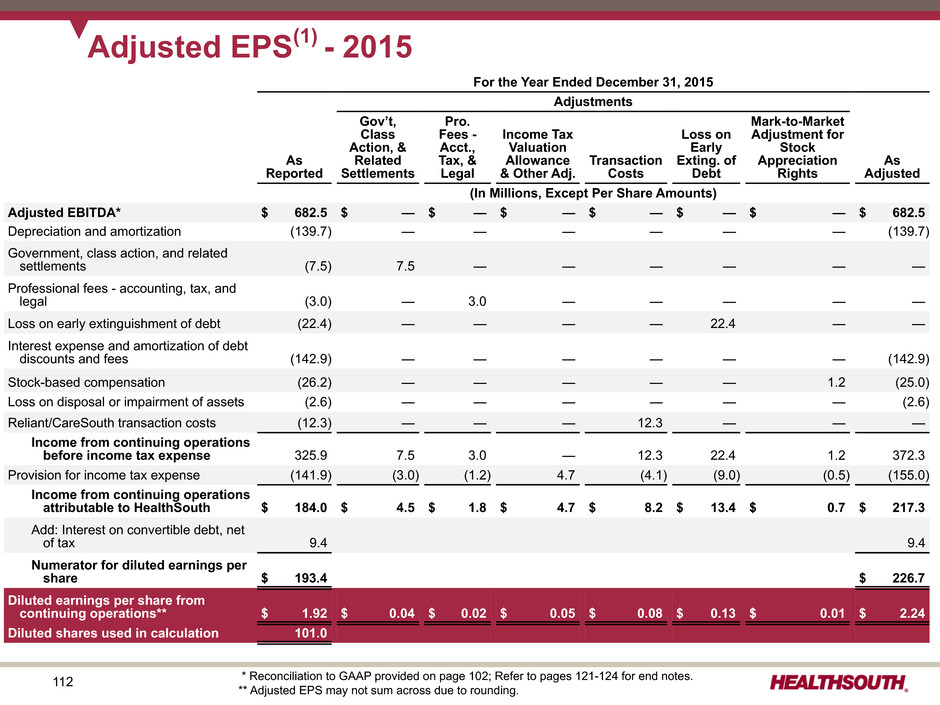
112 Adjusted EPS(1) - 2015 For the Year Ended December 31, 2015 Adjustments As Reported Gov’t, Class Action, & Related Settlements Pro. Fees - Acct., Tax, & Legal Income Tax Valuation Allowance & Other Adj. Transaction Costs Loss on Early Exting. of Debt Mark-to-Market Adjustment for Stock Appreciation Rights As Adjusted (In Millions, Except Per Share Amounts) Adjusted EBITDA* $ 682.5 $ — $ — $ — $ — $ — $ — $ 682.5 Depreciation and amortization (139.7) — — — — — — (139.7) Government, class action, and related settlements (7.5) 7.5 — — — — — — Professional fees - accounting, tax, and legal (3.0) — 3.0 — — — — — Loss on early extinguishment of debt (22.4) — — — — 22.4 — — Interest expense and amortization of debt discounts and fees (142.9) — — — — — — (142.9) Stock-based compensation (26.2) — — — — — 1.2 (25.0) Loss on disposal or impairment of assets (2.6) — — — — — — (2.6) Reliant/CareSouth transaction costs (12.3) — — — 12.3 — — — Income from continuing operations before income tax expense 325.9 7.5 3.0 — 12.3 22.4 1.2 372.3 Provision for income tax expense (141.9) (3.0) (1.2) 4.7 (4.1) (9.0) (0.5) (155.0) Income from continuing operations attributable to HealthSouth $ 184.0 $ 4.5 $ 1.8 $ 4.7 $ 8.2 $ 13.4 $ 0.7 $ 217.3 Add: Interest on convertible debt, net of tax 9.4 9.4 Numerator for diluted earnings per share $ 193.4 $ 226.7 Diluted earnings per share from continuing operations** $ 1.92 $ 0.04 $ 0.02 $ 0.05 $ 0.08 $ 0.13 $ 0.01 $ 2.24 Diluted shares used in calculation 101.0 * Reconciliation to GAAP provided on page 102; Refer to pages 121-124 for end notes. ** Adjusted EPS may not sum across due to rounding.
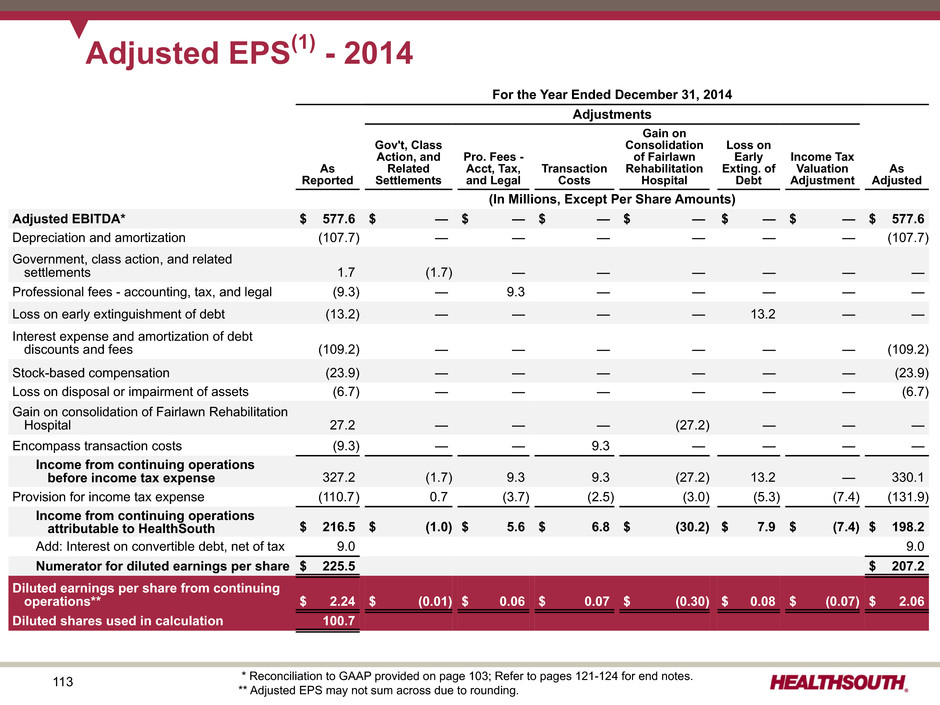
113 For the Year Ended December 31, 2014 Adjustments As Reported Gov't, Class Action, and Related Settlements Pro. Fees - Acct, Tax, and Legal Transaction Costs Gain on Consolidation of Fairlawn Rehabilitation Hospital Loss on Early Exting. of Debt Income Tax Valuation Adjustment As Adjusted (In Millions, Except Per Share Amounts) Adjusted EBITDA* $ 577.6 $ — $ — $ — $ — $ — $ — $ 577.6 Depreciation and amortization (107.7) — — — — — — (107.7) Government, class action, and related settlements 1.7 (1.7) — — — — — — Professional fees - accounting, tax, and legal (9.3) — 9.3 — — — — — Loss on early extinguishment of debt (13.2) — — — — 13.2 — — Interest expense and amortization of debt discounts and fees (109.2) — — — — — — (109.2) Stock-based compensation (23.9) — — — — — — (23.9) Loss on disposal or impairment of assets (6.7) — — — — — — (6.7) Gain on consolidation of Fairlawn Rehabilitation Hospital 27.2 — — — (27.2) — — — Encompass transaction costs (9.3) — — 9.3 — — — — Income from continuing operations before income tax expense 327.2 (1.7) 9.3 9.3 (27.2) 13.2 — 330.1 Provision for income tax expense (110.7) 0.7 (3.7) (2.5) (3.0) (5.3) (7.4) (131.9) Income from continuing operations attributable to HealthSouth $ 216.5 $ (1.0) $ 5.6 $ 6.8 $ (30.2) $ 7.9 $ (7.4) $ 198.2 Add: Interest on convertible debt, net of tax 9.0 9.0 Numerator for diluted earnings per share $ 225.5 $ 207.2 Diluted earnings per share from continuing operations** $ 2.24 $ (0.01) $ 0.06 $ 0.07 $ (0.30) $ 0.08 $ (0.07) $ 2.06 Diluted shares used in calculation 100.7 Adjusted EPS(1) - 2014 * Reconciliation to GAAP provided on page 103; Refer to pages 121-124 for end notes. ** Adjusted EPS may not sum across due to rounding.
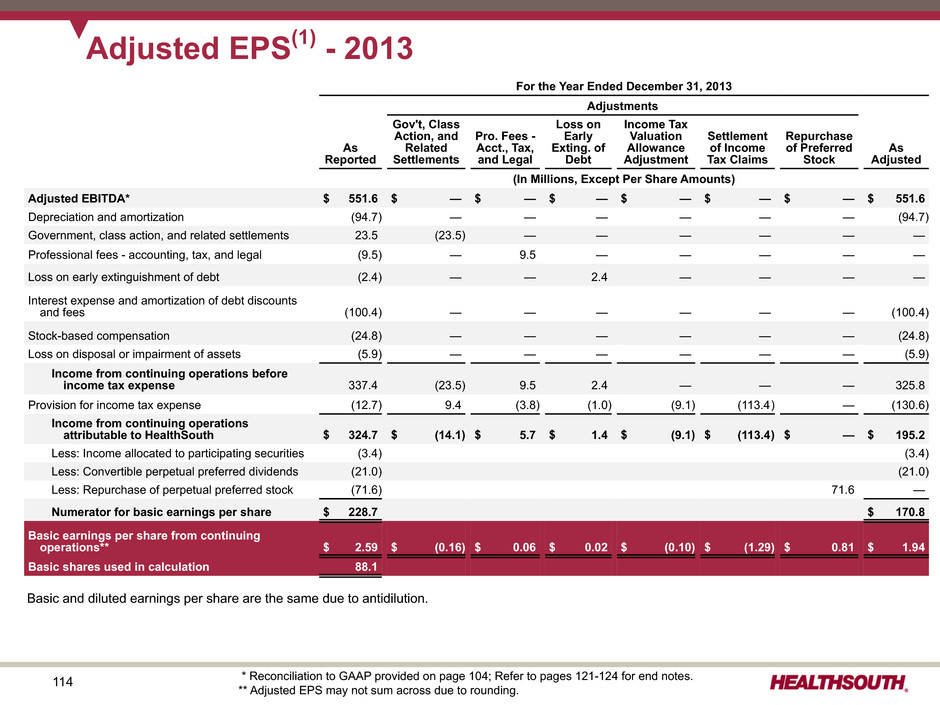
114 For the Year Ended December 31, 2013 Adjustments As Reported Gov't, Class Action, and Related Settlements Pro. Fees - Acct., Tax, and Legal Loss on Early Exting. of Debt Income Tax Valuation Allowance Adjustment Settlement of Income Tax Claims Repurchase of Preferred Stock As Adjusted (In Millions, Except Per Share Amounts) Adjusted EBITDA* $ 551.6 $ — $ — $ — $ — $ — $ — $ 551.6 Depreciation and amortization (94.7) — — — — — — (94.7) Government, class action, and related settlements 23.5 (23.5) — — — — — — Professional fees - accounting, tax, and legal (9.5) — 9.5 — — — — — Loss on early extinguishment of debt (2.4) — — 2.4 — — — — Interest expense and amortization of debt discounts and fees (100.4) — — — — — — (100.4) Stock-based compensation (24.8) — — — — — — (24.8) Loss on disposal or impairment of assets (5.9) — — — — — — (5.9) Income from continuing operations before income tax expense 337.4 (23.5) 9.5 2.4 — — — 325.8 Provision for income tax expense (12.7) 9.4 (3.8) (1.0) (9.1) (113.4) — (130.6) Income from continuing operations attributable to HealthSouth $ 324.7 $ (14.1) $ 5.7 $ 1.4 $ (9.1) $ (113.4) $ — $ 195.2 Less: Income allocated to participating securities (3.4) (3.4) Less: Convertible perpetual preferred dividends (21.0) (21.0) Less: Repurchase of perpetual preferred stock (71.6) 71.6 — Numerator for basic earnings per share $ 228.7 $ 170.8 Basic earnings per share from continuing operations** $ 2.59 $ (0.16) $ 0.06 $ 0.02 $ (0.10) $ (1.29) $ 0.81 $ 1.94 Basic shares used in calculation 88.1 Adjusted EPS(1) - 2013 Basic and diluted earnings per share are the same due to antidilution. * Reconciliation to GAAP provided on page 104; Refer to pages 121-124 for end notes. ** Adjusted EPS may not sum across due to rounding.
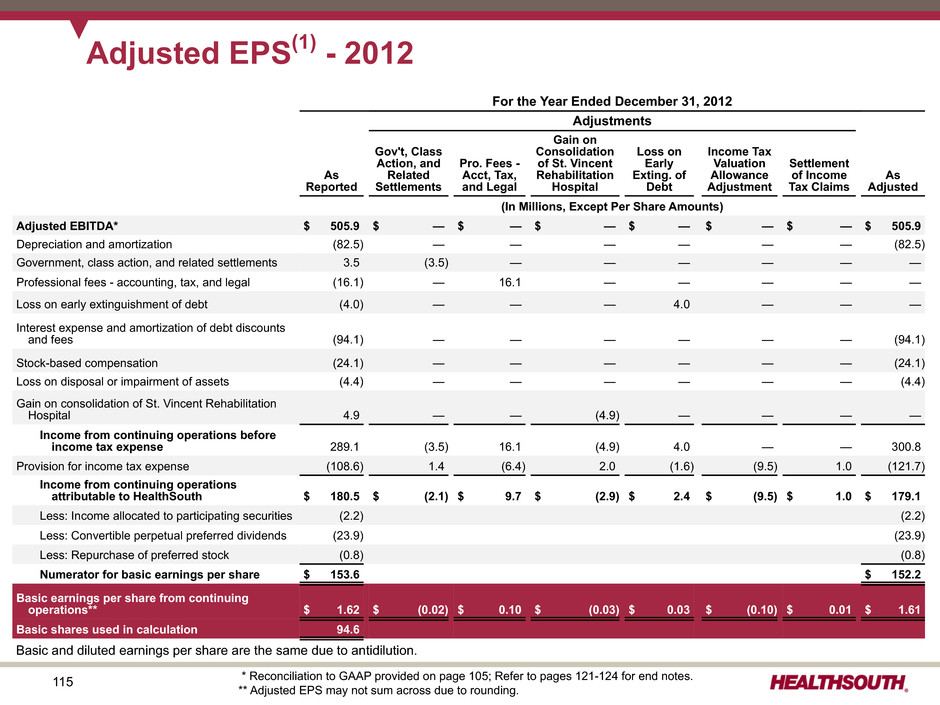
115 For the Year Ended December 31, 2012 Adjustments As Reported Gov't, Class Action, and Related Settlements Pro. Fees - Acct, Tax, and Legal Gain on Consolidation of St. Vincent Rehabilitation Hospital Loss on Early Exting. of Debt Income Tax Valuation Allowance Adjustment Settlement of Income Tax Claims As Adjusted (In Millions, Except Per Share Amounts) Adjusted EBITDA* $ 505.9 $ — $ — $ — $ — $ — $ — $ 505.9 Depreciation and amortization (82.5) — — — — — — (82.5) Government, class action, and related settlements 3.5 (3.5) — — — — — — Professional fees - accounting, tax, and legal (16.1) — 16.1 — — — — — Loss on early extinguishment of debt (4.0) — — — 4.0 — — — Interest expense and amortization of debt discounts and fees (94.1) — — — — — — (94.1) Stock-based compensation (24.1) — — — — — — (24.1) Loss on disposal or impairment of assets (4.4) — — — — — — (4.4) Gain on consolidation of St. Vincent Rehabilitation Hospital 4.9 — — (4.9) — — — — Income from continuing operations before income tax expense 289.1 (3.5) 16.1 (4.9) 4.0 — — 300.8 Provision for income tax expense (108.6) 1.4 (6.4) 2.0 (1.6) (9.5) 1.0 (121.7) Income from continuing operations attributable to HealthSouth $ 180.5 $ (2.1) $ 9.7 $ (2.9) $ 2.4 $ (9.5) $ 1.0 $ 179.1 Less: Income allocated to participating securities (2.2) (2.2) Less: Convertible perpetual preferred dividends (23.9) (23.9) Less: Repurchase of preferred stock (0.8) (0.8) Numerator for basic earnings per share $ 153.6 $ 152.2 Basic earnings per share from continuing operations** $ 1.62 $ (0.02) $ 0.10 $ (0.03) $ 0.03 $ (0.10) $ 0.01 $ 1.61 Basic shares used in calculation 94.6 Adjusted EPS(1) - 2012 Basic and diluted earnings per share are the same due to antidilution. * Reconciliation to GAAP provided on page 105; Refer to pages 121-124 for end notes. ** Adjusted EPS may not sum across due to rounding.
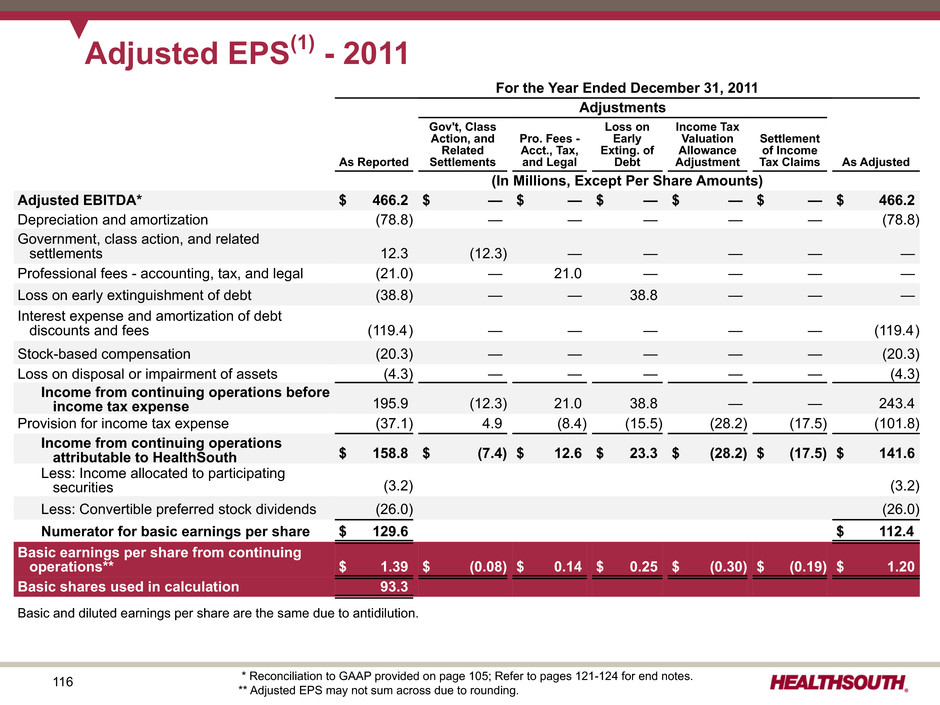
116 For the Year Ended December 31, 2011 Adjustments As Reported Gov't, Class Action, and Related Settlements Pro. Fees - Acct., Tax, and Legal Loss on Early Exting. of Debt Income Tax Valuation Allowance Adjustment Settlement of Income Tax Claims As Adjusted (In Millions, Except Per Share Amounts) Adjusted EBITDA* $ 466.2 $ — $ — $ — $ — $ — $ 466.2 Depreciation and amortization (78.8) — — — — — (78.8) Government, class action, and related settlements 12.3 (12.3) — — — — — Professional fees - accounting, tax, and legal (21.0) — 21.0 — — — — Loss on early extinguishment of debt (38.8) — — 38.8 — — — Interest expense and amortization of debt discounts and fees (119.4) — — — — — (119.4) Stock-based compensation (20.3) — — — — — (20.3) Loss on disposal or impairment of assets (4.3) — — — — — (4.3) Income from continuing operations before income tax expense 195.9 (12.3) 21.0 38.8 — — 243.4 Provision for income tax expense (37.1) 4.9 (8.4) (15.5) (28.2) (17.5) (101.8) Income from continuing operations attributable to HealthSouth $ 158.8 $ (7.4) $ 12.6 $ 23.3 $ (28.2) $ (17.5) $ 141.6 Less: Income allocated to participating securities (3.2) (3.2) Less: Convertible preferred stock dividends (26.0) (26.0) Numerator for basic earnings per share $ 129.6 $ 112.4 Basic earnings per share from continuing operations** $ 1.39 $ (0.08) $ 0.14 $ 0.25 $ (0.30) $ (0.19) $ 1.20 Basic shares used in calculation 93.3 Adjusted EPS(1) - 2011 Basic and diluted earnings per share are the same due to antidilution. * Reconciliation to GAAP provided on page 105; Refer to pages 121-124 for end notes. ** Adjusted EPS may not sum across due to rounding.
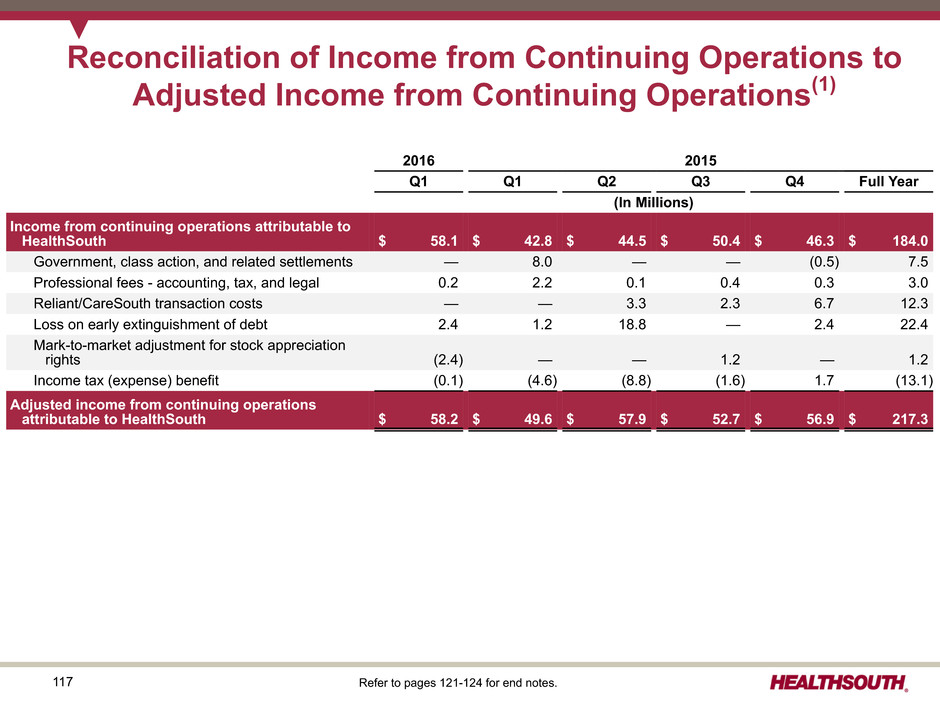
117 2016 2015 Q1 Q1 Q2 Q3 Q4 Full Year (In Millions) Income from continuing operations attributable to HealthSouth $ 58.1 $ 42.8 $ 44.5 $ 50.4 $ 46.3 $ 184.0 Government, class action, and related settlements — 8.0 — — (0.5) 7.5 Professional fees - accounting, tax, and legal 0.2 2.2 0.1 0.4 0.3 3.0 Reliant/CareSouth transaction costs — — 3.3 2.3 6.7 12.3 Loss on early extinguishment of debt 2.4 1.2 18.8 — 2.4 22.4 Mark-to-market adjustment for stock appreciation rights (2.4) — — 1.2 — 1.2 Income tax (expense) benefit (0.1) (4.6) (8.8) (1.6) 1.7 (13.1) Adjusted income from continuing operations attributable to HealthSouth $ 58.2 $ 49.6 $ 57.9 $ 52.7 $ 56.9 $ 217.3 Reconciliation of Income from Continuing Operations to Adjusted Income from Continuing Operations(1) Refer to pages 121-124 for end notes.
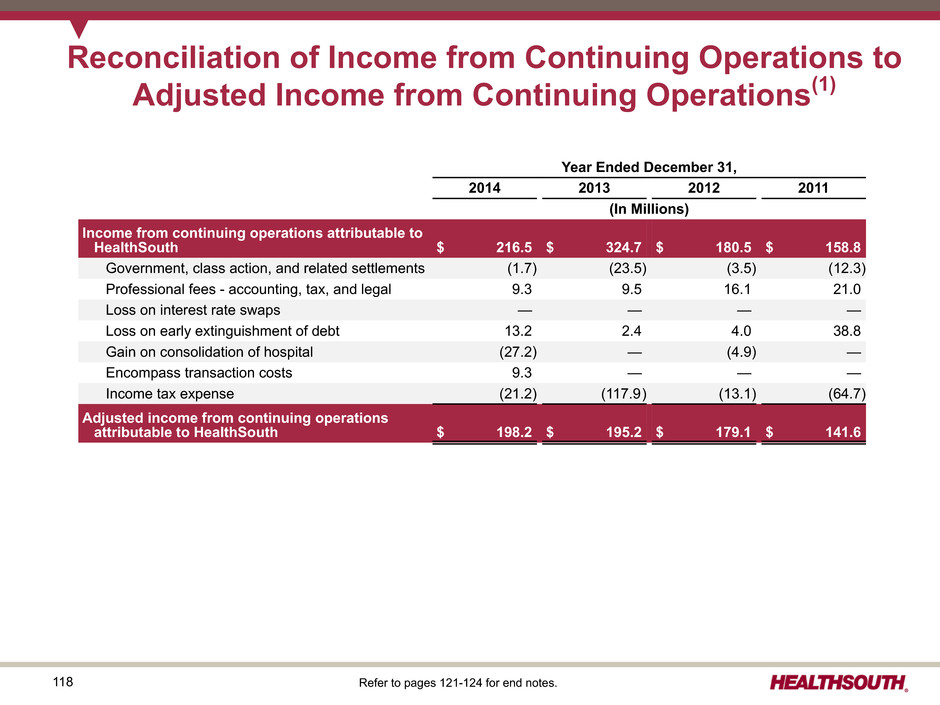
118 Year Ended December 31, 2014 2013 2012 2011 (In Millions) Income from continuing operations attributable to HealthSouth $ 216.5 $ 324.7 $ 180.5 $ 158.8 Government, class action, and related settlements (1.7) (23.5) (3.5) (12.3) Professional fees - accounting, tax, and legal 9.3 9.5 16.1 21.0 Loss on interest rate swaps — — — — Loss on early extinguishment of debt 13.2 2.4 4.0 38.8 Gain on consolidation of hospital (27.2) — (4.9) — Encompass transaction costs 9.3 — — — Income tax expense (21.2) (117.9) (13.1) (64.7) Adjusted income from continuing operations attributable to HealthSouth $ 198.2 $ 195.2 $ 179.1 $ 141.6 Reconciliation of Income from Continuing Operations to Adjusted Income from Continuing Operations(1) Refer to pages 121-124 for end notes.
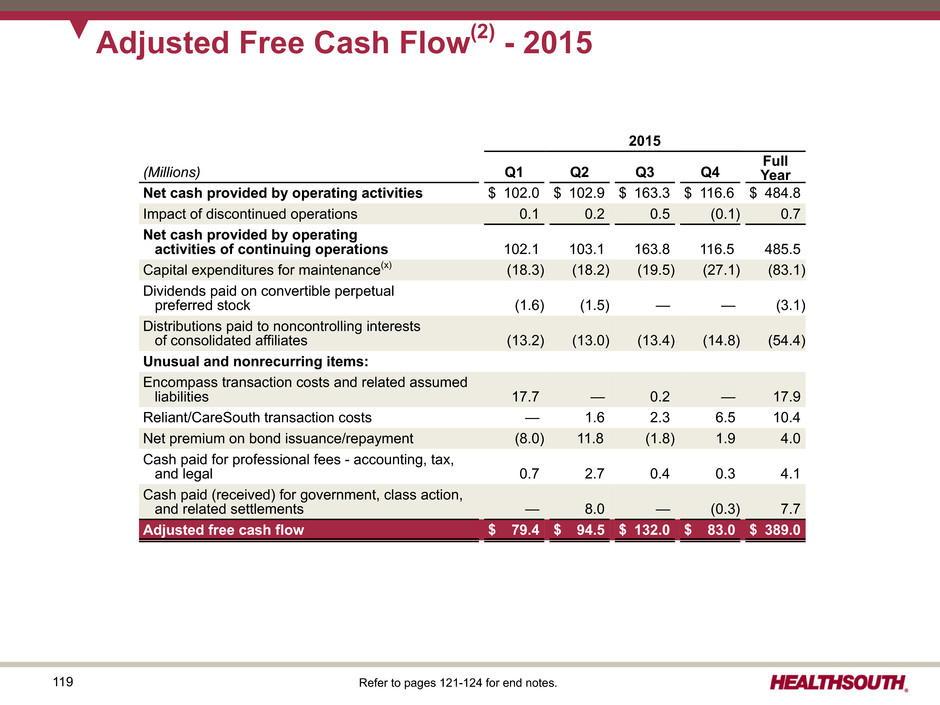
119 Adjusted Free Cash Flow(2) - 2015 2015 (Millions) Q1 Q2 Q3 Q4 Full Year Net cash provided by operating activities $ 102.0 $ 102.9 $ 163.3 $ 116.6 $ 484.8 Impact of discontinued operations 0.1 0.2 0.5 (0.1) 0.7 Net cash provided by operating activities of continuing operations 102.1 103.1 163.8 116.5 485.5 Capital expenditures for maintenance(x) (18.3) (18.2) (19.5) (27.1) (83.1) Dividends paid on convertible perpetual preferred stock (1.6) (1.5) — — (3.1) Distributions paid to noncontrolling interests of consolidated affiliates (13.2) (13.0) (13.4) (14.8) (54.4) Unusual and nonrecurring items: Encompass transaction costs and related assumed liabilities 17.7 — 0.2 — 17.9 Reliant/CareSouth transaction costs — 1.6 2.3 6.5 10.4 Net premium on bond issuance/repayment (8.0) 11.8 (1.8) 1.9 4.0 Cash paid for professional fees - accounting, tax, and legal 0.7 2.7 0.4 0.3 4.1 Cash paid (received) for government, class action, and related settlements — 8.0 — (0.3) 7.7 Adjusted free cash flow $ 79.4 $ 94.5 $ 132.0 $ 83.0 $ 389.0 Refer to pages 121-124 for end notes.
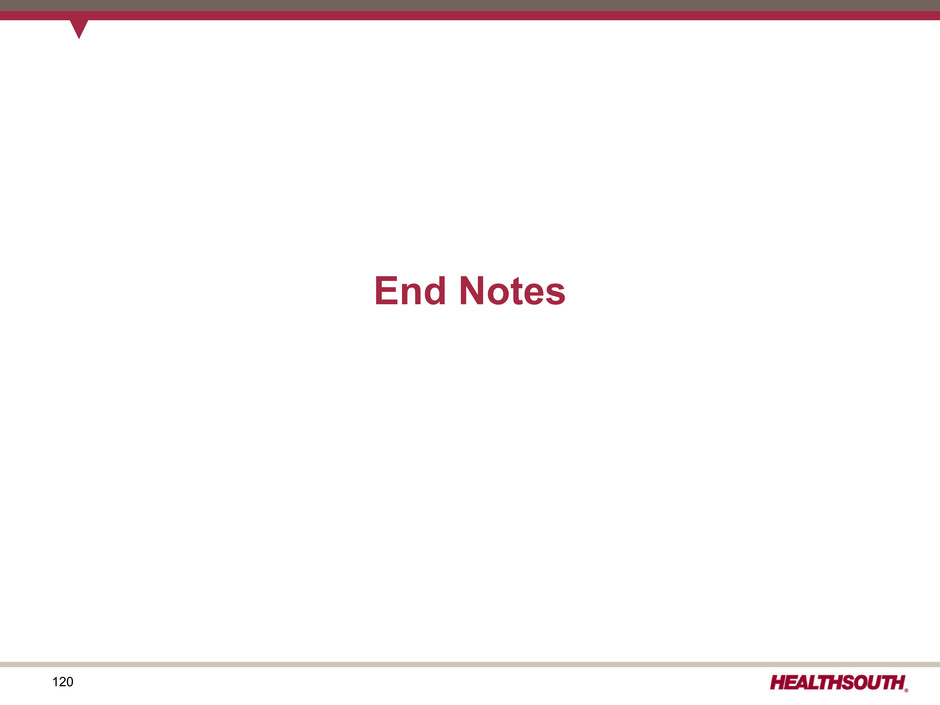
120 End Notes
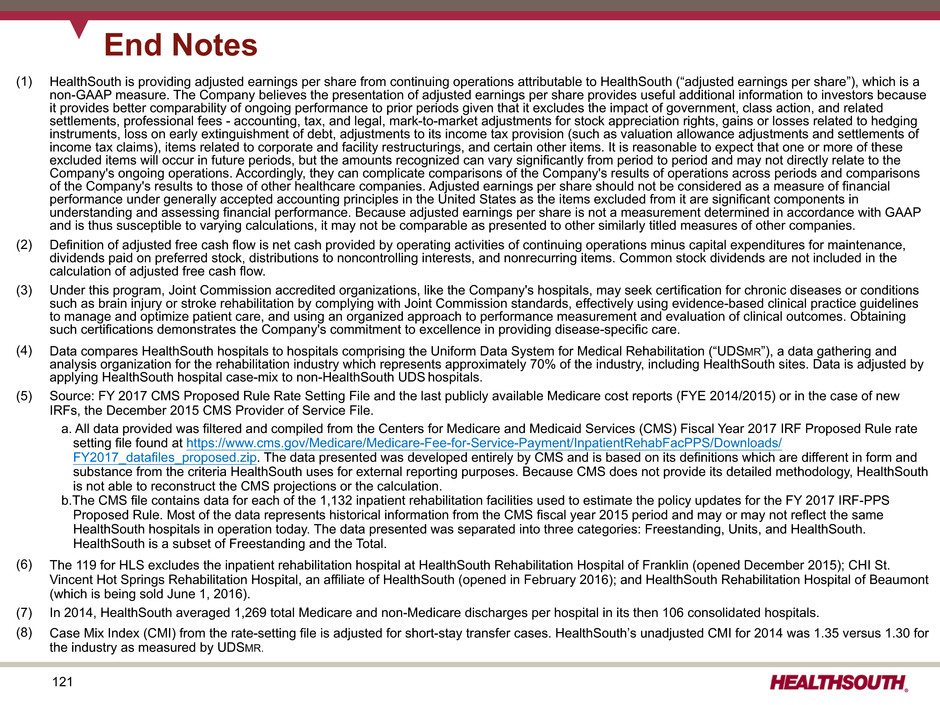
121 End Notes (1) HealthSouth is providing adjusted earnings per share from continuing operations attributable to HealthSouth (“adjusted earnings per share”), which is a non-GAAP measure. The Company believes the presentation of adjusted earnings per share provides useful additional information to investors because it provides better comparability of ongoing performance to prior periods given that it excludes the impact of government, class action, and related settlements, professional fees - accounting, tax, and legal, mark-to-market adjustments for stock appreciation rights, gains or losses related to hedging instruments, loss on early extinguishment of debt, adjustments to its income tax provision (such as valuation allowance adjustments and settlements of income tax claims), items related to corporate and facility restructurings, and certain other items. It is reasonable to expect that one or more of these excluded items will occur in future periods, but the amounts recognized can vary significantly from period to period and may not directly relate to the Company's ongoing operations. Accordingly, they can complicate comparisons of the Company's results of operations across periods and comparisons of the Company's results to those of other healthcare companies. Adjusted earnings per share should not be considered as a measure of financial performance under generally accepted accounting principles in the United States as the items excluded from it are significant components in understanding and assessing financial performance. Because adjusted earnings per share is not a measurement determined in accordance with GAAP and is thus susceptible to varying calculations, it may not be comparable as presented to other similarly titled measures of other companies. (2) Definition of adjusted free cash flow is net cash provided by operating activities of continuing operations minus capital expenditures for maintenance, dividends paid on preferred stock, distributions to noncontrolling interests, and nonrecurring items. Common stock dividends are not included in the calculation of adjusted free cash flow. (3) Under this program, Joint Commission accredited organizations, like the Company's hospitals, may seek certification for chronic diseases or conditions such as brain injury or stroke rehabilitation by complying with Joint Commission standards, effectively using evidence-based clinical practice guidelines to manage and optimize patient care, and using an organized approach to performance measurement and evaluation of clinical outcomes. Obtaining such certifications demonstrates the Company's commitment to excellence in providing disease-specific care. (4) Data compares HealthSouth hospitals to hospitals comprising the Uniform Data System for Medical Rehabilitation (“UDSMR”), a data gathering and analysis organization for the rehabilitation industry which represents approximately 70% of the industry, including HealthSouth sites. Data is adjusted by applying HealthSouth hospital case-mix to non-HealthSouth UDS hospitals. (5) Source: FY 2017 CMS Proposed Rule Rate Setting File and the last publicly available Medicare cost reports (FYE 2014/2015) or in the case of new IRFs, the December 2015 CMS Provider of Service File. a. All data provided was filtered and compiled from the Centers for Medicare and Medicaid Services (CMS) Fiscal Year 2017 IRF Proposed Rule rate setting file found at https://www.cms.gov/Medicare/Medicare-Fee-for-Service-Payment/InpatientRehabFacPPS/Downloads/ FY2017_datafiles_proposed.zip. The data presented was developed entirely by CMS and is based on its definitions which are different in form and substance from the criteria HealthSouth uses for external reporting purposes. Because CMS does not provide its detailed methodology, HealthSouth is not able to reconstruct the CMS projections or the calculation. b.The CMS file contains data for each of the 1,132 inpatient rehabilitation facilities used to estimate the policy updates for the FY 2017 IRF-PPS Proposed Rule. Most of the data represents historical information from the CMS fiscal year 2015 period and may or may not reflect the same HealthSouth hospitals in operation today. The data presented was separated into three categories: Freestanding, Units, and HealthSouth. HealthSouth is a subset of Freestanding and the Total. (6) The 119 for HLS excludes the inpatient rehabilitation hospital at HealthSouth Rehabilitation Hospital of Franklin (opened December 2015); CHI St. Vincent Hot Springs Rehabilitation Hospital, an affiliate of HealthSouth (opened in February 2016); and HealthSouth Rehabilitation Hospital of Beaumont (which is being sold June 1, 2016). (7) In 2014, HealthSouth averaged 1,269 total Medicare and non-Medicare discharges per hospital in its then 106 consolidated hospitals. (8) Case Mix Index (CMI) from the rate-setting file is adjusted for short-stay transfer cases. HealthSouth’s unadjusted CMI for 2014 was 1.35 versus 1.30 for the industry as measured by UDSMR.
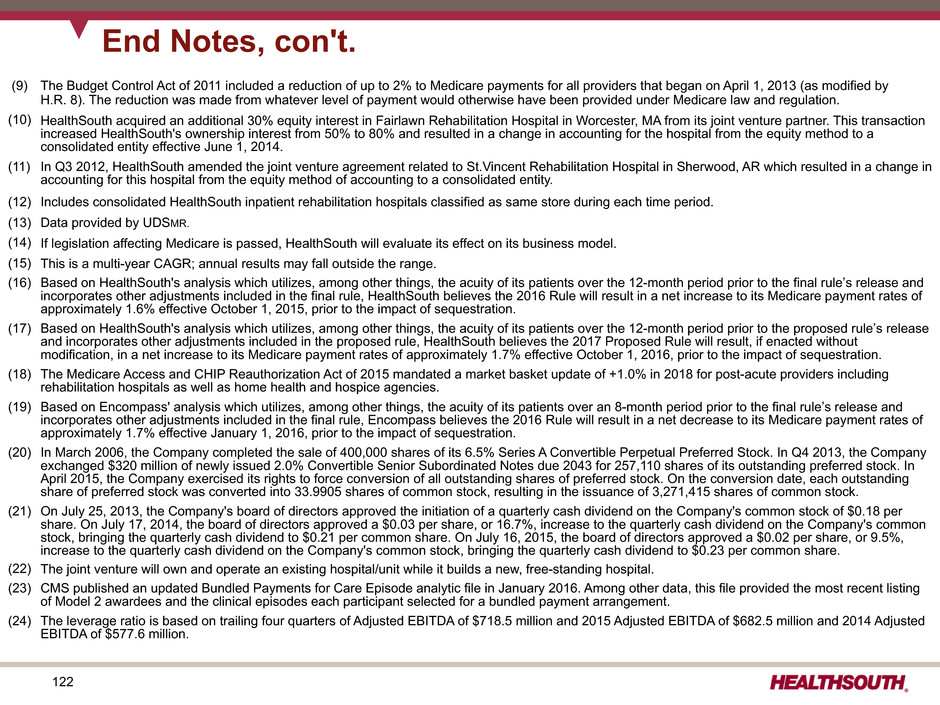
122 End Notes, con't. (9) The Budget Control Act of 2011 included a reduction of up to 2% to Medicare payments for all providers that began on April 1, 2013 (as modified by H.R. 8). The reduction was made from whatever level of payment would otherwise have been provided under Medicare law and regulation. (10) HealthSouth acquired an additional 30% equity interest in Fairlawn Rehabilitation Hospital in Worcester, MA from its joint venture partner. This transaction increased HealthSouth's ownership interest from 50% to 80% and resulted in a change in accounting for the hospital from the equity method to a consolidated entity effective June 1, 2014. (11) In Q3 2012, HealthSouth amended the joint venture agreement related to St.Vincent Rehabilitation Hospital in Sherwood, AR which resulted in a change in accounting for this hospital from the equity method of accounting to a consolidated entity. (12) Includes consolidated HealthSouth inpatient rehabilitation hospitals classified as same store during each time period. (13) Data provided by UDSMR. (14) If legislation affecting Medicare is passed, HealthSouth will evaluate its effect on its business model. (15) This is a multi-year CAGR; annual results may fall outside the range. (16) Based on HealthSouth's analysis which utilizes, among other things, the acuity of its patients over the 12-month period prior to the final rule’s release and incorporates other adjustments included in the final rule, HealthSouth believes the 2016 Rule will result in a net increase to its Medicare payment rates of approximately 1.6% effective October 1, 2015, prior to the impact of sequestration. (17) Based on HealthSouth's analysis which utilizes, among other things, the acuity of its patients over the 12-month period prior to the proposed rule’s release and incorporates other adjustments included in the proposed rule, HealthSouth believes the 2017 Proposed Rule will result, if enacted without modification, in a net increase to its Medicare payment rates of approximately 1.7% effective October 1, 2016, prior to the impact of sequestration. (18) The Medicare Access and CHIP Reauthorization Act of 2015 mandated a market basket update of +1.0% in 2018 for post-acute providers including rehabilitation hospitals as well as home health and hospice agencies. (19) Based on Encompass' analysis which utilizes, among other things, the acuity of its patients over an 8-month period prior to the final rule’s release and incorporates other adjustments included in the final rule, Encompass believes the 2016 Rule will result in a net decrease to its Medicare payment rates of approximately 1.7% effective January 1, 2016, prior to the impact of sequestration. (20) In March 2006, the Company completed the sale of 400,000 shares of its 6.5% Series A Convertible Perpetual Preferred Stock. In Q4 2013, the Company exchanged $320 million of newly issued 2.0% Convertible Senior Subordinated Notes due 2043 for 257,110 shares of its outstanding preferred stock. In April 2015, the Company exercised its rights to force conversion of all outstanding shares of preferred stock. On the conversion date, each outstanding share of preferred stock was converted into 33.9905 shares of common stock, resulting in the issuance of 3,271,415 shares of common stock. (21) On July 25, 2013, the Company's board of directors approved the initiation of a quarterly cash dividend on the Company's common stock of $0.18 per share. On July 17, 2014, the board of directors approved a $0.03 per share, or 16.7%, increase to the quarterly cash dividend on the Company's common stock, bringing the quarterly cash dividend to $0.21 per common share. On July 16, 2015, the board of directors approved a $0.02 per share, or 9.5%, increase to the quarterly cash dividend on the Company's common stock, bringing the quarterly cash dividend to $0.23 per common share. (22) The joint venture will own and operate an existing hospital/unit while it builds a new, free-standing hospital. (23) CMS published an updated Bundled Payments for Care Episode analytic file in January 2016. Among other data, this file provided the most recent listing of Model 2 awardees and the clinical episodes each participant selected for a bundled payment arrangement. (24) The leverage ratio is based on trailing four quarters of Adjusted EBITDA of $718.5 million and 2015 Adjusted EBITDA of $682.5 million and 2014 Adjusted EBITDA of $577.6 million.
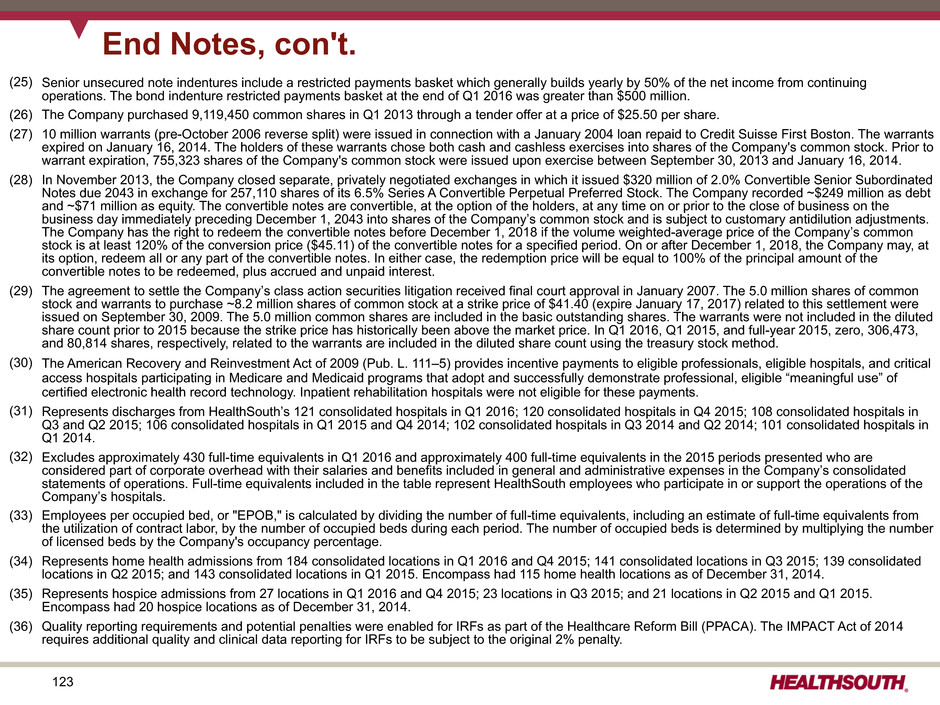
123 End Notes, con't. (25) Senior unsecured note indentures include a restricted payments basket which generally builds yearly by 50% of the net income from continuing operations. The bond indenture restricted payments basket at the end of Q1 2016 was greater than $500 million. (26) The Company purchased 9,119,450 common shares in Q1 2013 through a tender offer at a price of $25.50 per share. (27) 10 million warrants (pre-October 2006 reverse split) were issued in connection with a January 2004 loan repaid to Credit Suisse First Boston. The warrants expired on January 16, 2014. The holders of these warrants chose both cash and cashless exercises into shares of the Company's common stock. Prior to warrant expiration, 755,323 shares of the Company's common stock were issued upon exercise between September 30, 2013 and January 16, 2014. (28) In November 2013, the Company closed separate, privately negotiated exchanges in which it issued $320 million of 2.0% Convertible Senior Subordinated Notes due 2043 in exchange for 257,110 shares of its 6.5% Series A Convertible Perpetual Preferred Stock. The Company recorded ~$249 million as debt and ~$71 million as equity. The convertible notes are convertible, at the option of the holders, at any time on or prior to the close of business on the business day immediately preceding December 1, 2043 into shares of the Company’s common stock and is subject to customary antidilution adjustments. The Company has the right to redeem the convertible notes before December 1, 2018 if the volume weighted-average price of the Company’s common stock is at least 120% of the conversion price ($45.11) of the convertible notes for a specified period. On or after December 1, 2018, the Company may, at its option, redeem all or any part of the convertible notes. In either case, the redemption price will be equal to 100% of the principal amount of the convertible notes to be redeemed, plus accrued and unpaid interest. (29) The agreement to settle the Company’s class action securities litigation received final court approval in January 2007. The 5.0 million shares of common stock and warrants to purchase ~8.2 million shares of common stock at a strike price of $41.40 (expire January 17, 2017) related to this settlement were issued on September 30, 2009. The 5.0 million common shares are included in the basic outstanding shares. The warrants were not included in the diluted share count prior to 2015 because the strike price has historically been above the market price. In Q1 2016, Q1 2015, and full-year 2015, zero, 306,473, and 80,814 shares, respectively, related to the warrants are included in the diluted share count using the treasury stock method. (30) The American Recovery and Reinvestment Act of 2009 (Pub. L. 111–5) provides incentive payments to eligible professionals, eligible hospitals, and critical access hospitals participating in Medicare and Medicaid programs that adopt and successfully demonstrate professional, eligible “meaningful use” of certified electronic health record technology. Inpatient rehabilitation hospitals were not eligible for these payments. (31) Represents discharges from HealthSouth’s 121 consolidated hospitals in Q1 2016; 120 consolidated hospitals in Q4 2015; 108 consolidated hospitals in Q3 and Q2 2015; 106 consolidated hospitals in Q1 2015 and Q4 2014; 102 consolidated hospitals in Q3 2014 and Q2 2014; 101 consolidated hospitals in Q1 2014. (32) Excludes approximately 430 full-time equivalents in Q1 2016 and approximately 400 full-time equivalents in the 2015 periods presented who are considered part of corporate overhead with their salaries and benefits included in general and administrative expenses in the Company’s consolidated statements of operations. Full-time equivalents included in the table represent HealthSouth employees who participate in or support the operations of the Company’s hospitals. (33) Employees per occupied bed, or "EPOB," is calculated by dividing the number of full-time equivalents, including an estimate of full-time equivalents from the utilization of contract labor, by the number of occupied beds during each period. The number of occupied beds is determined by multiplying the number of licensed beds by the Company's occupancy percentage. (34) Represents home health admissions from 184 consolidated locations in Q1 2016 and Q4 2015; 141 consolidated locations in Q3 2015; 139 consolidated locations in Q2 2015; and 143 consolidated locations in Q1 2015. Encompass had 115 home health locations as of December 31, 2014. (35) Represents hospice admissions from 27 locations in Q1 2016 and Q4 2015; 23 locations in Q3 2015; and 21 locations in Q2 2015 and Q1 2015. Encompass had 20 hospice locations as of December 31, 2014. (36) Quality reporting requirements and potential penalties were enabled for IRFs as part of the Healthcare Reform Bill (PPACA). The IMPACT Act of 2014 requires additional quality and clinical data reporting for IRFs to be subject to the original 2% penalty.
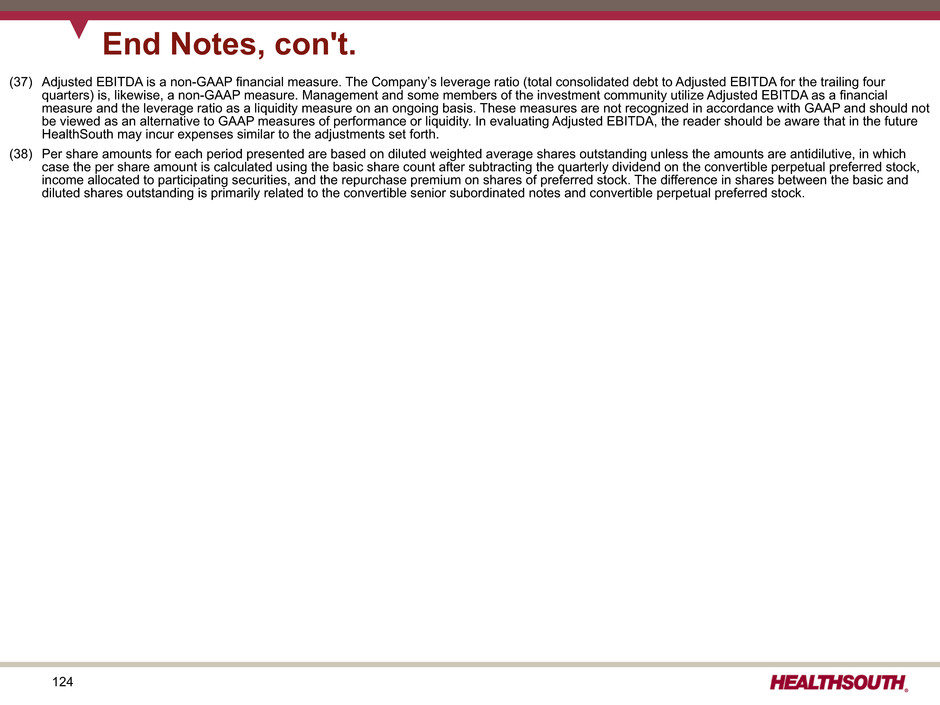
124 End Notes, con't. (37) Adjusted EBITDA is a non-GAAP financial measure. The Company’s leverage ratio (total consolidated debt to Adjusted EBITDA for the trailing four quarters) is, likewise, a non-GAAP measure. Management and some members of the investment community utilize Adjusted EBITDA as a financial measure and the leverage ratio as a liquidity measure on an ongoing basis. These measures are not recognized in accordance with GAAP and should not be viewed as an alternative to GAAP measures of performance or liquidity. In evaluating Adjusted EBITDA, the reader should be aware that in the future HealthSouth may incur expenses similar to the adjustments set forth. (38) Per share amounts for each period presented are based on diluted weighted average shares outstanding unless the amounts are antidilutive, in which case the per share amount is calculated using the basic share count after subtracting the quarterly dividend on the convertible perpetual preferred stock, income allocated to participating securities, and the repurchase premium on shares of preferred stock. The difference in shares between the basic and diluted shares outstanding is primarily related to the convertible senior subordinated notes and convertible perpetual preferred stock.



























































































































